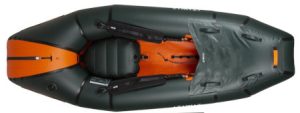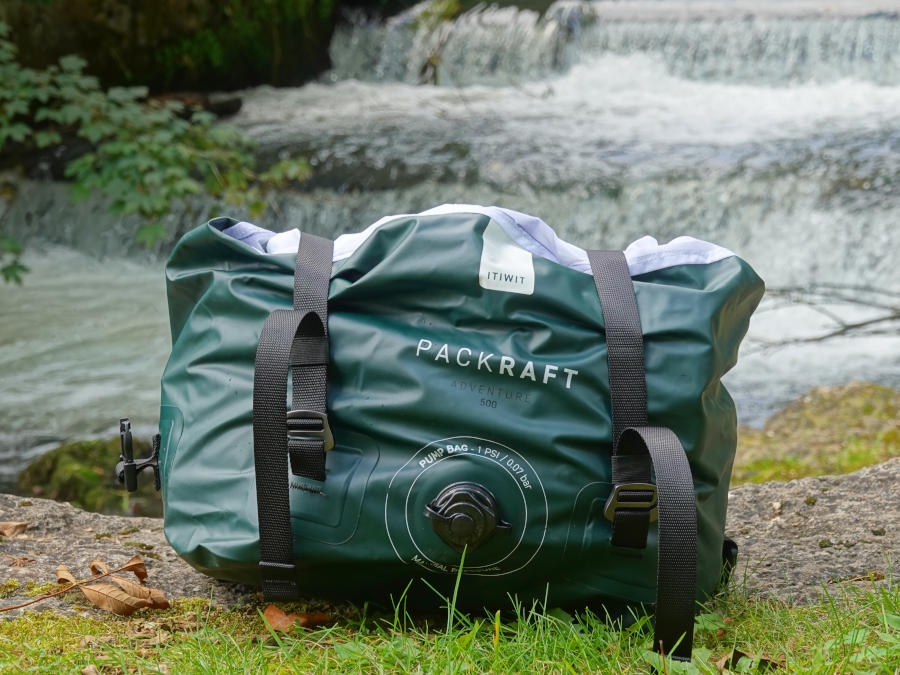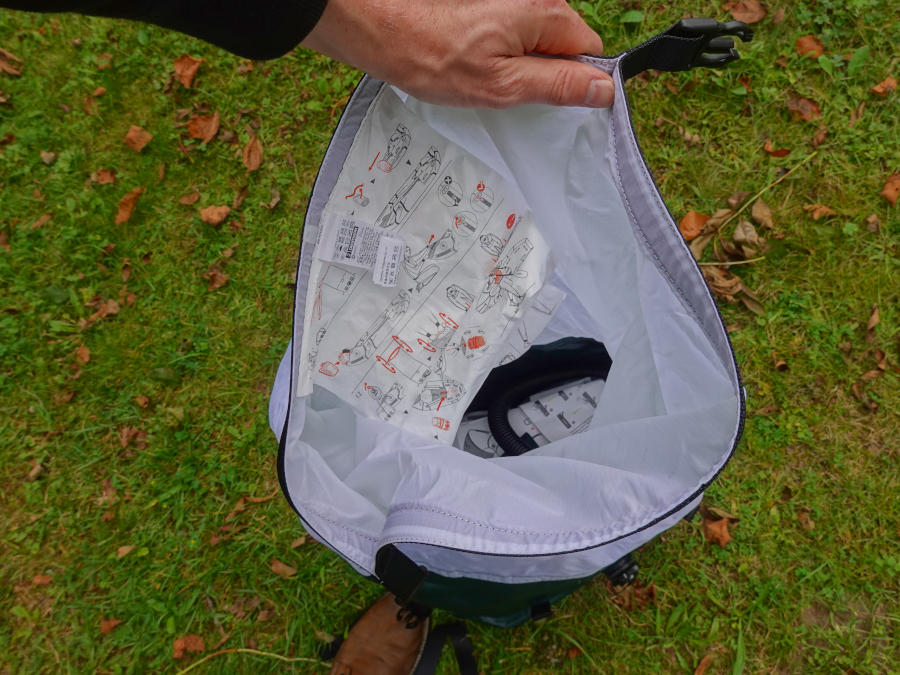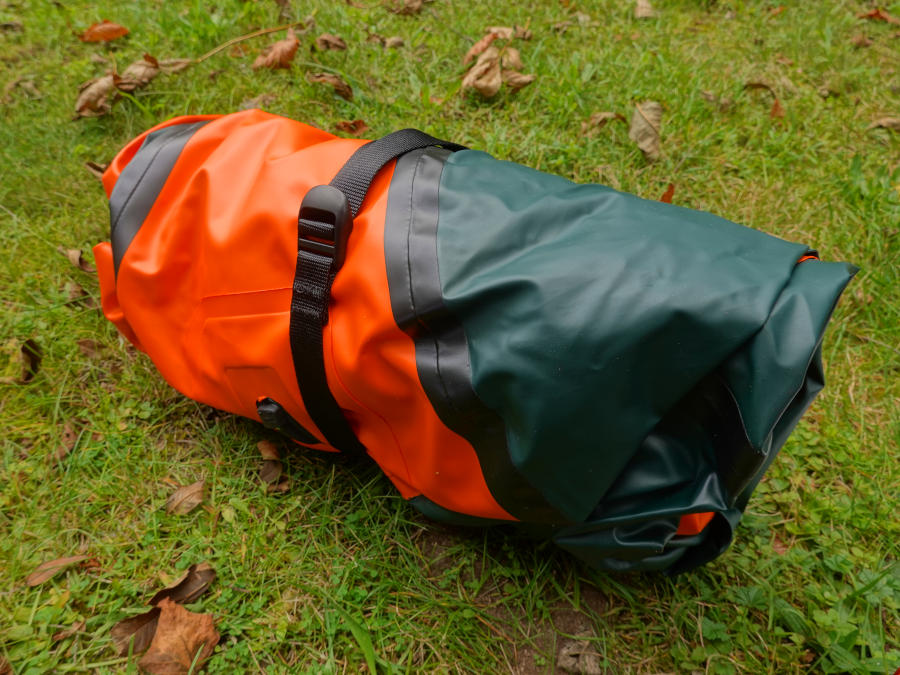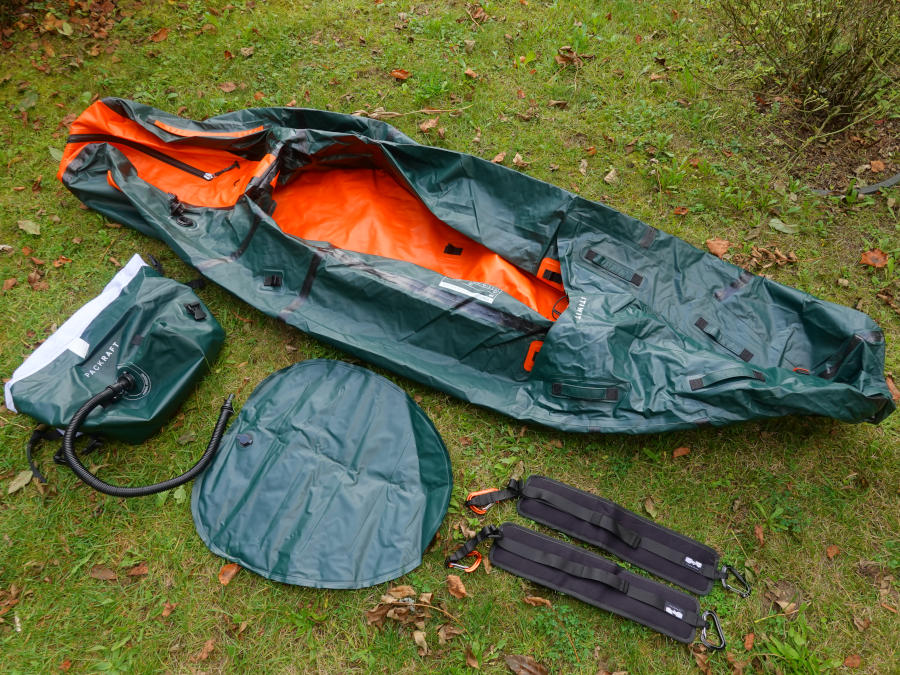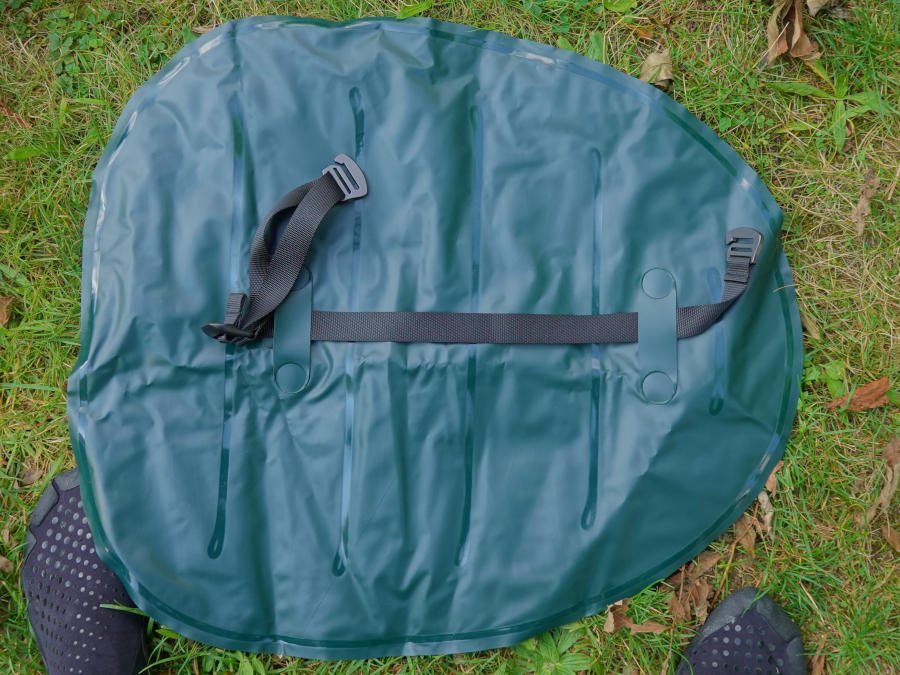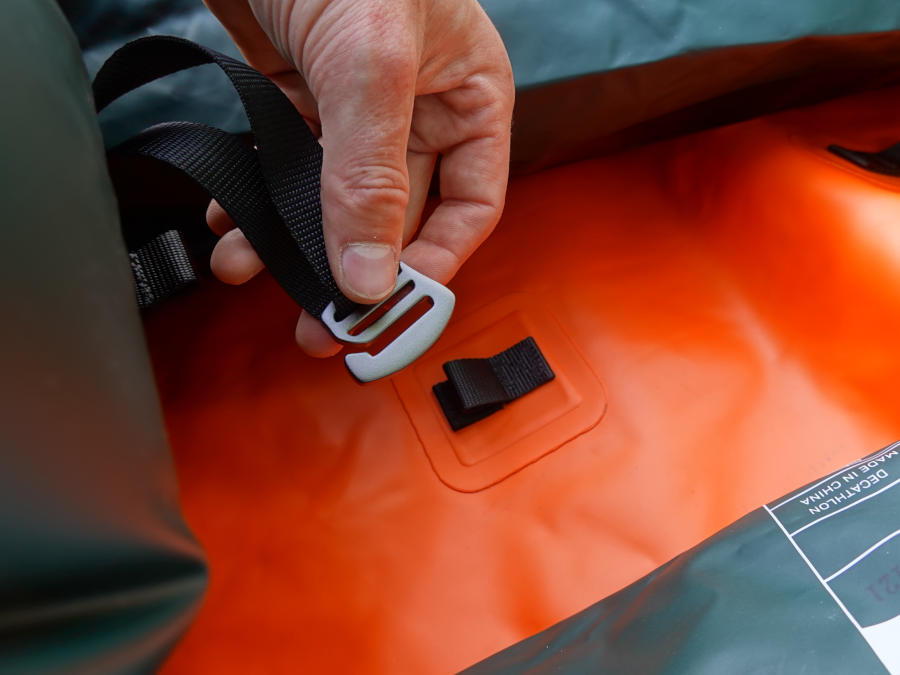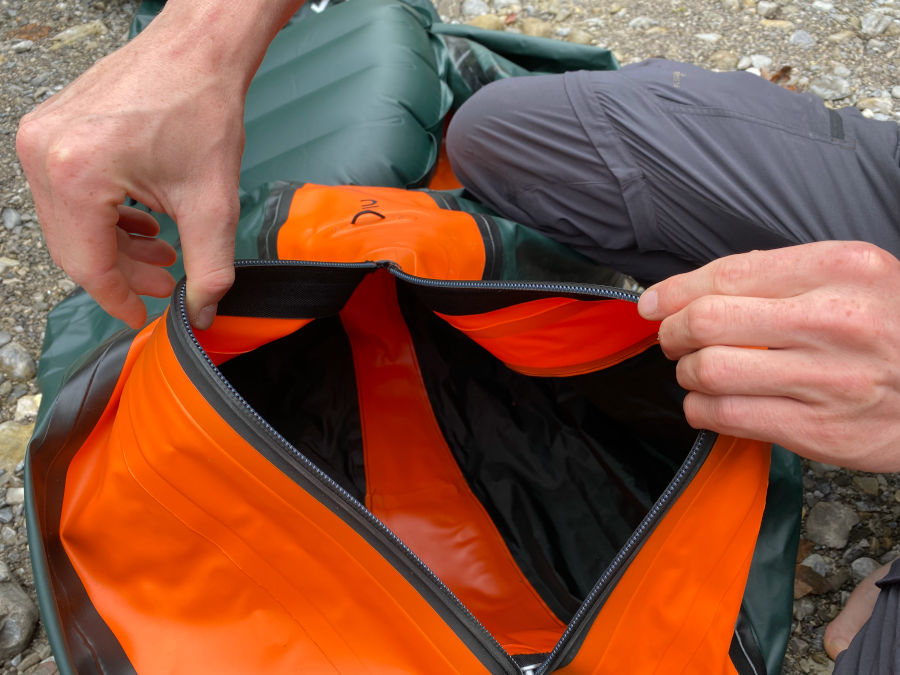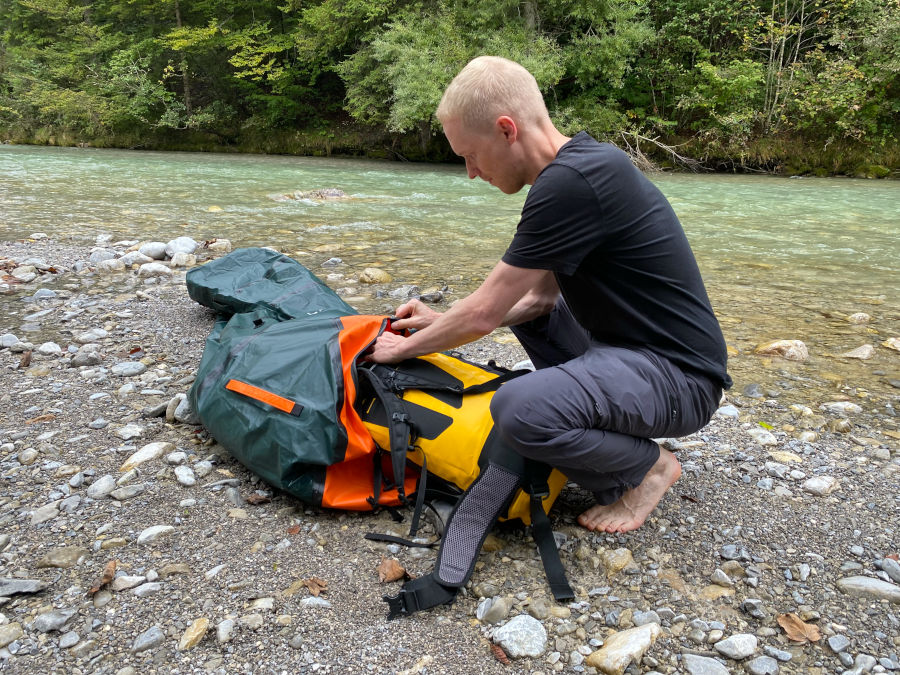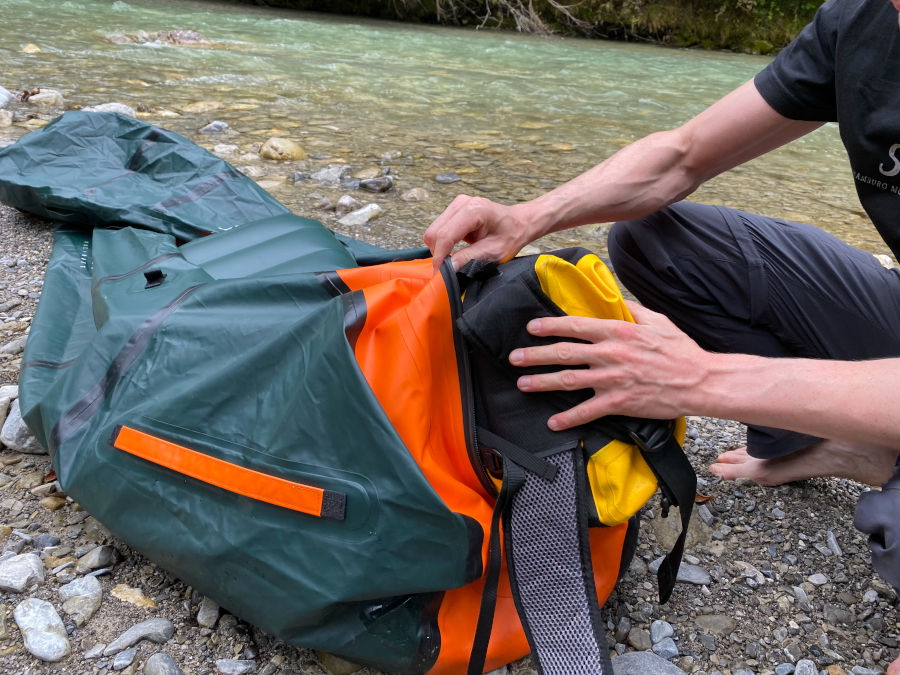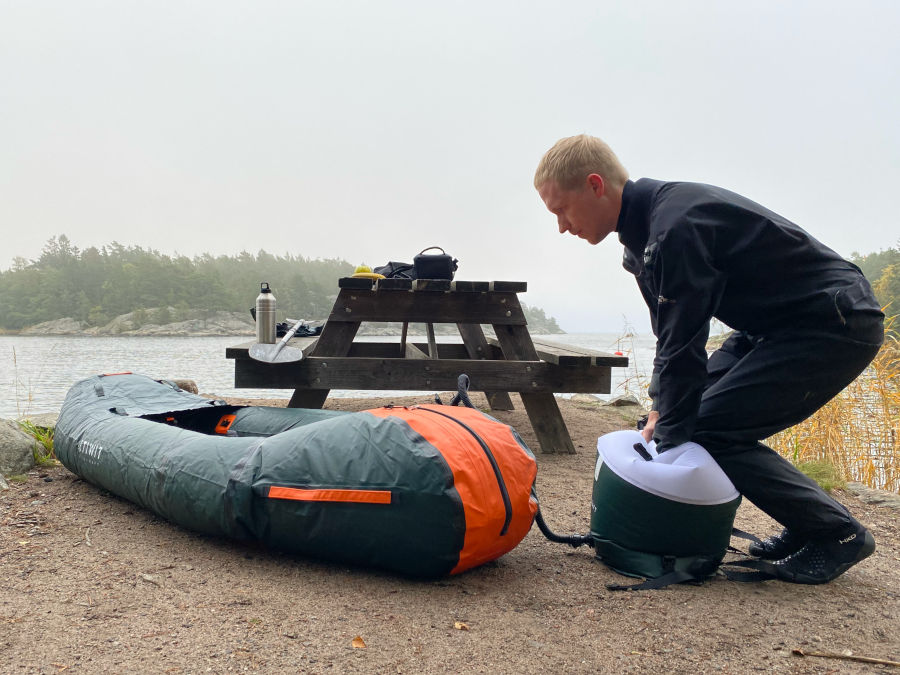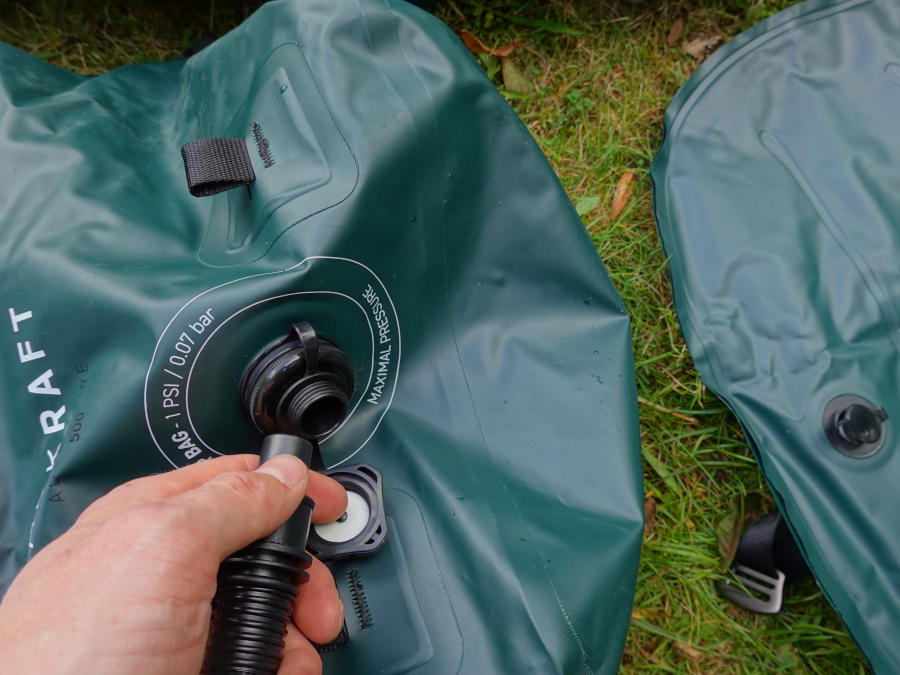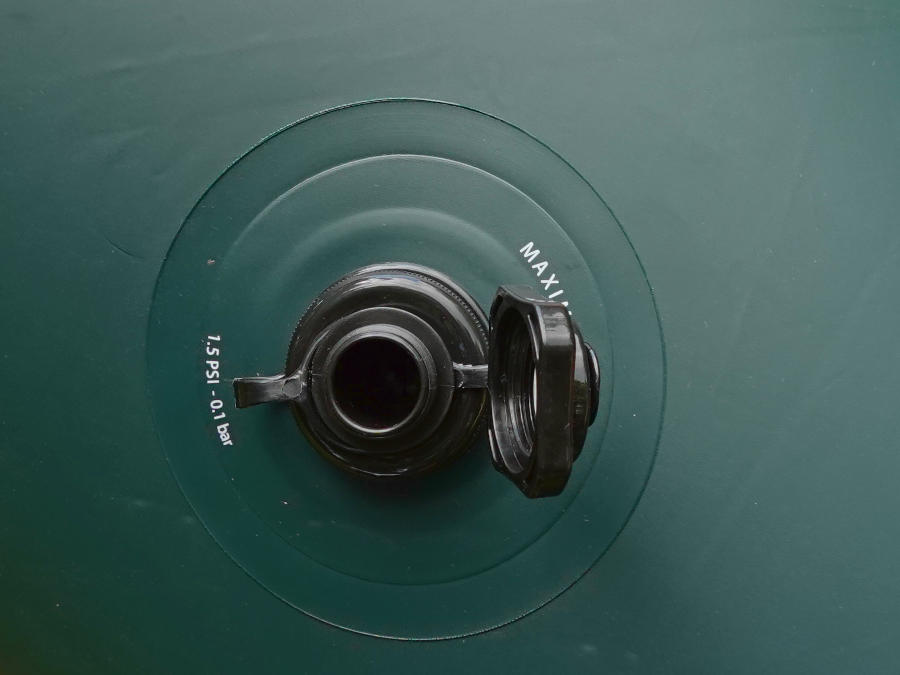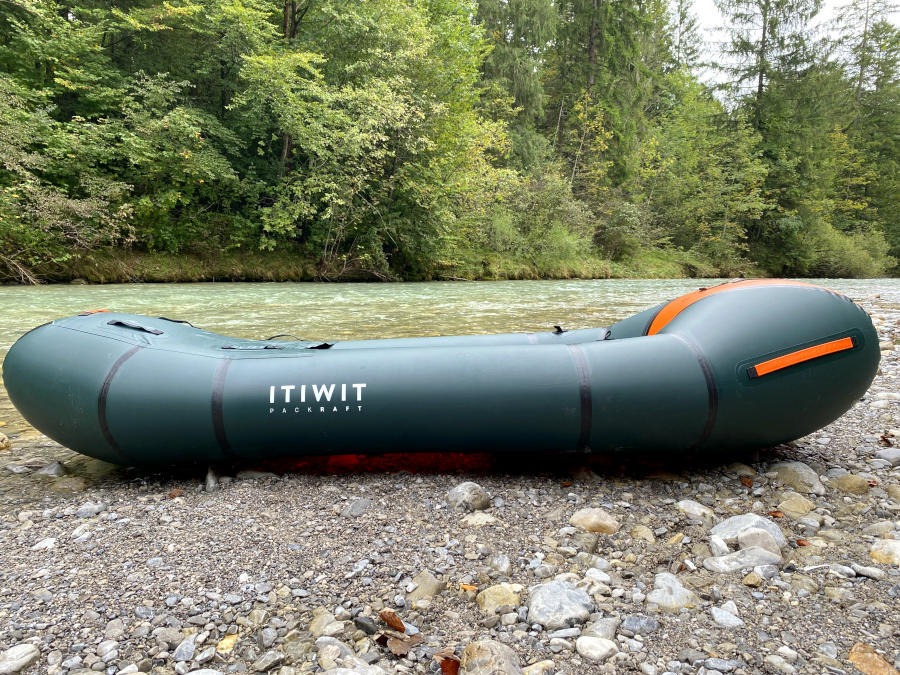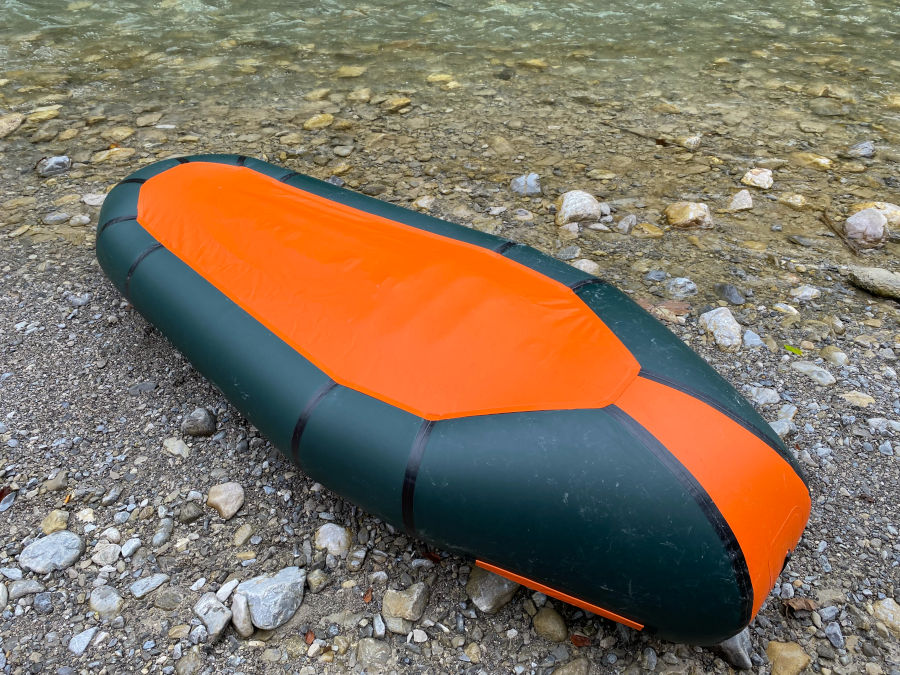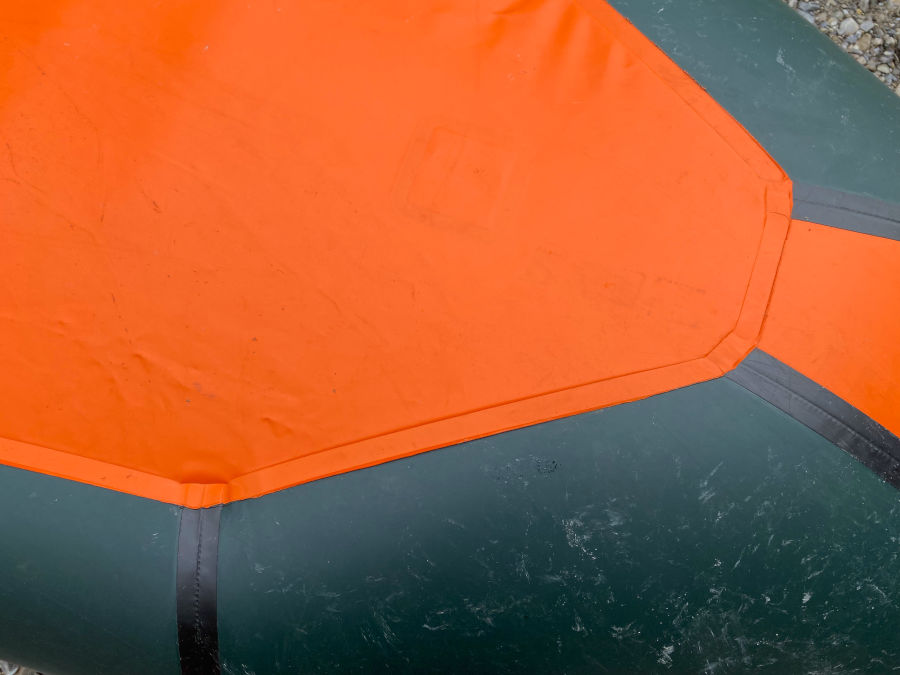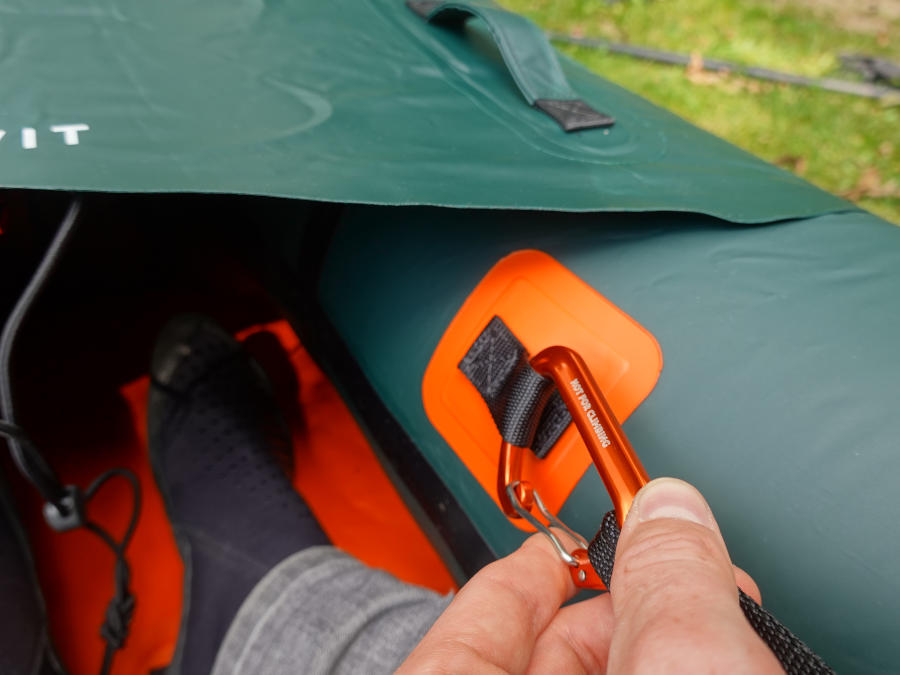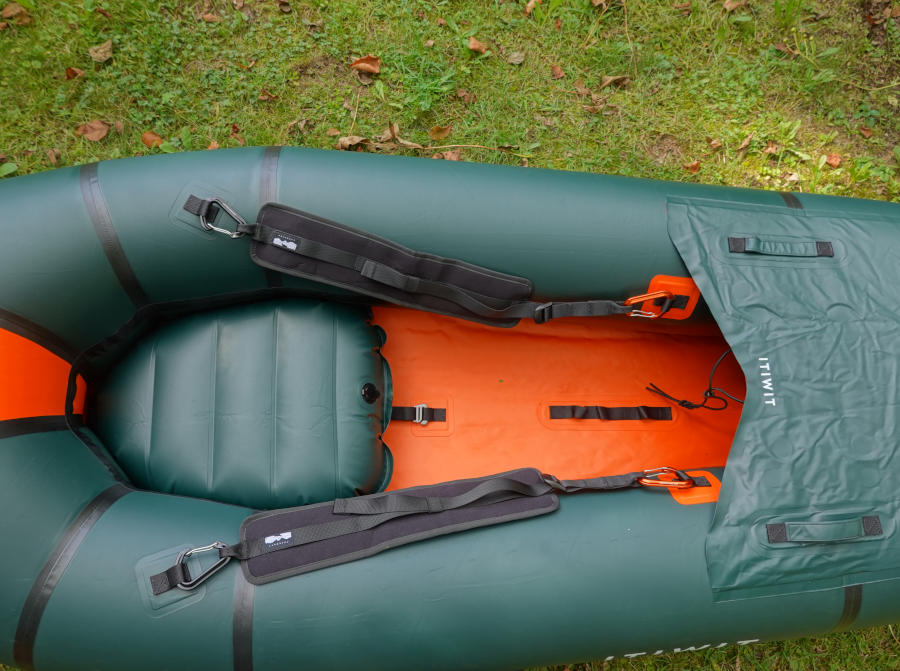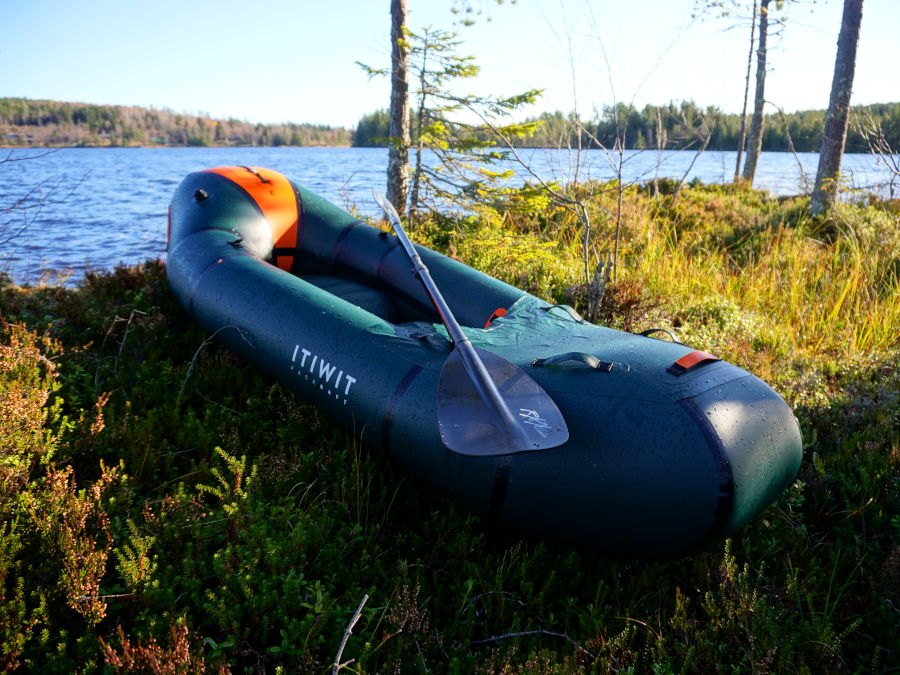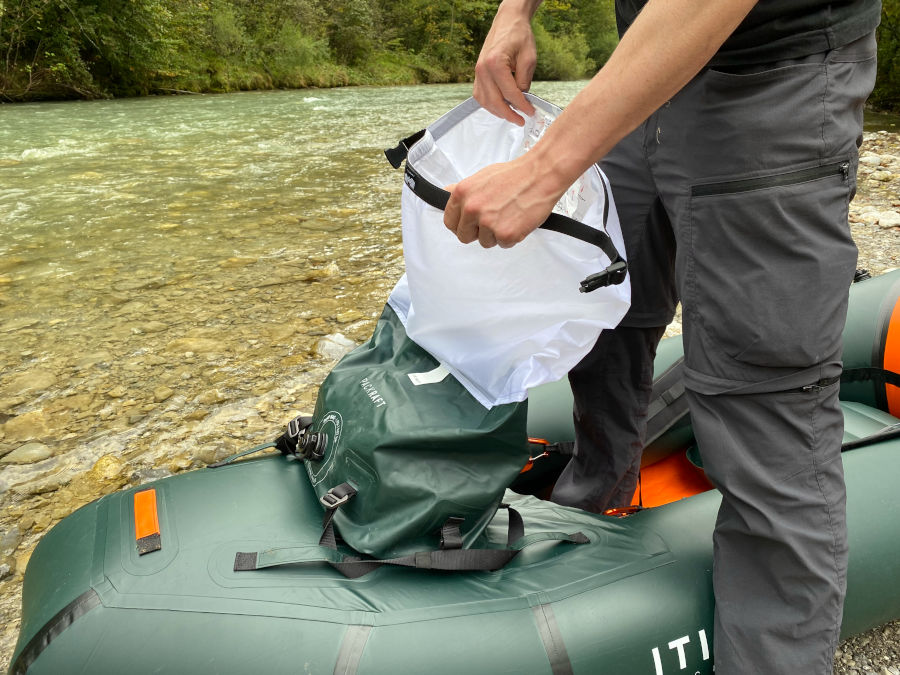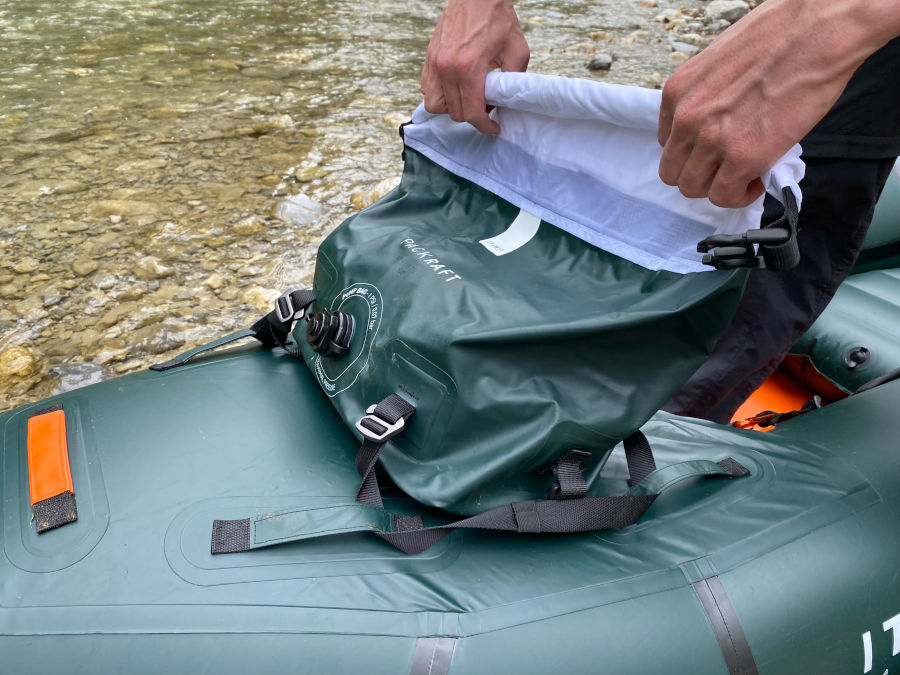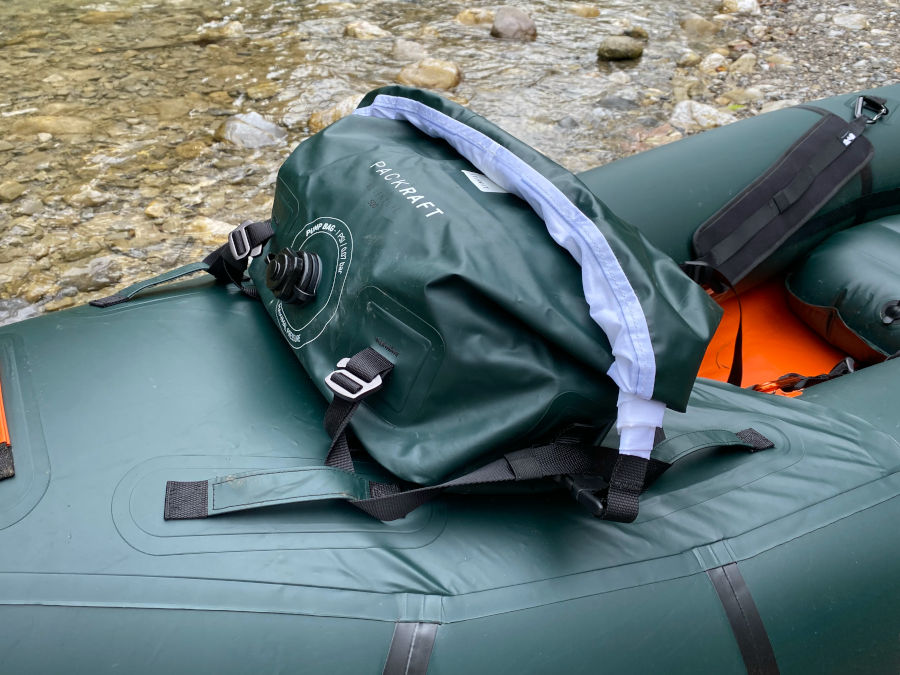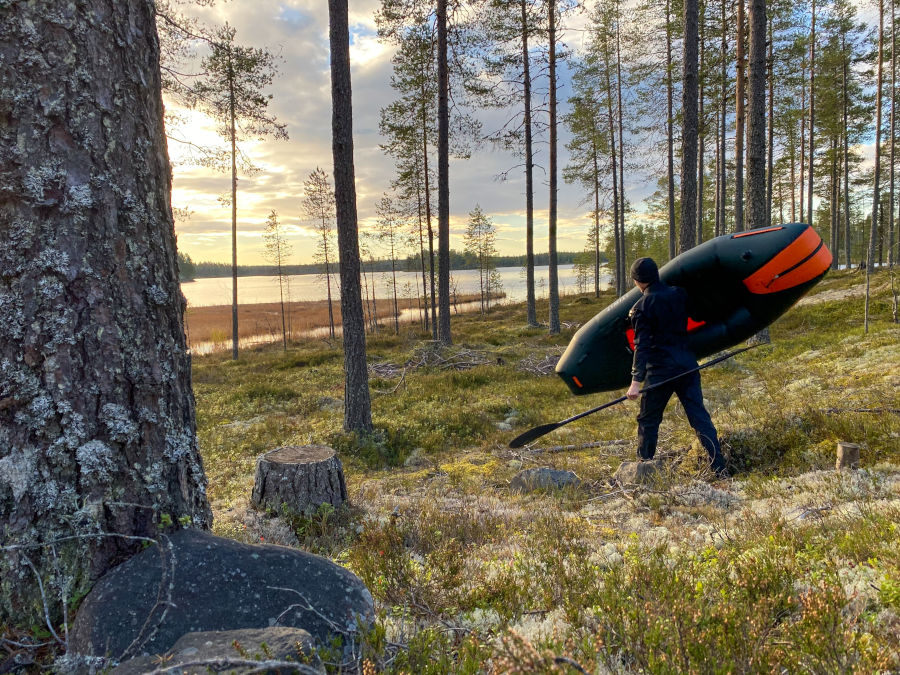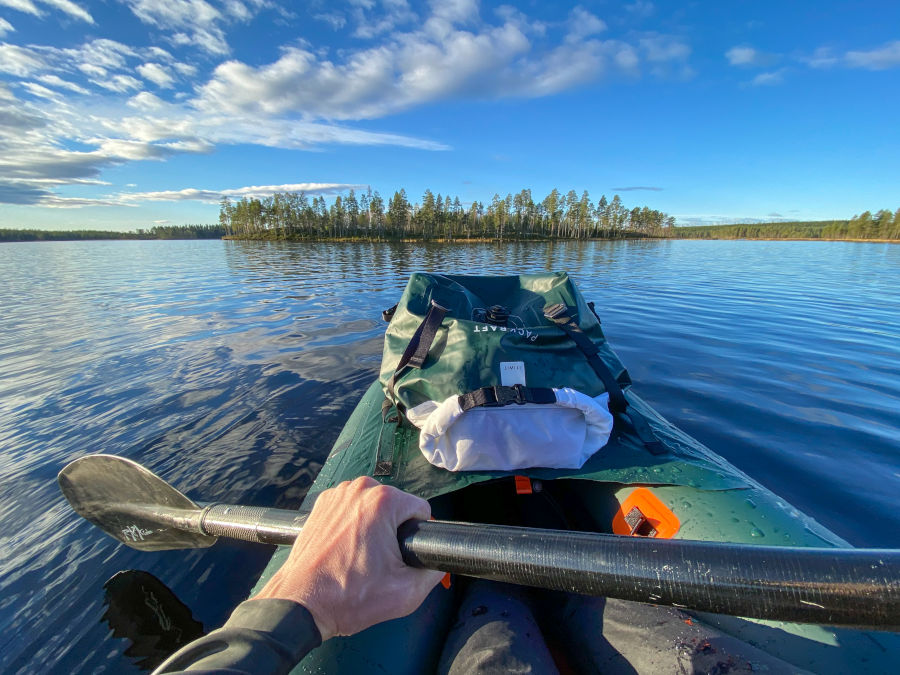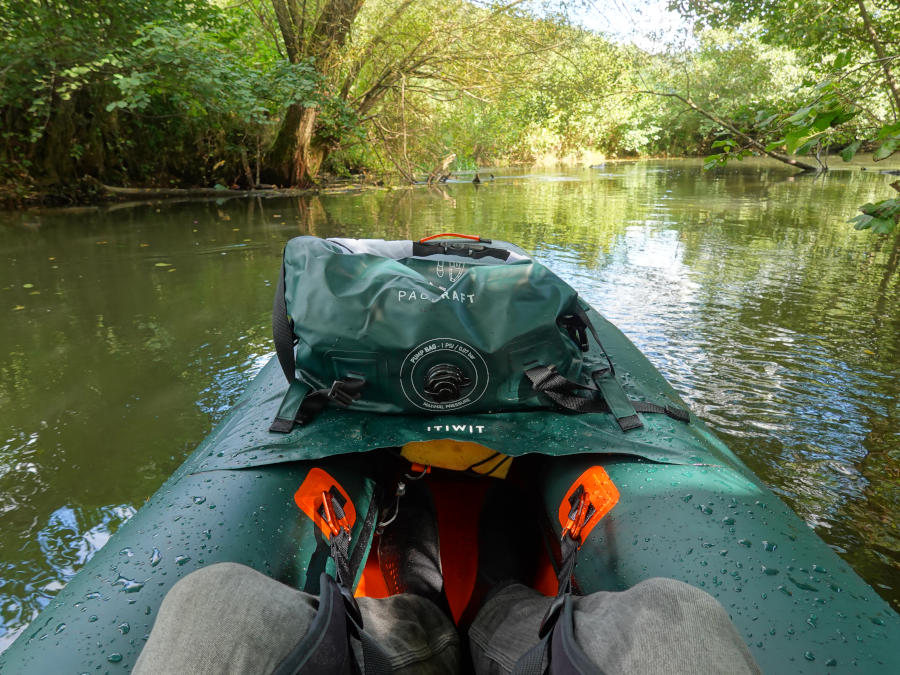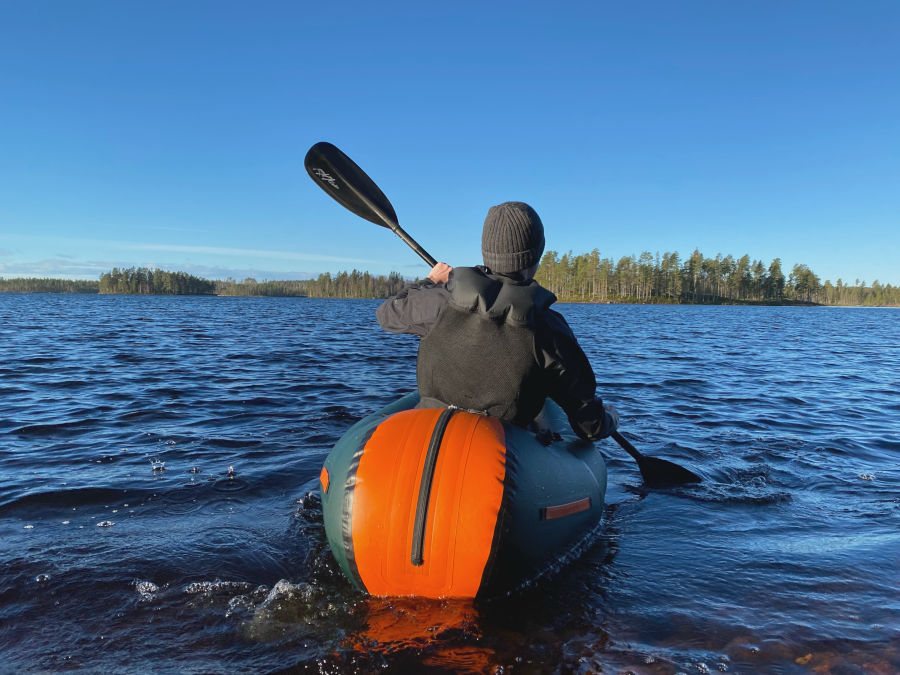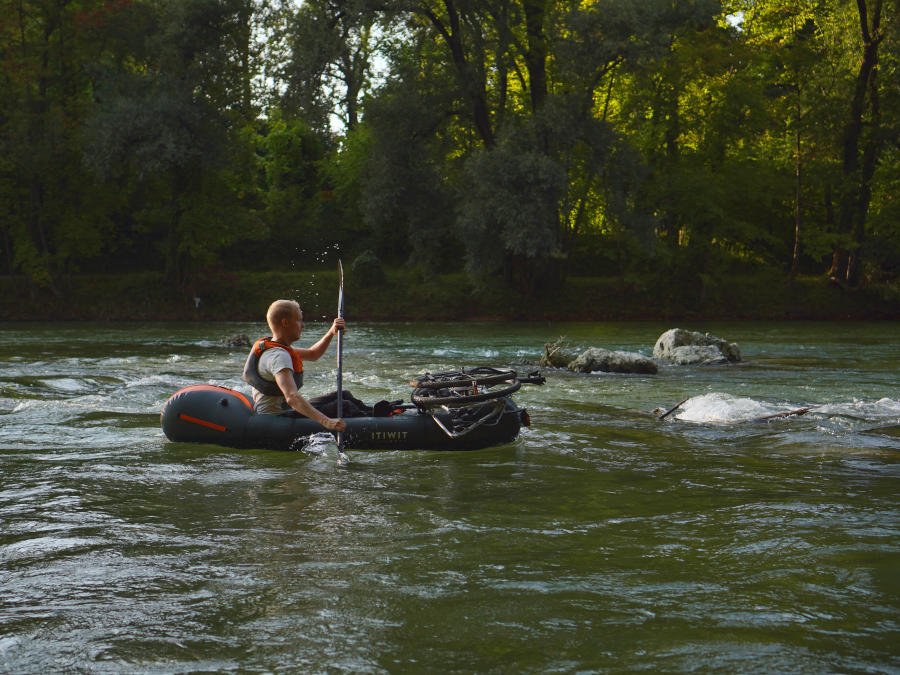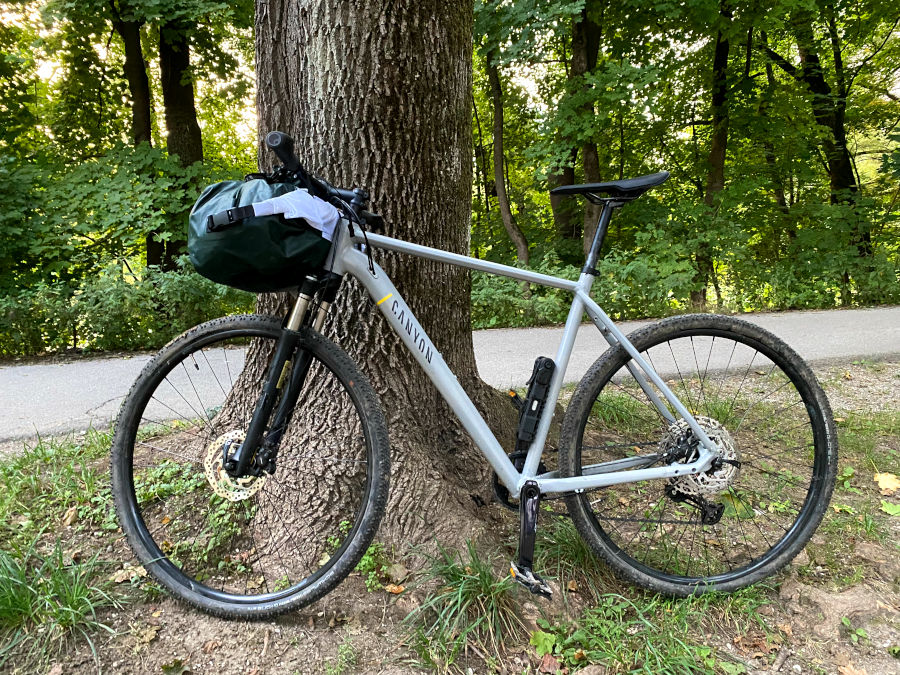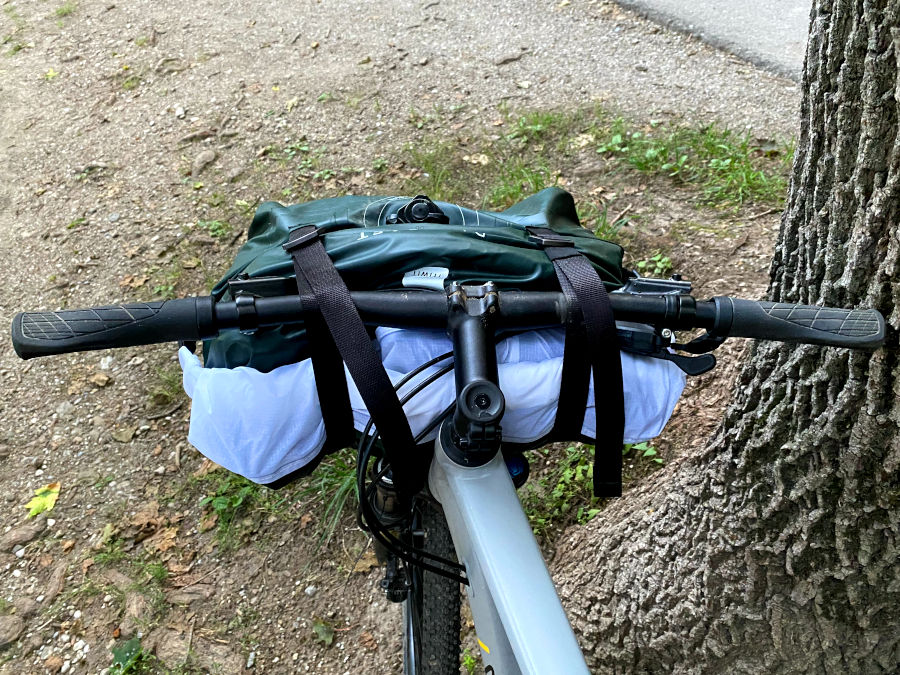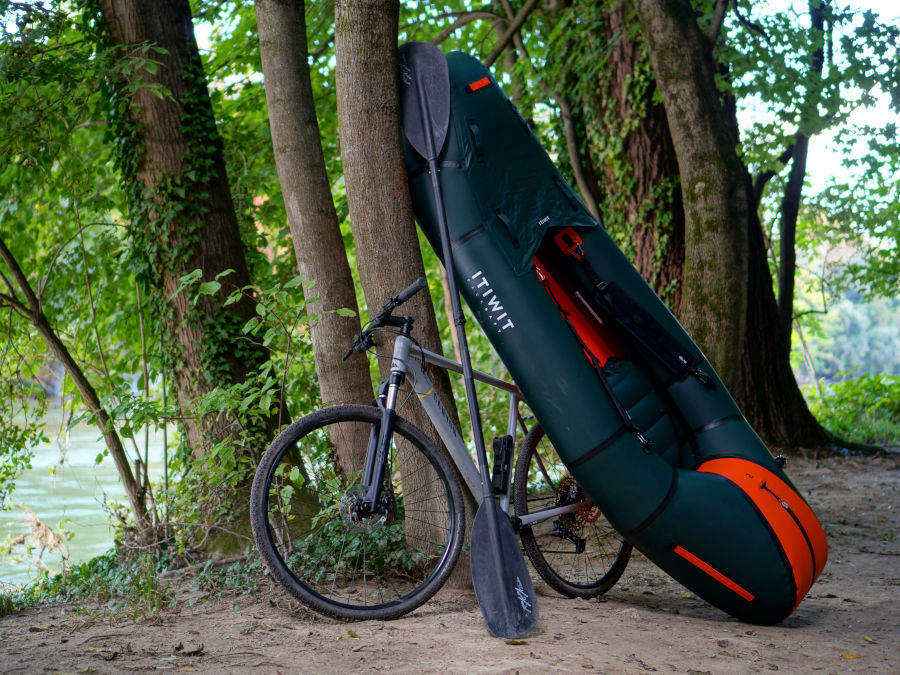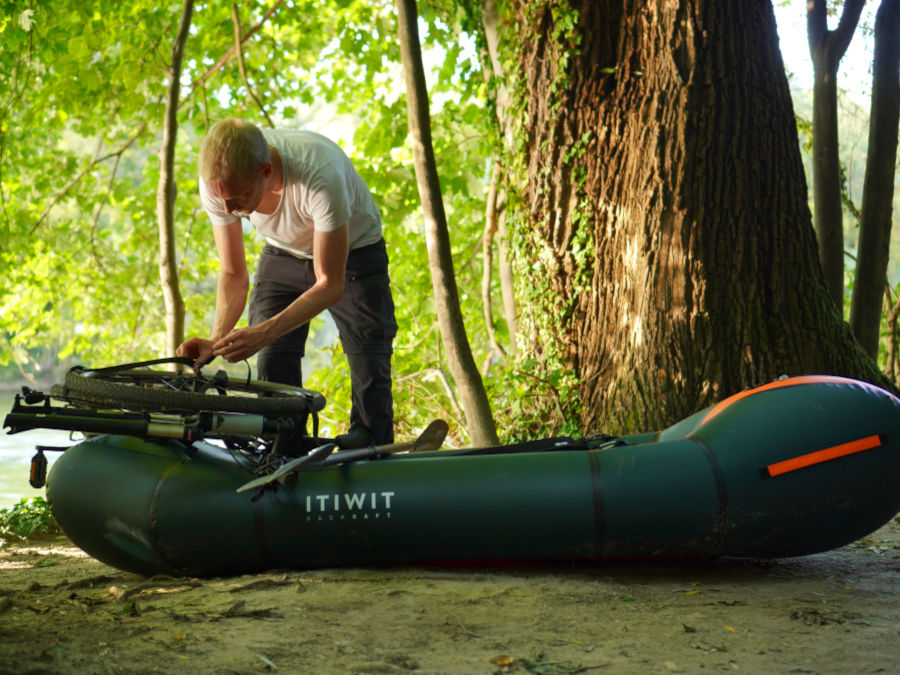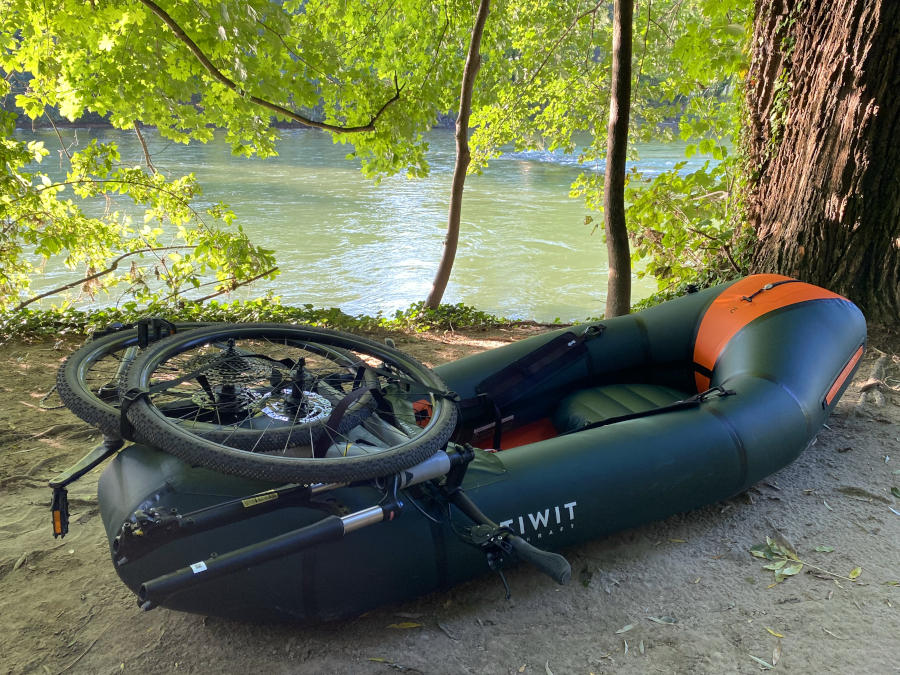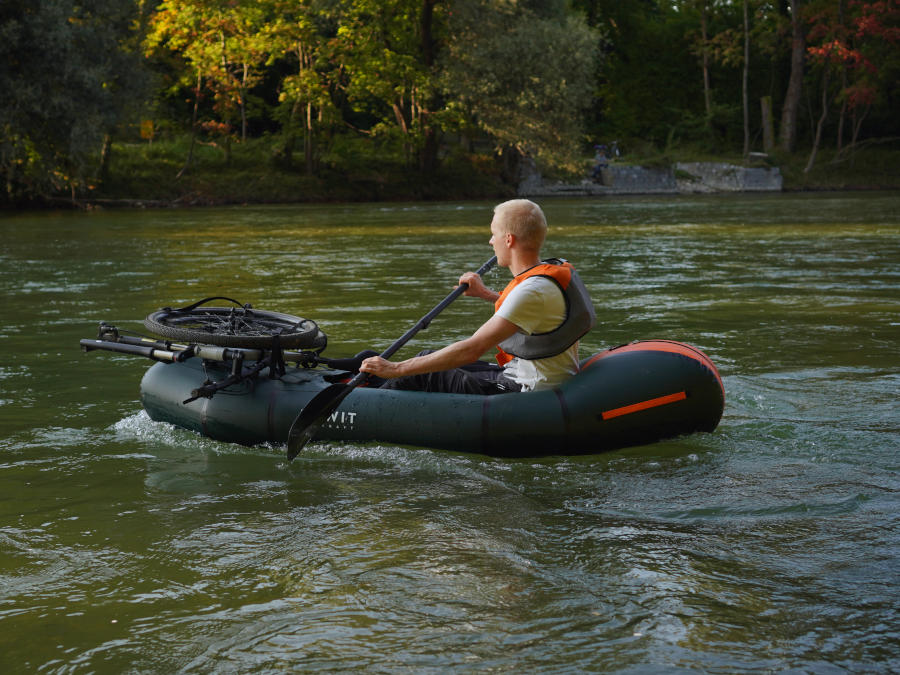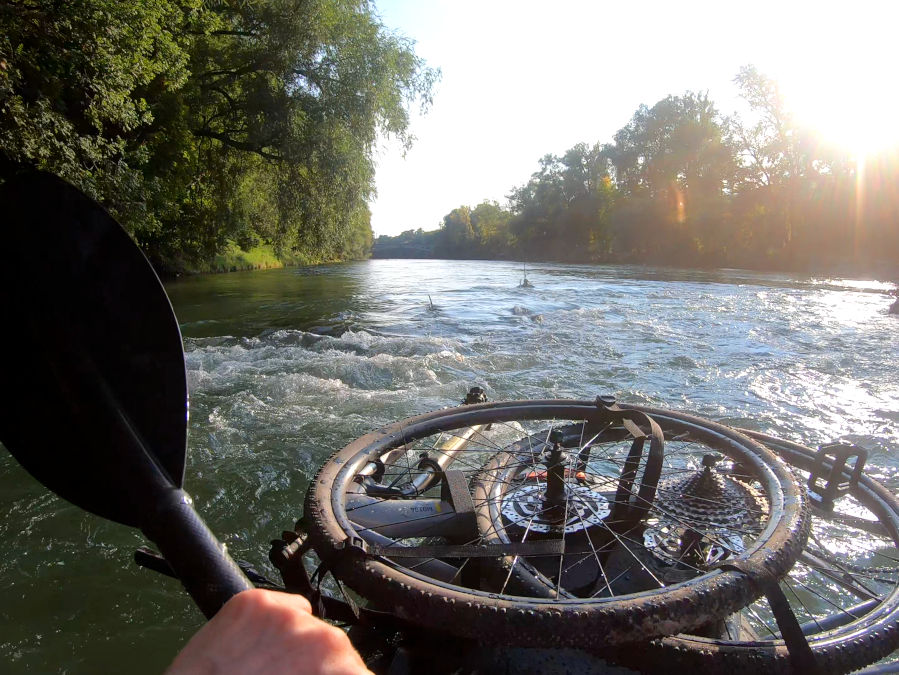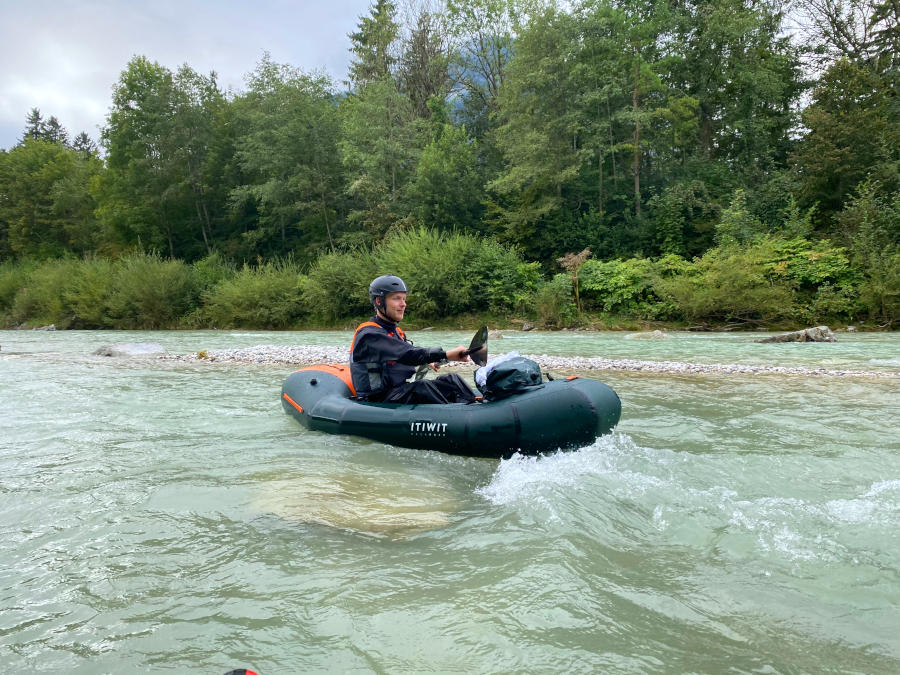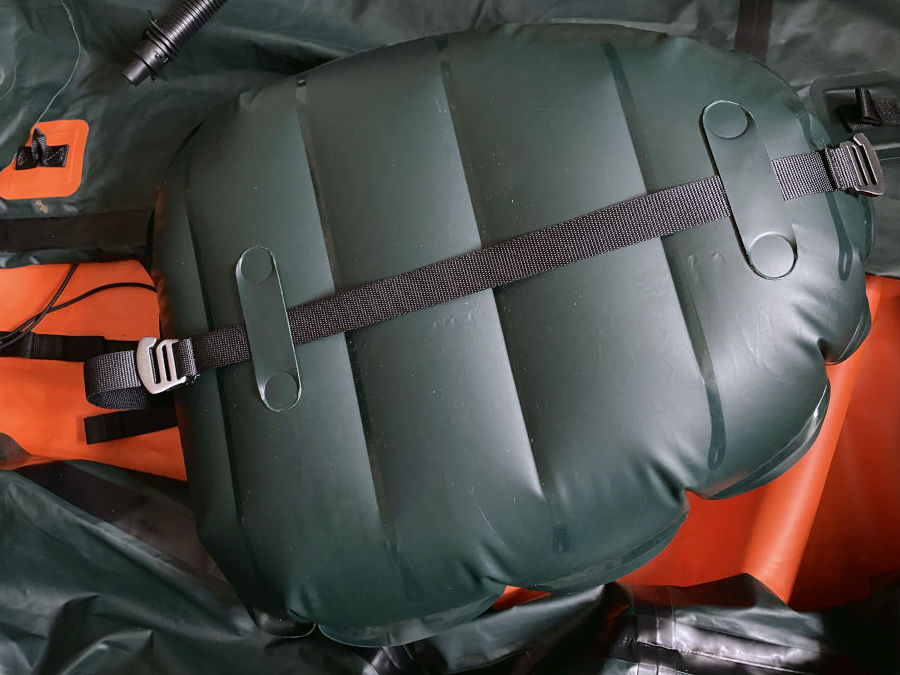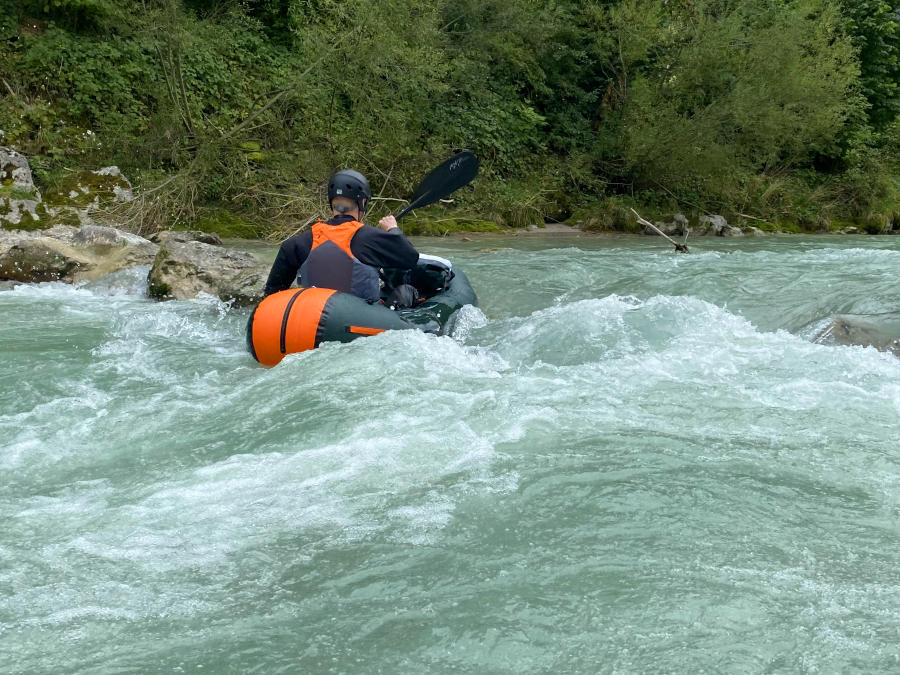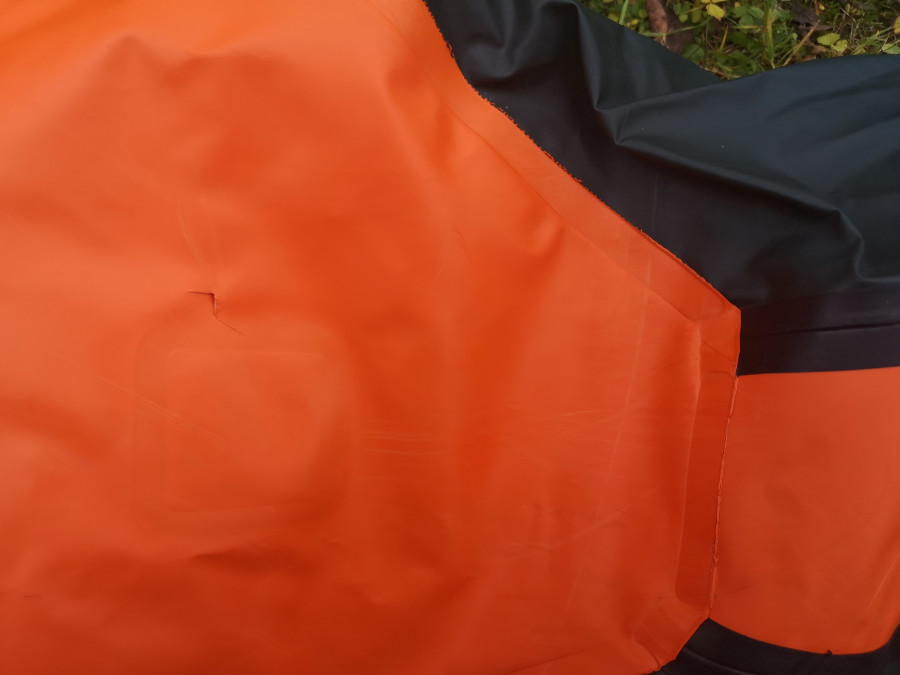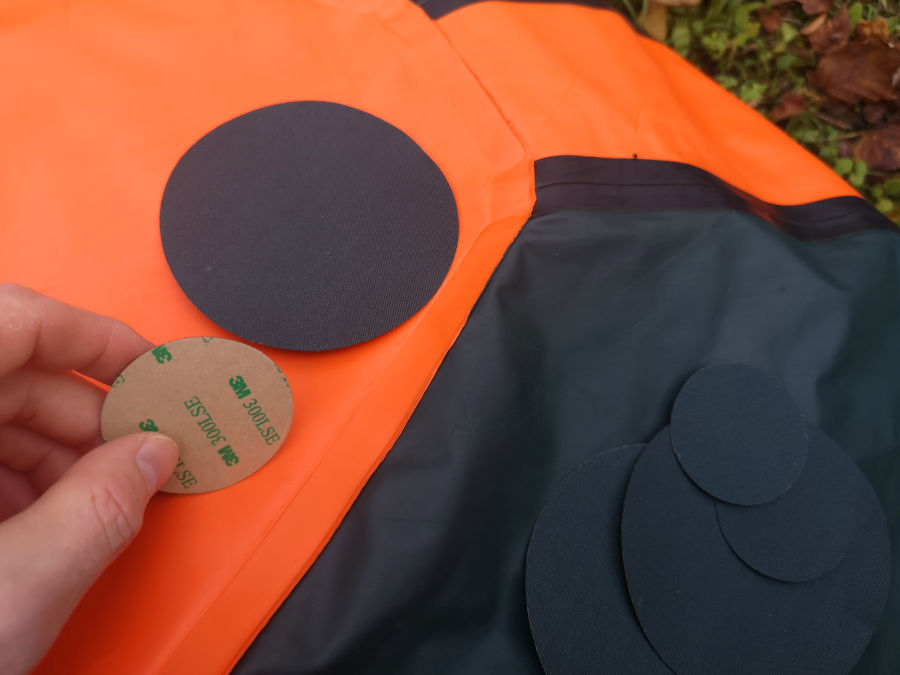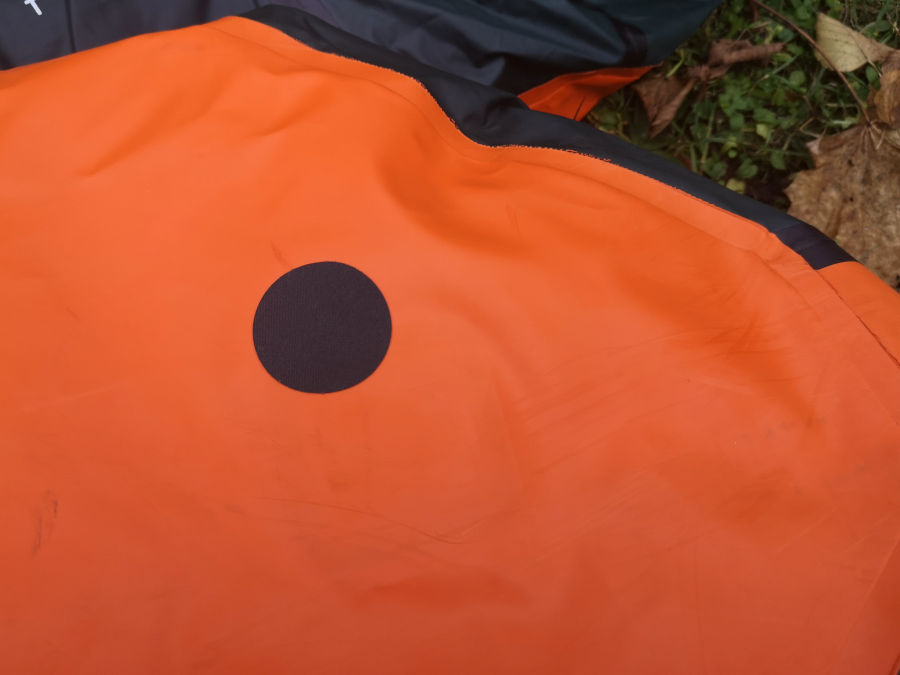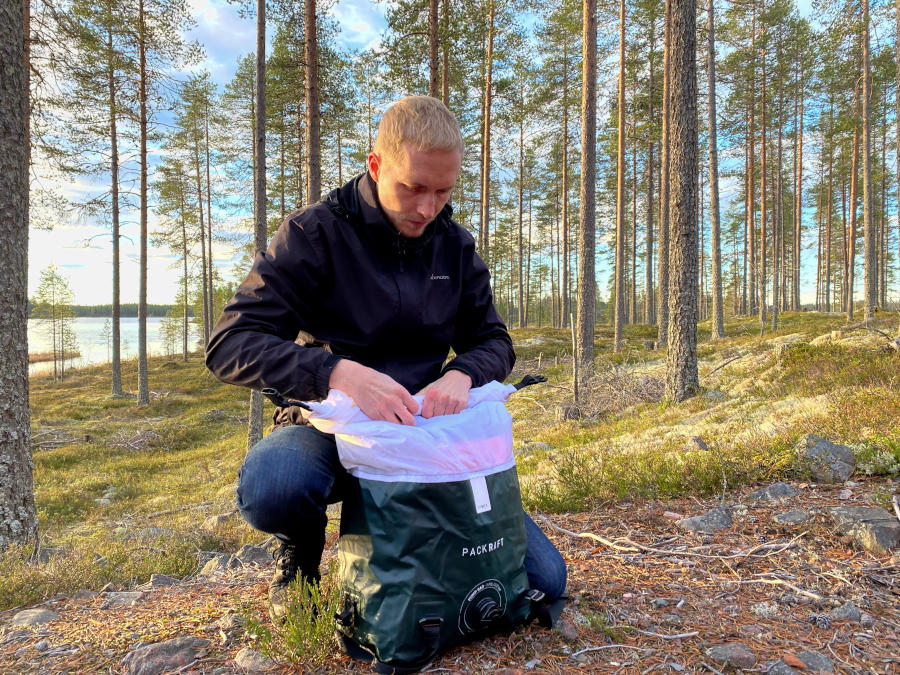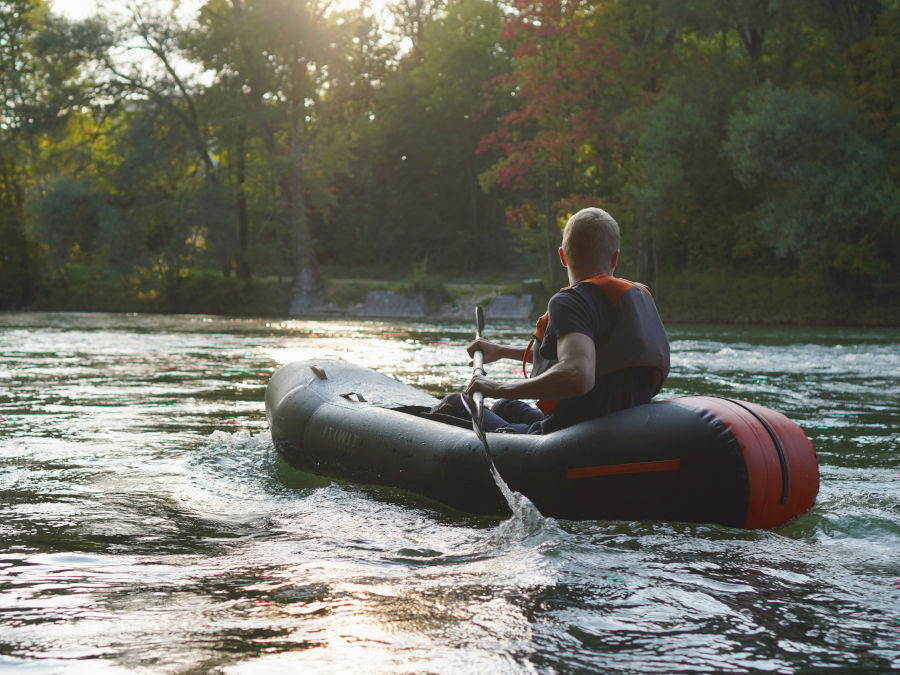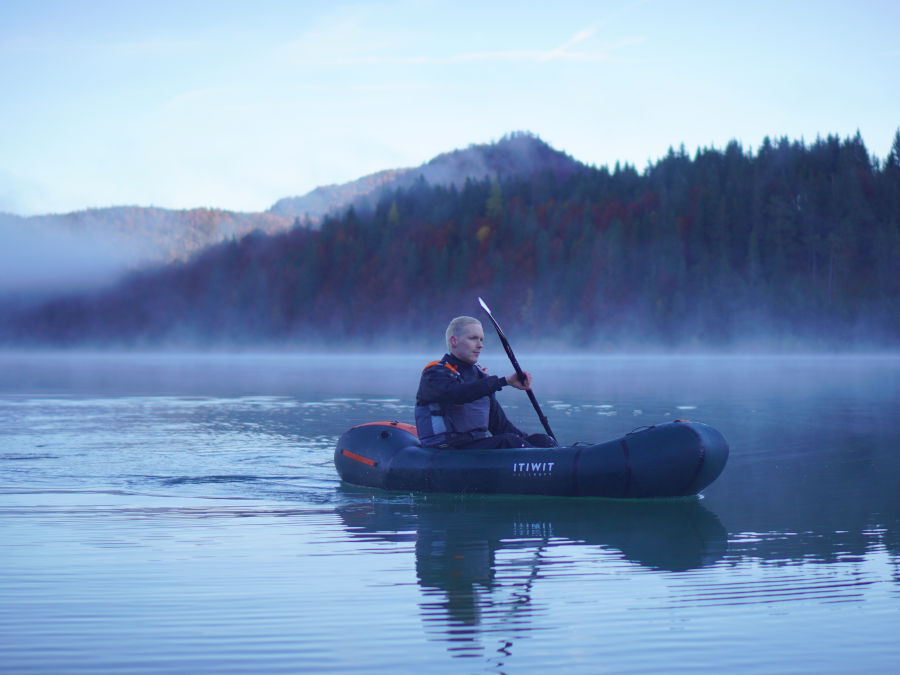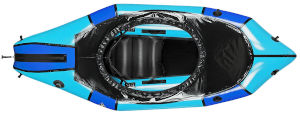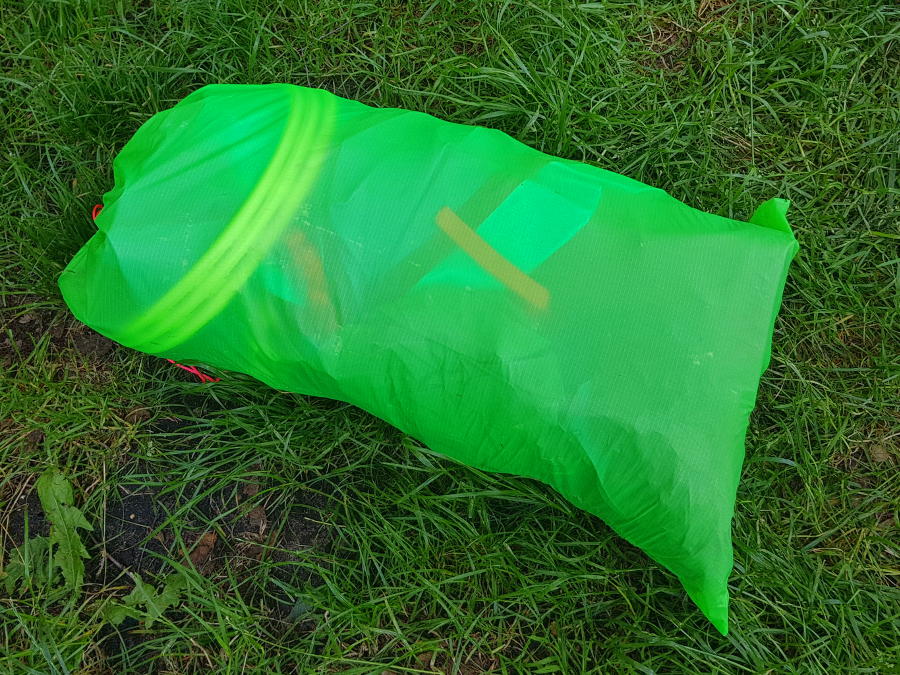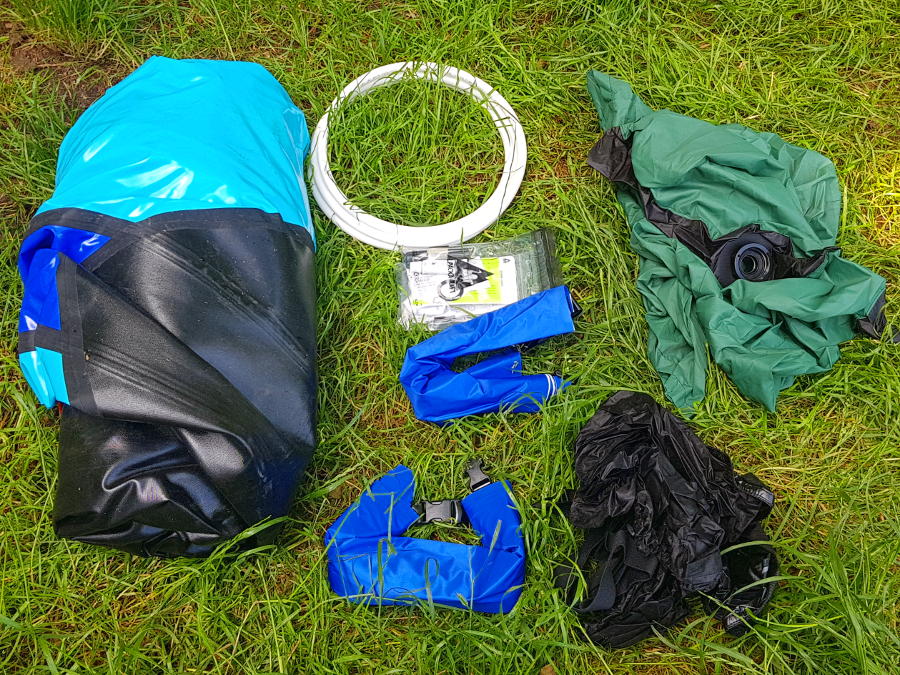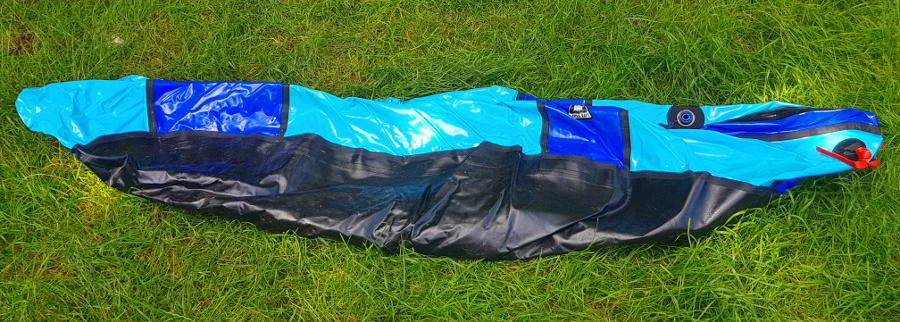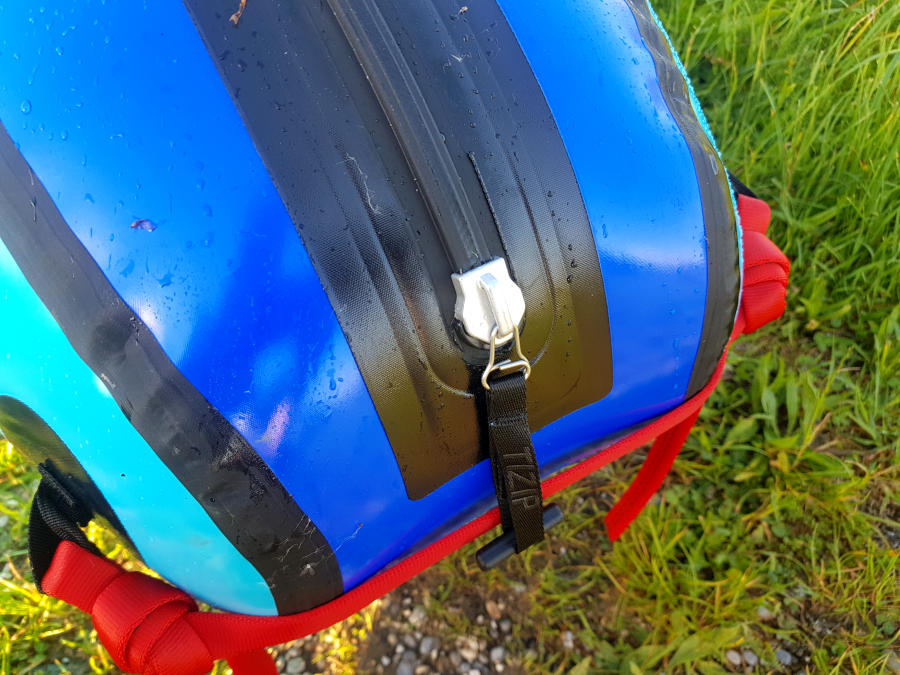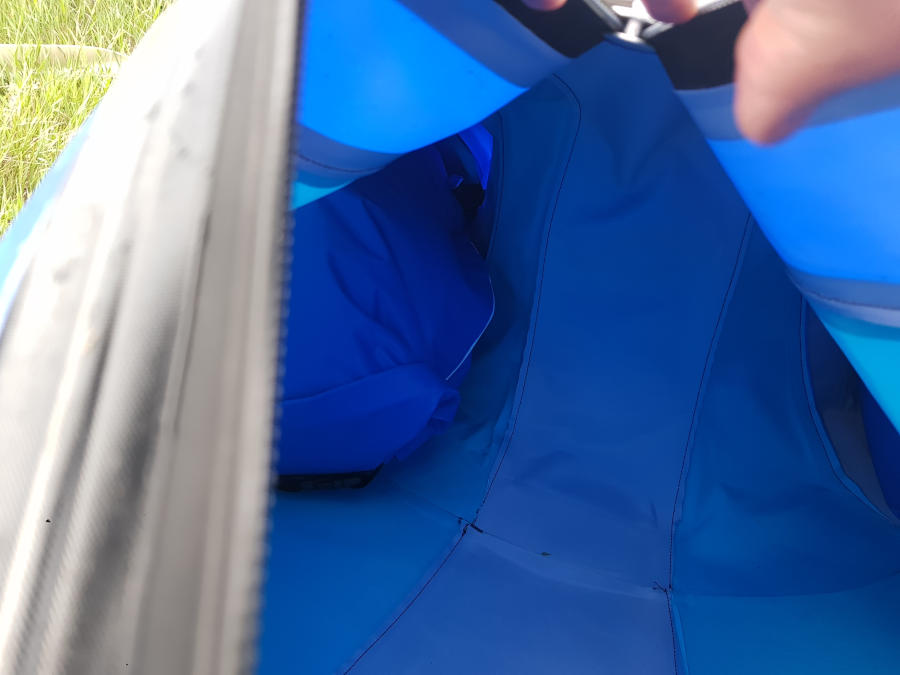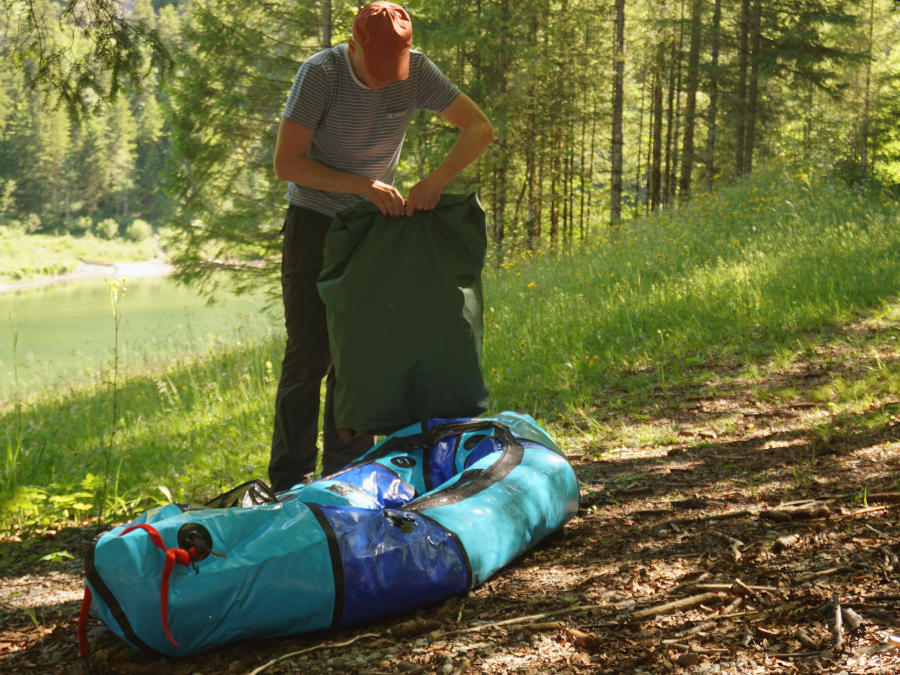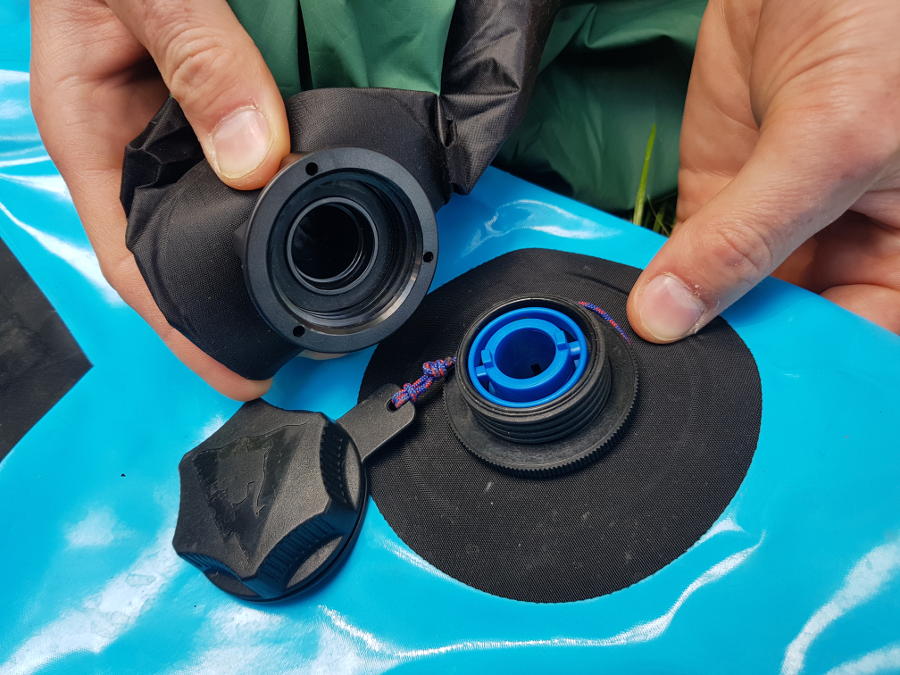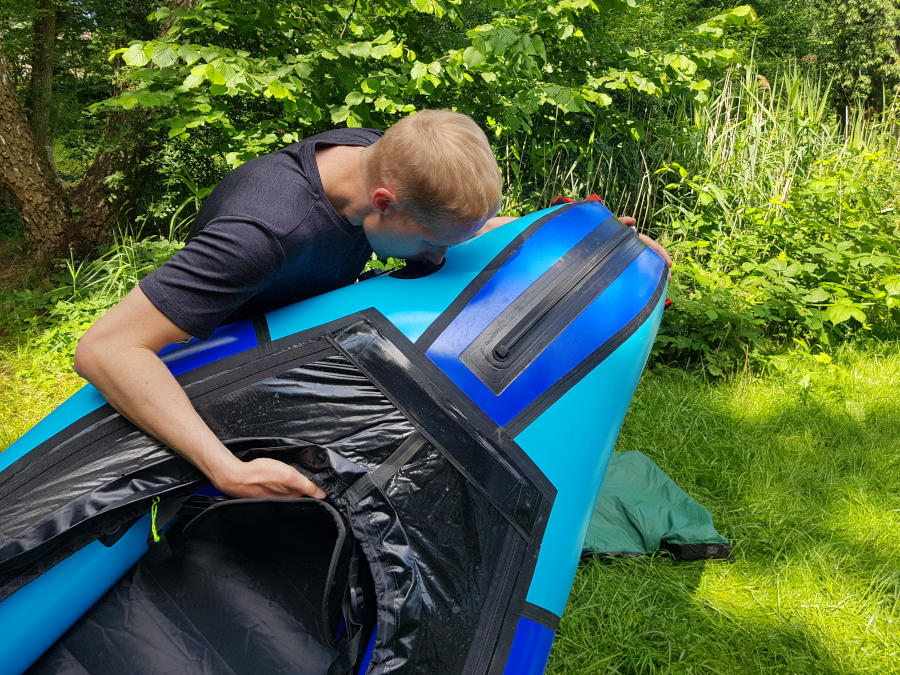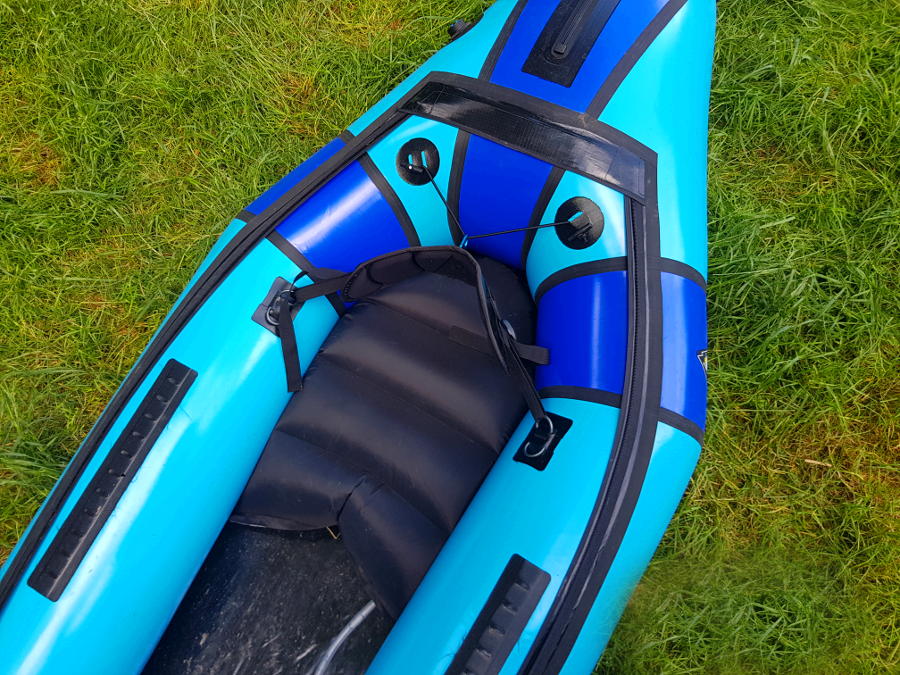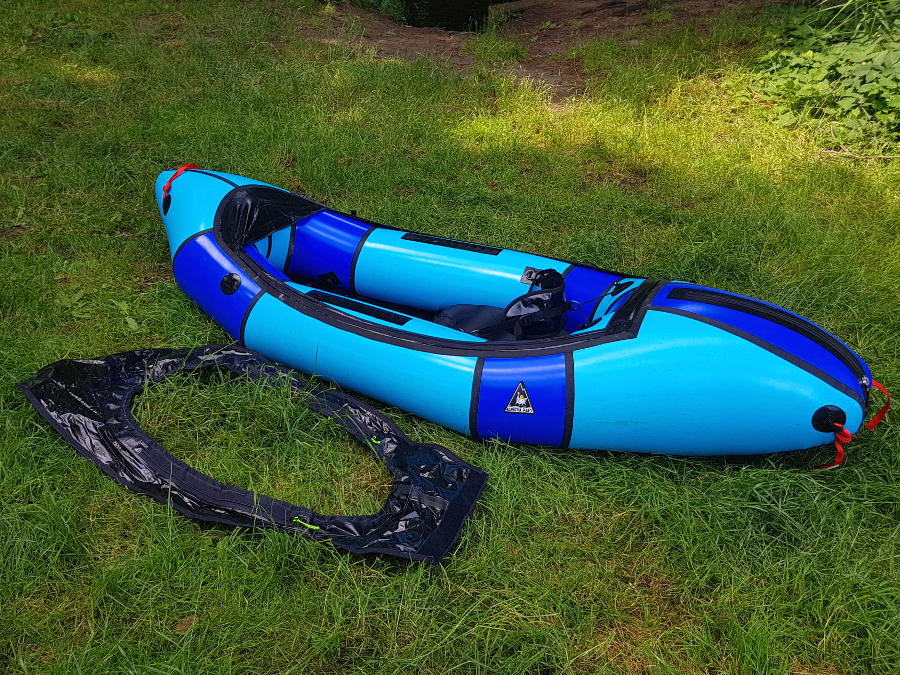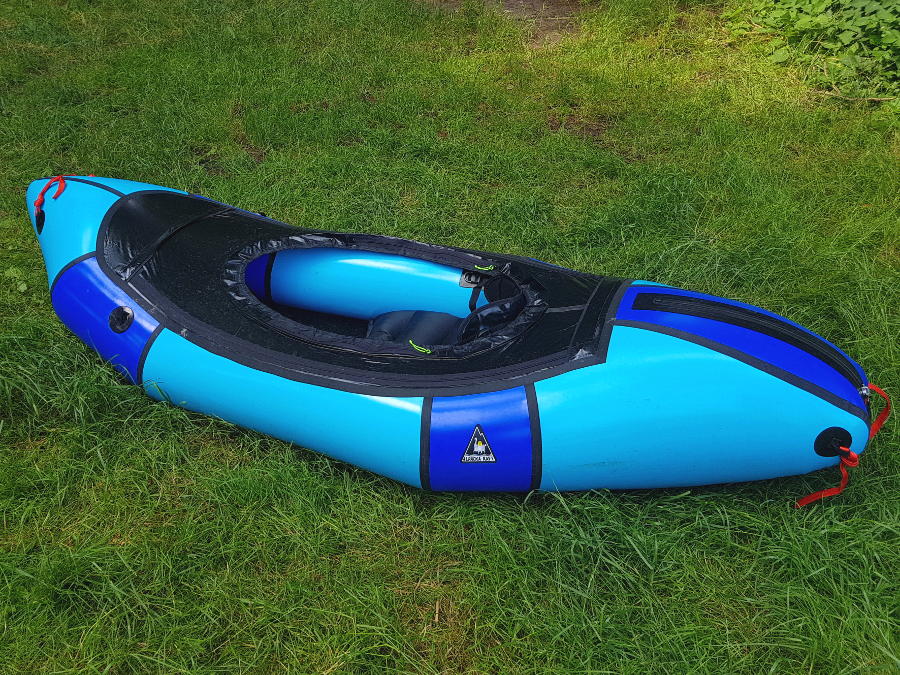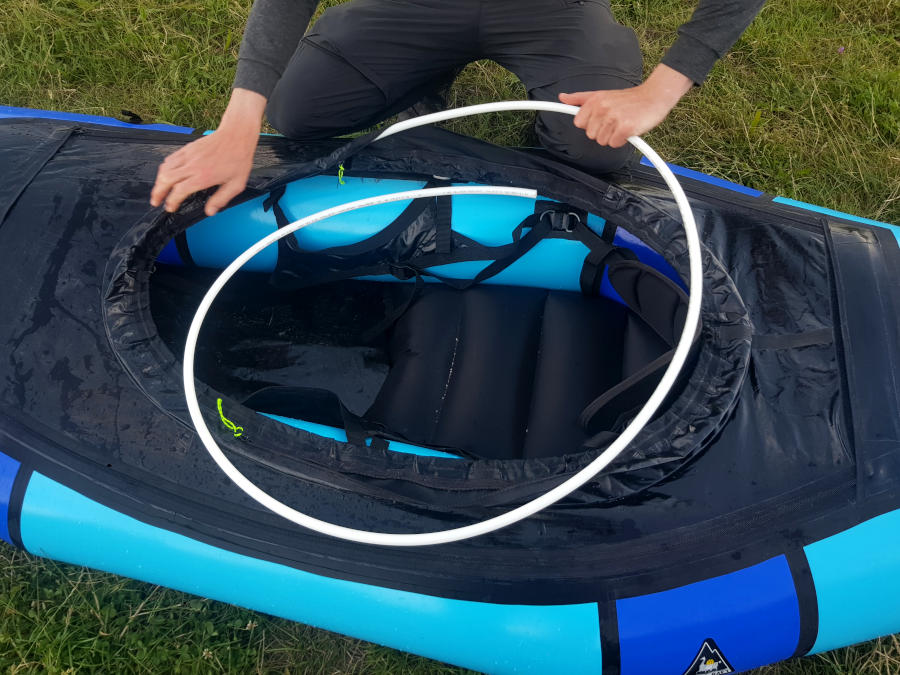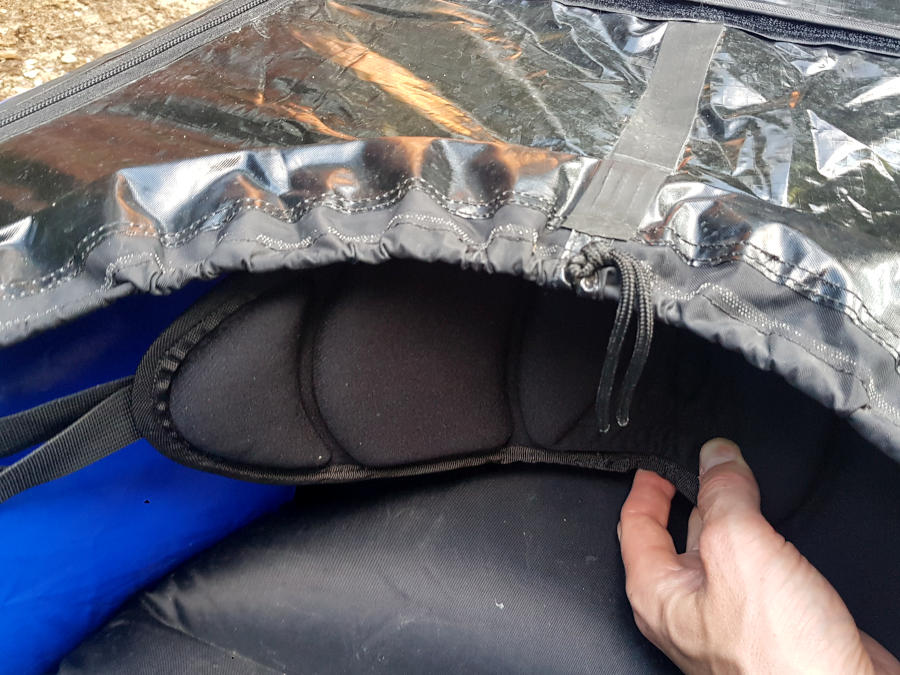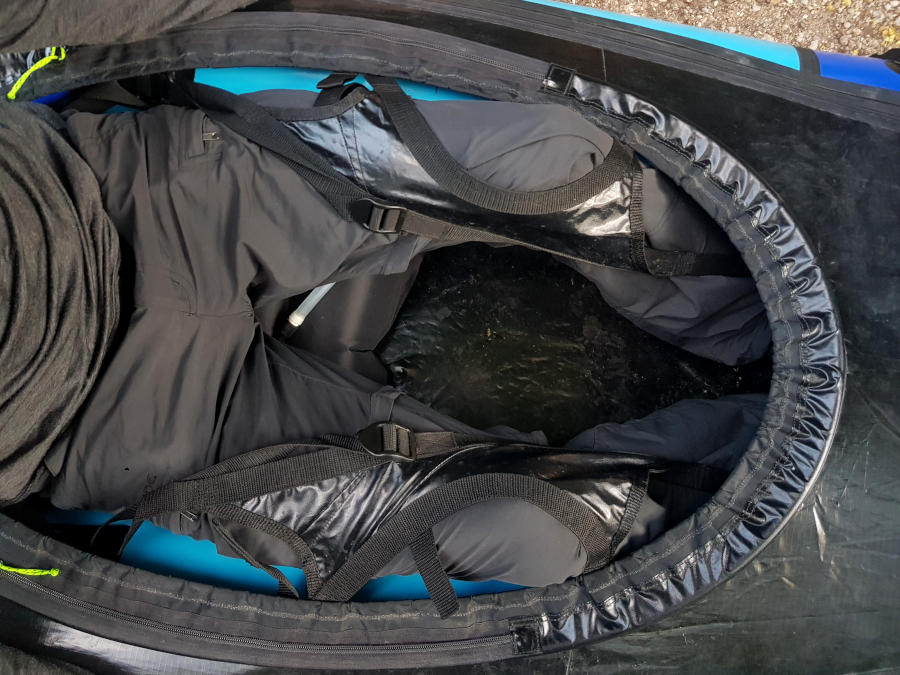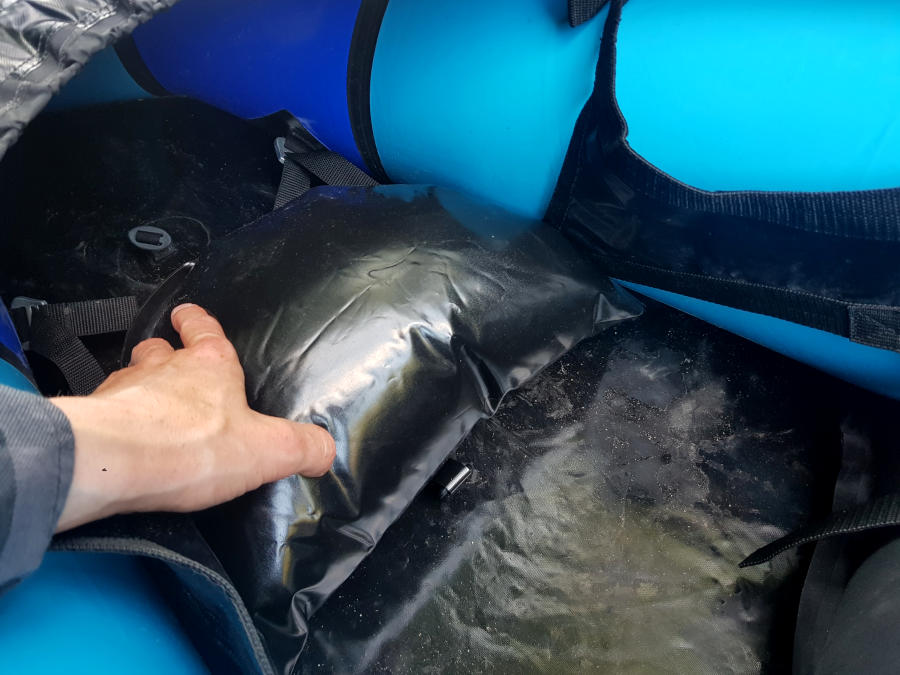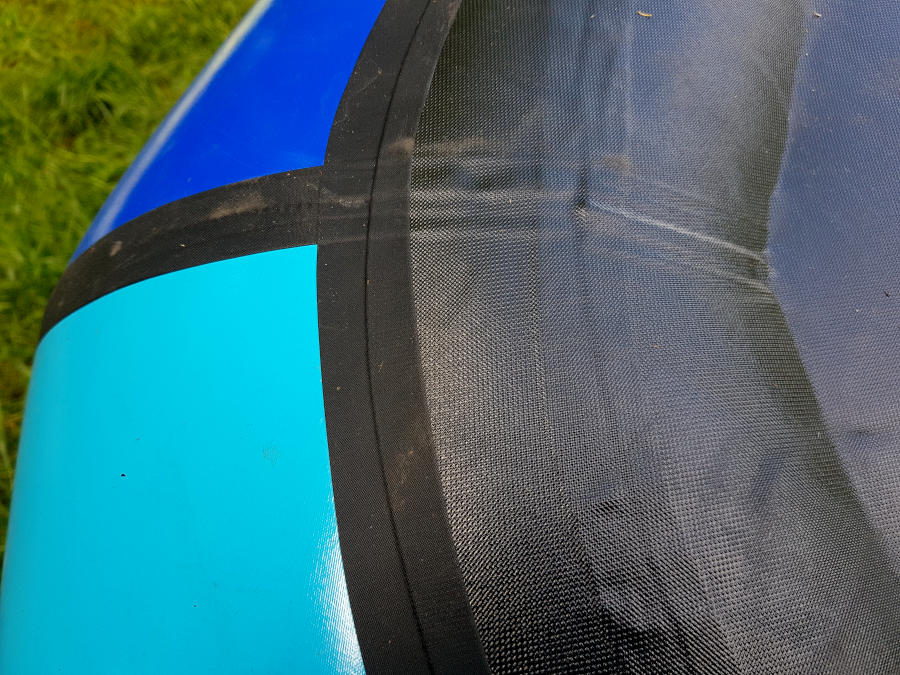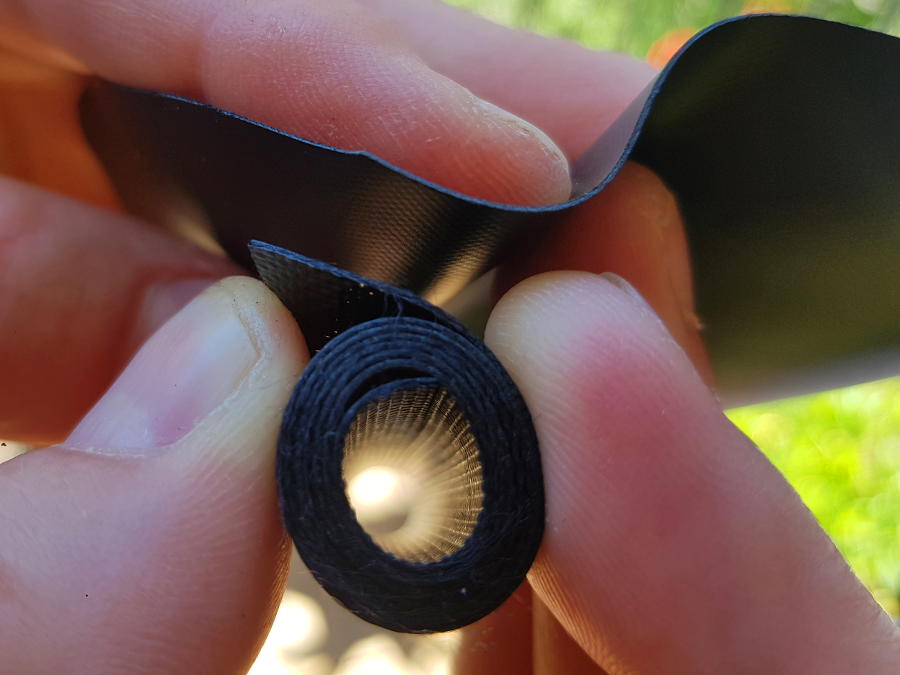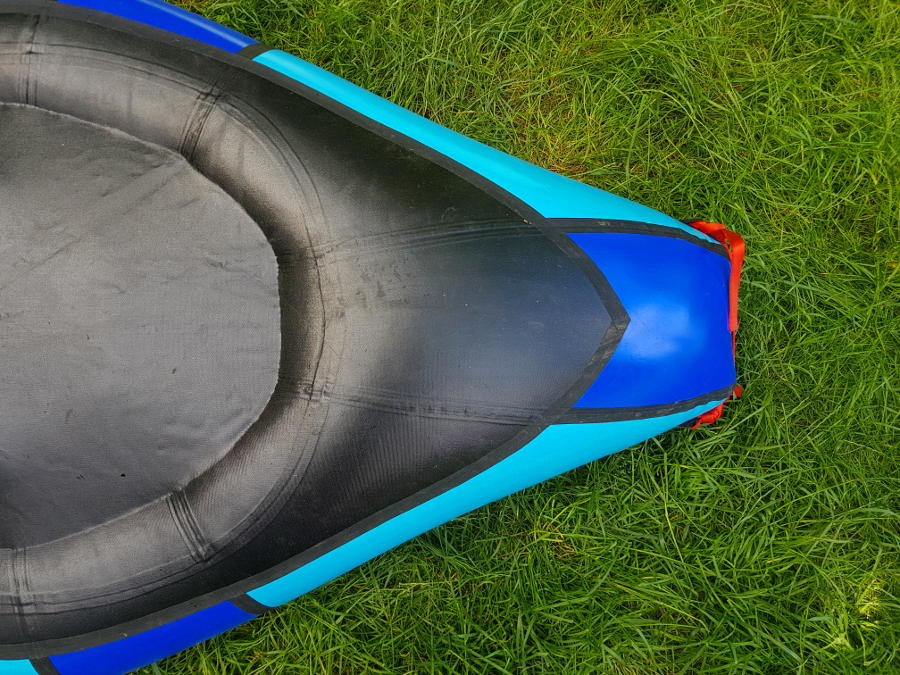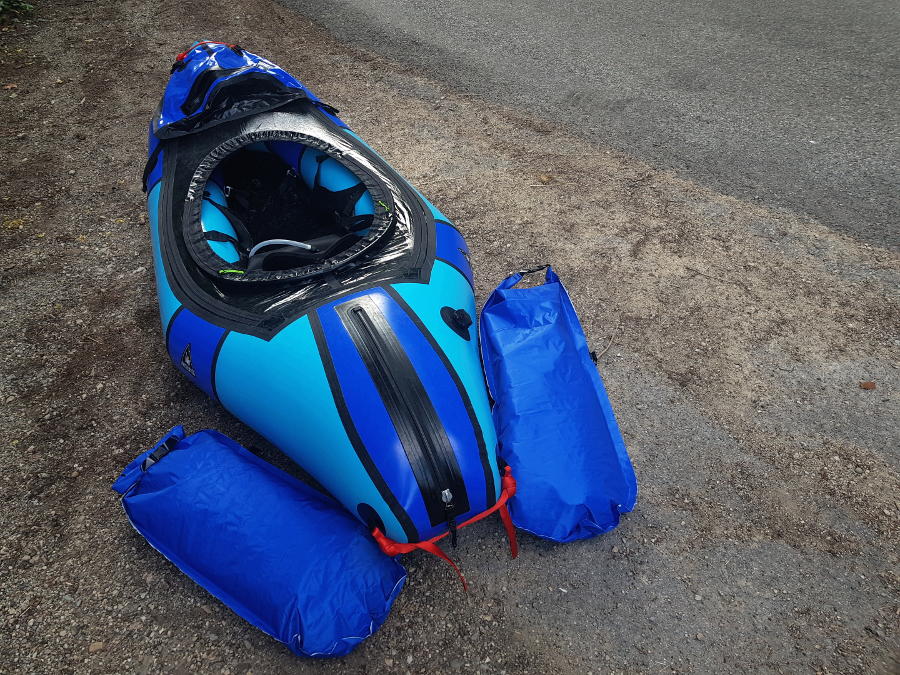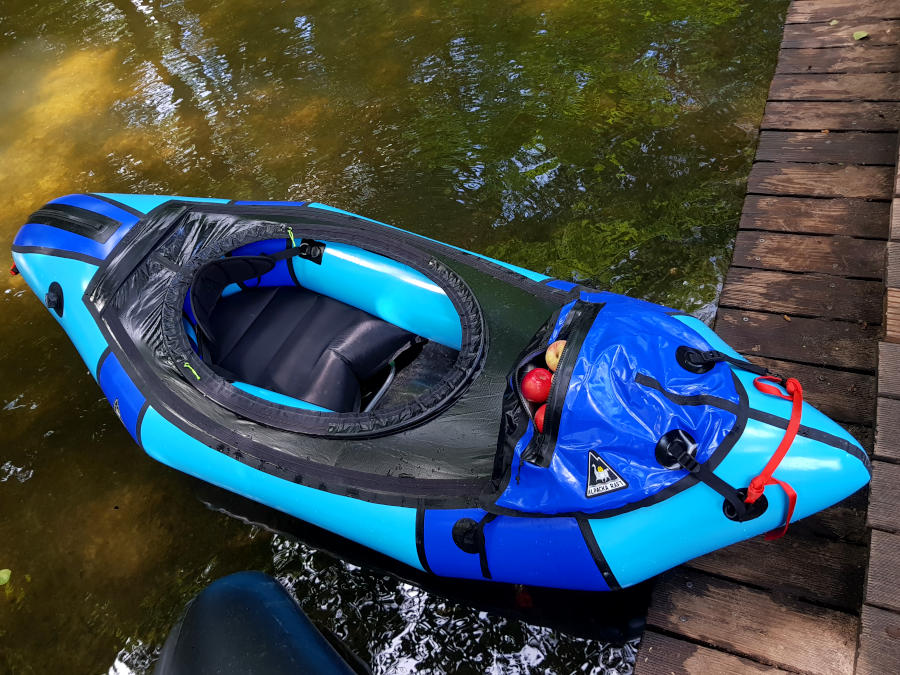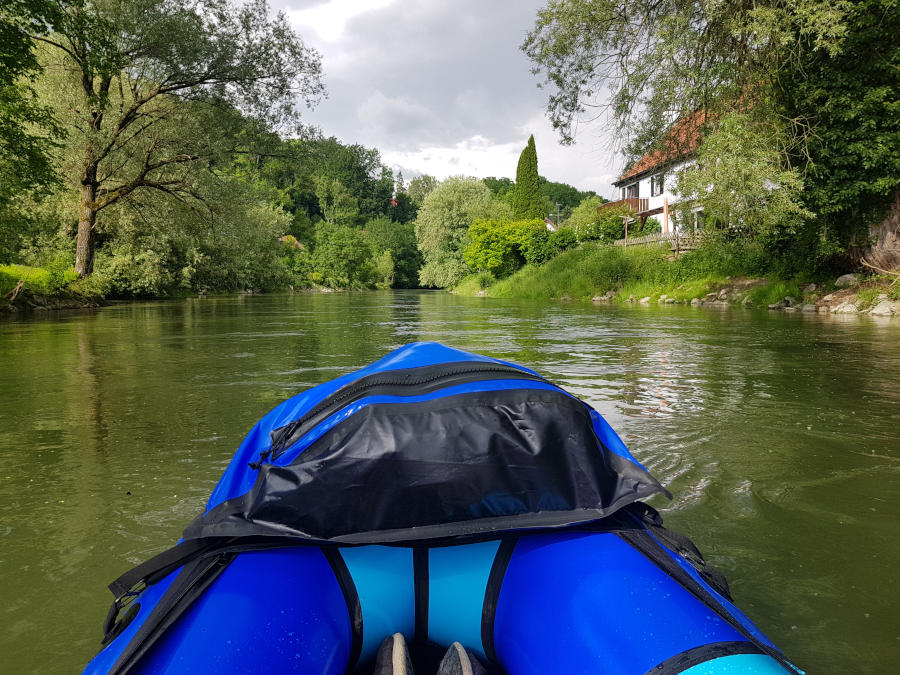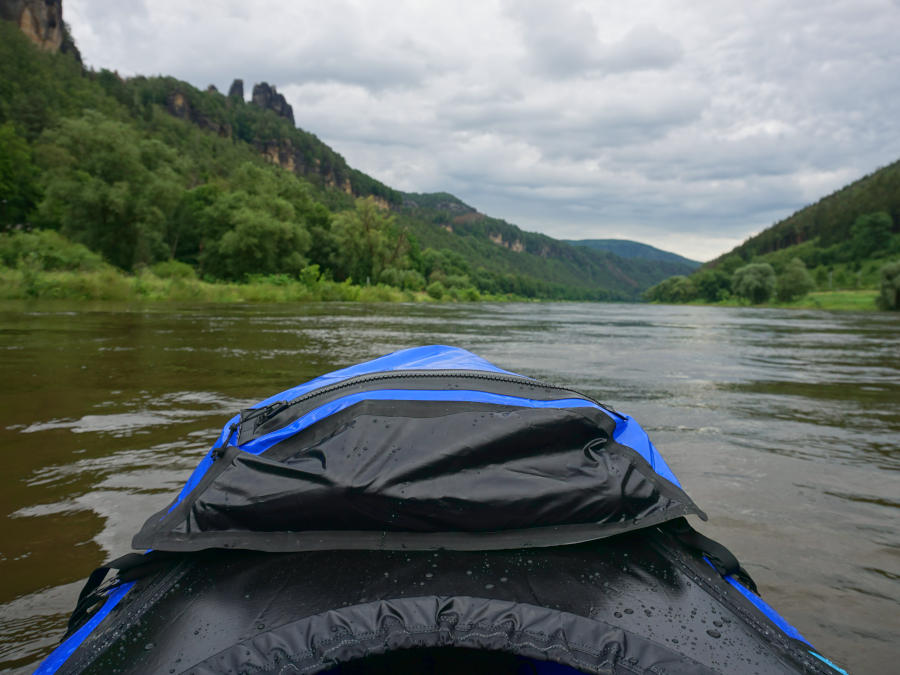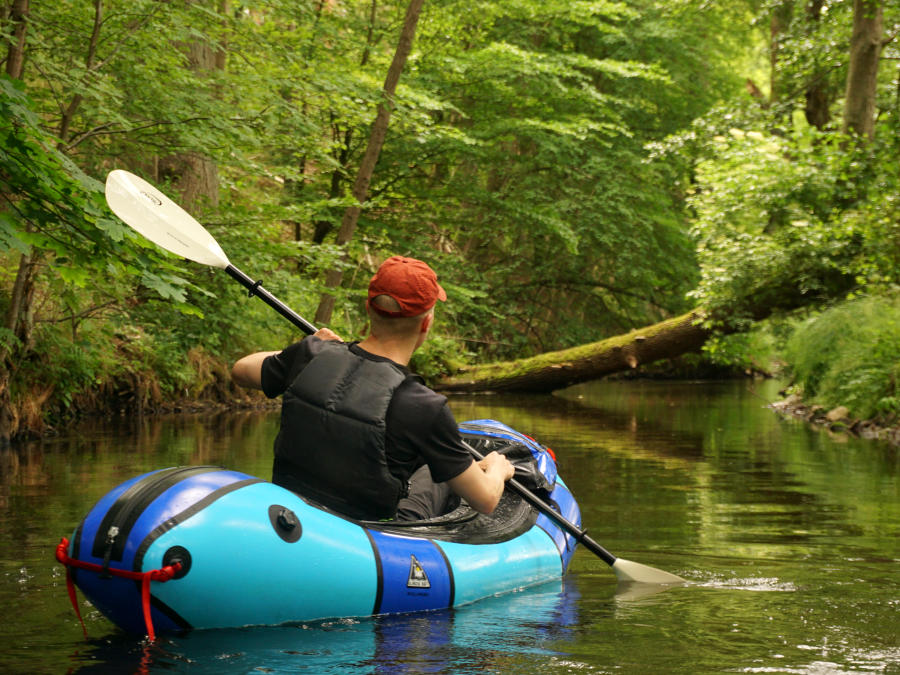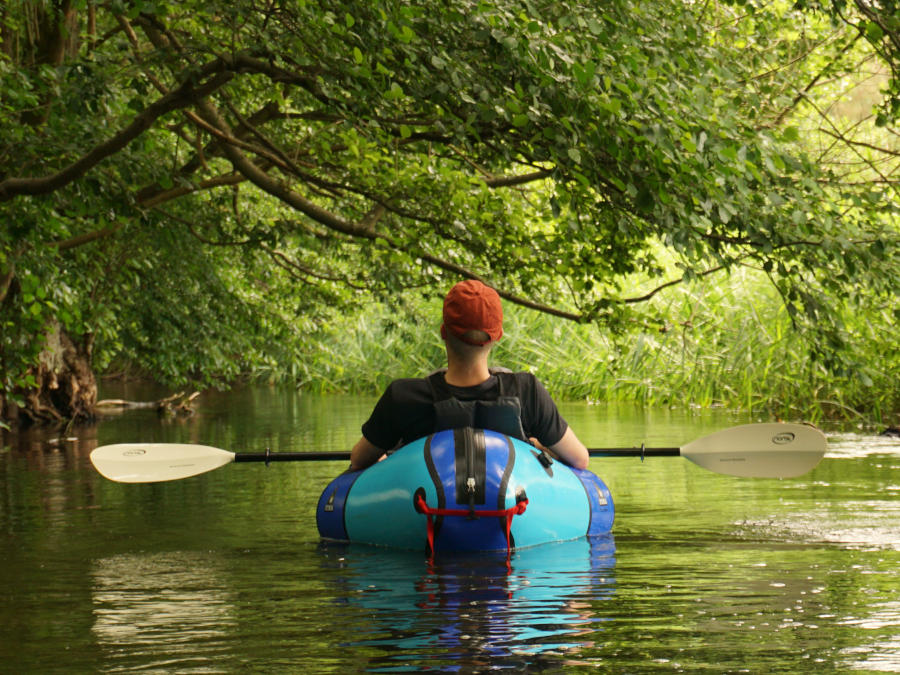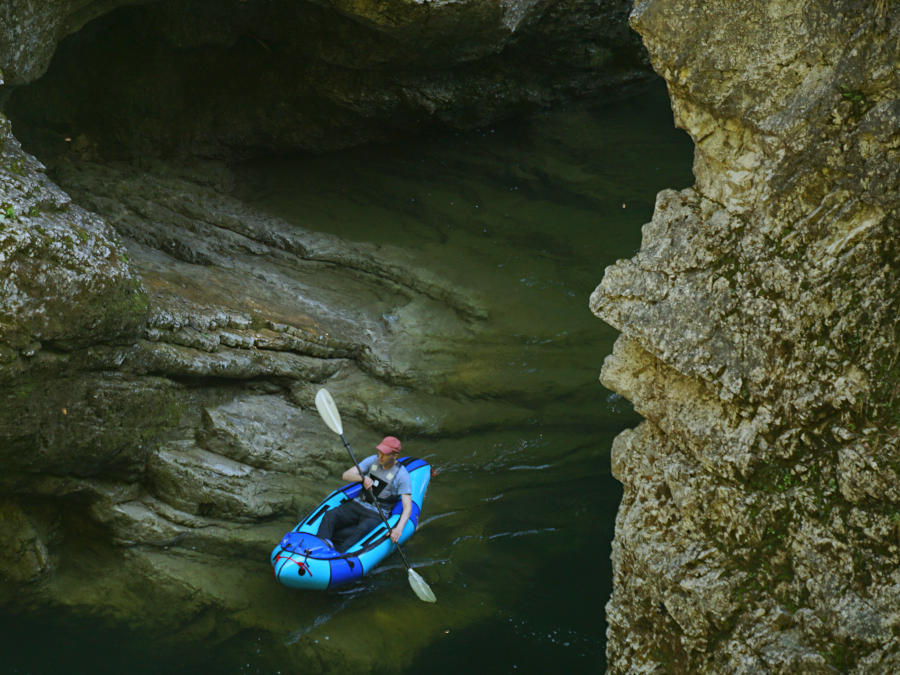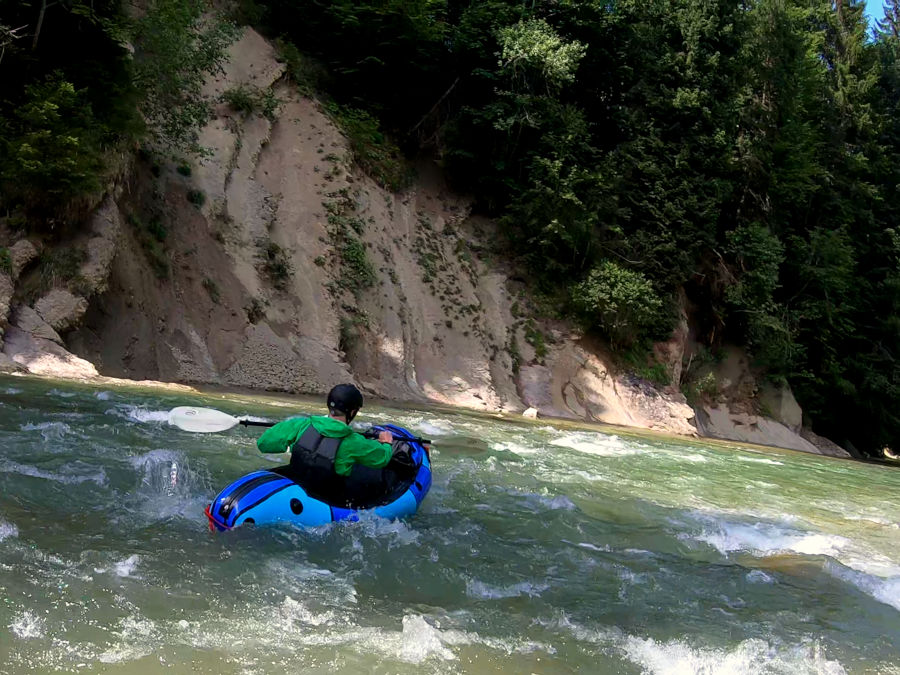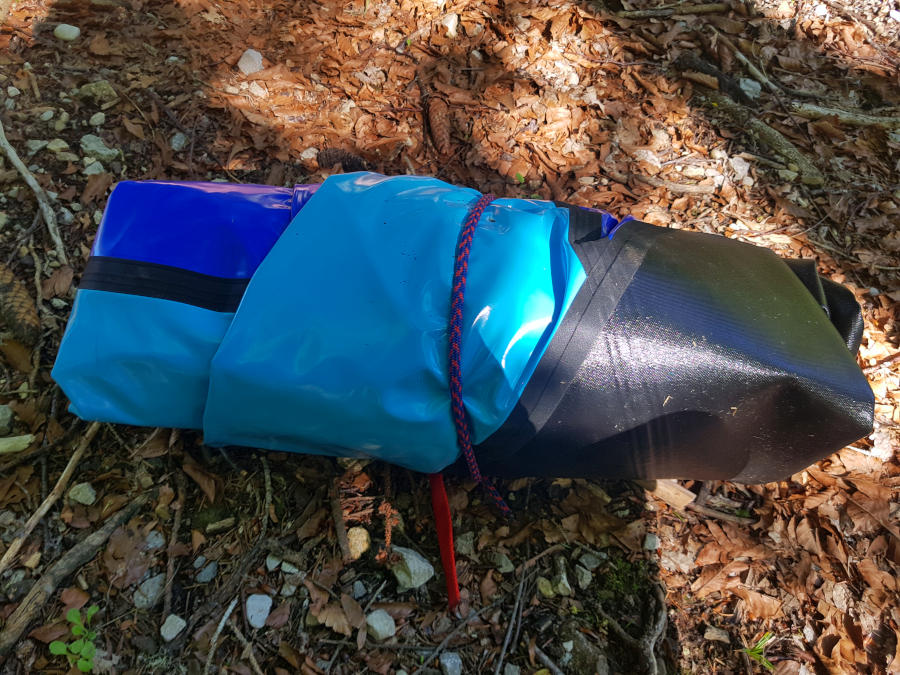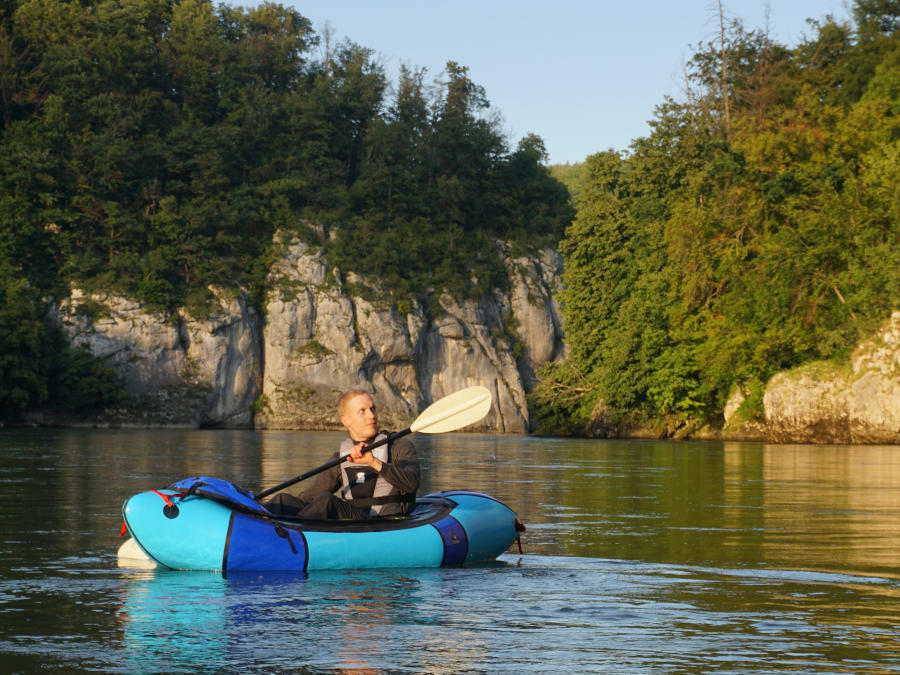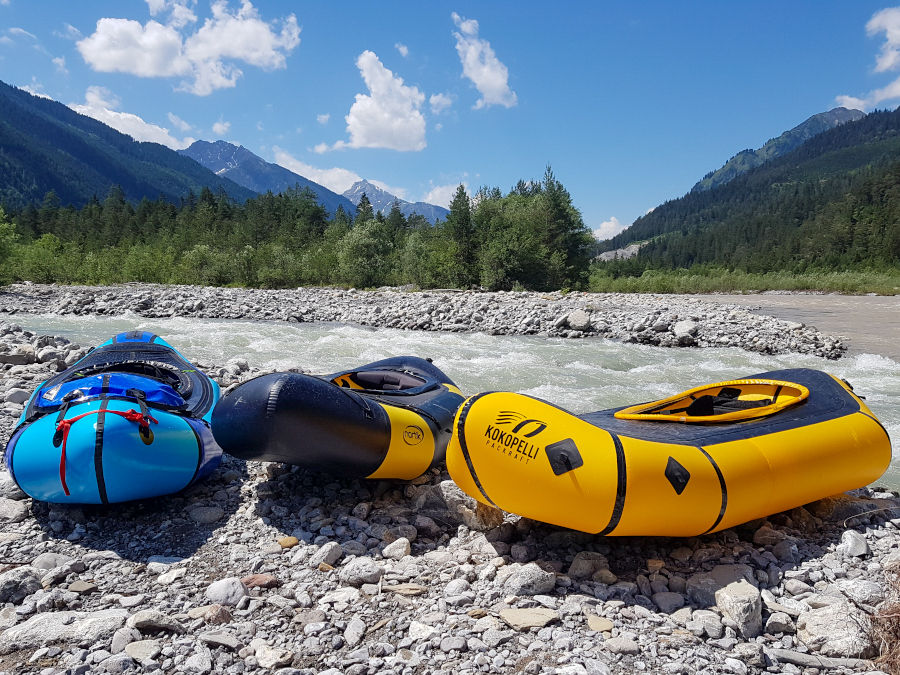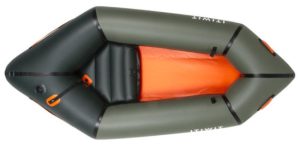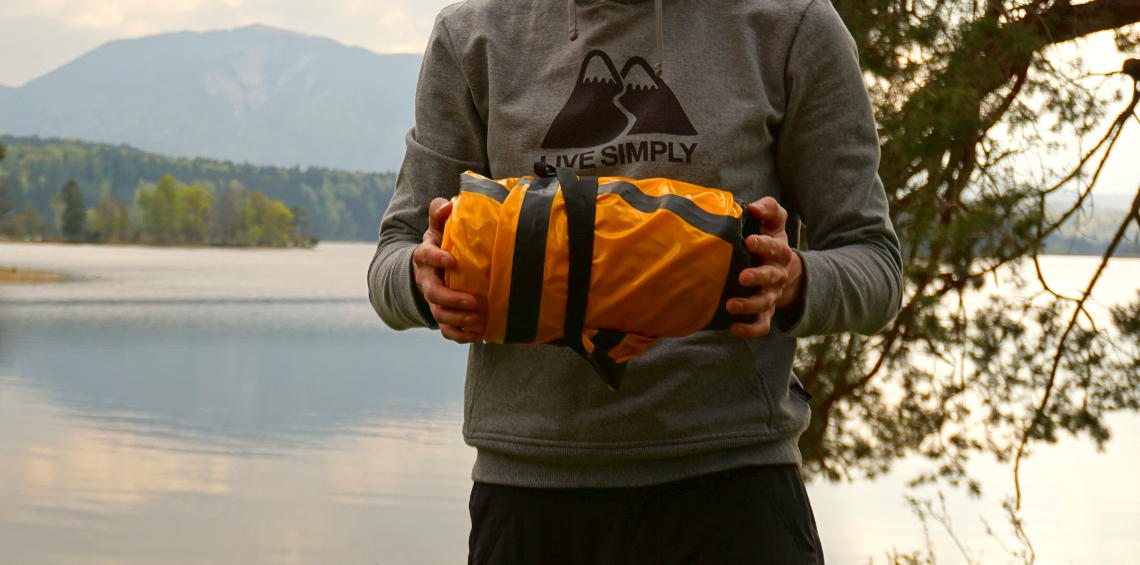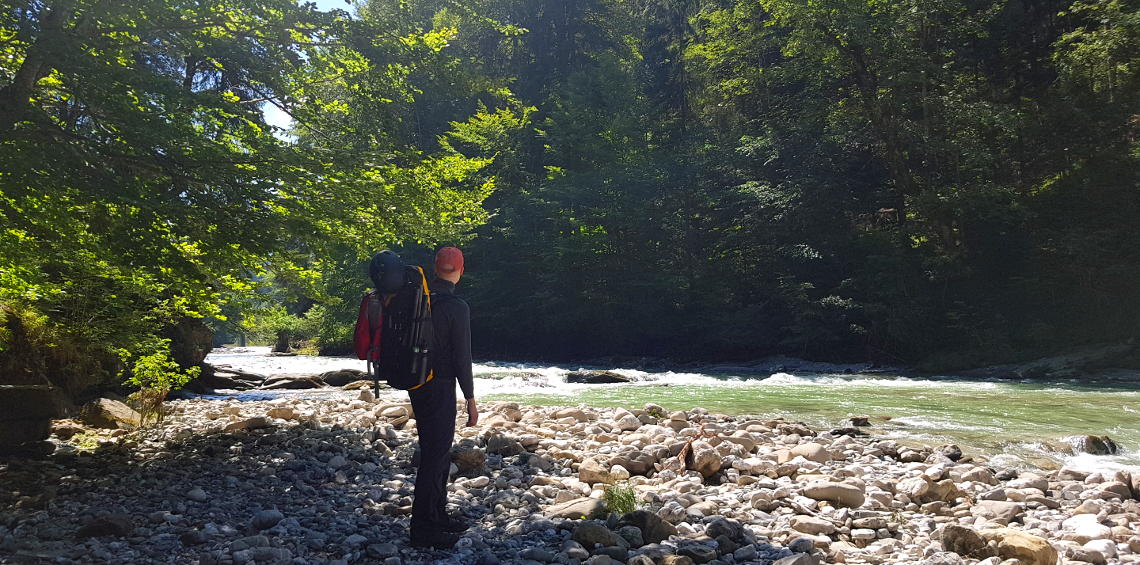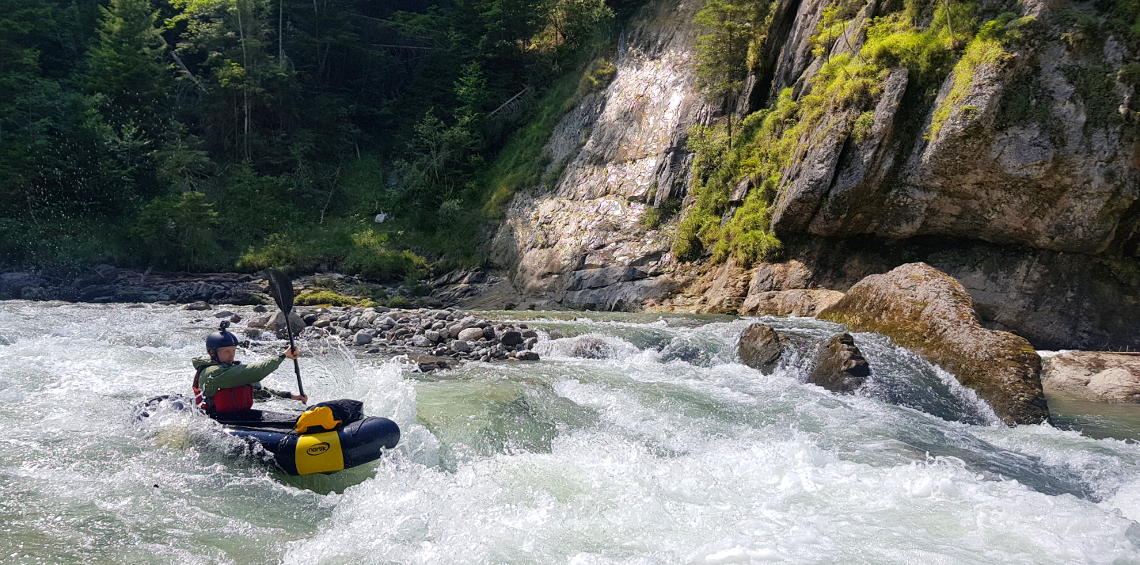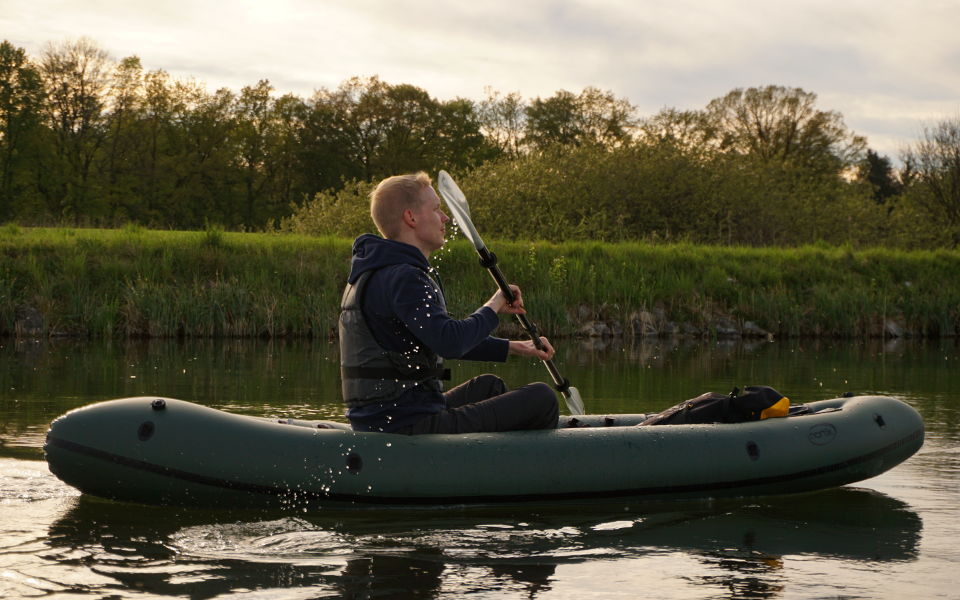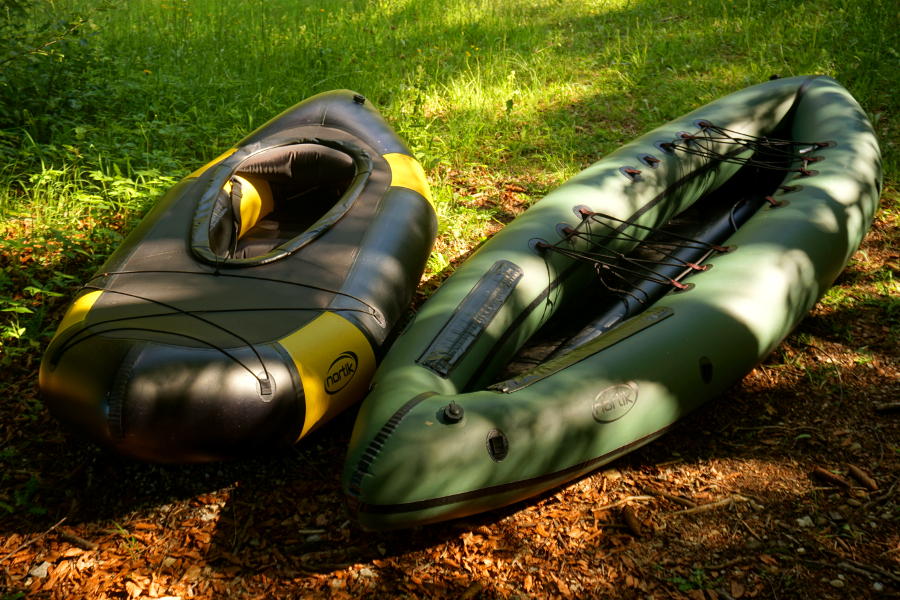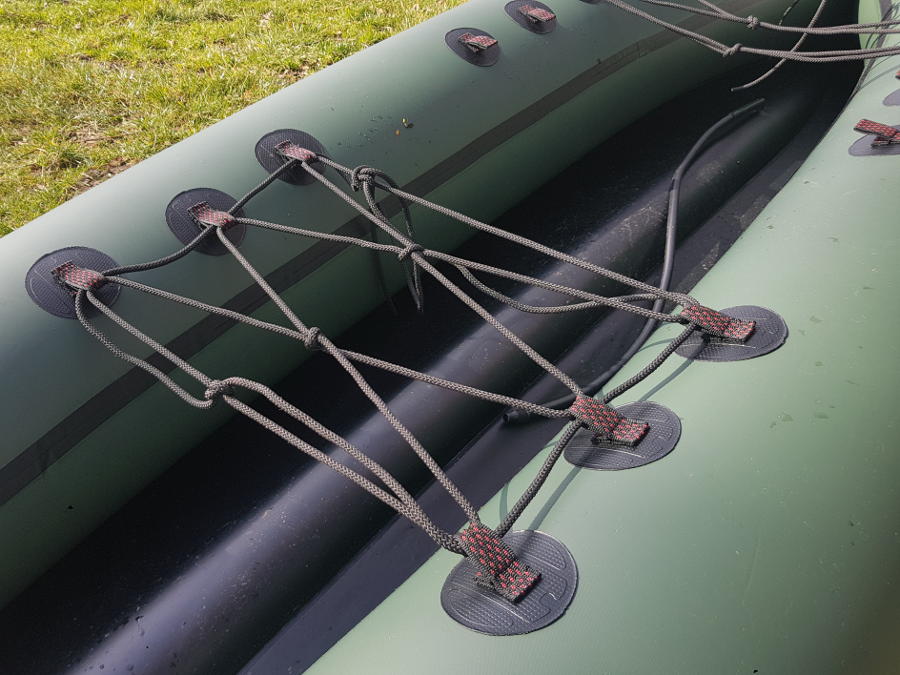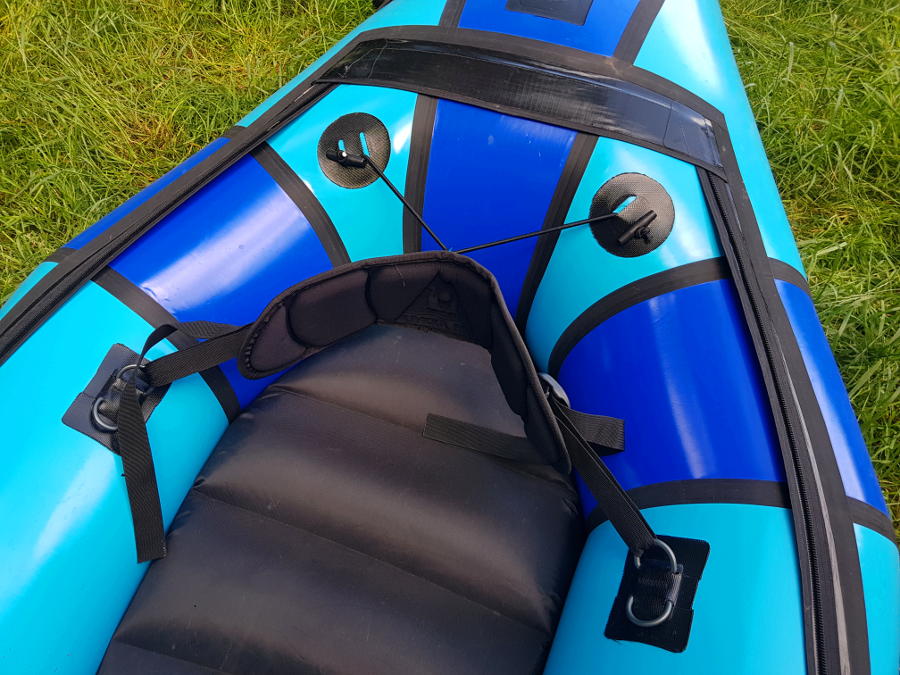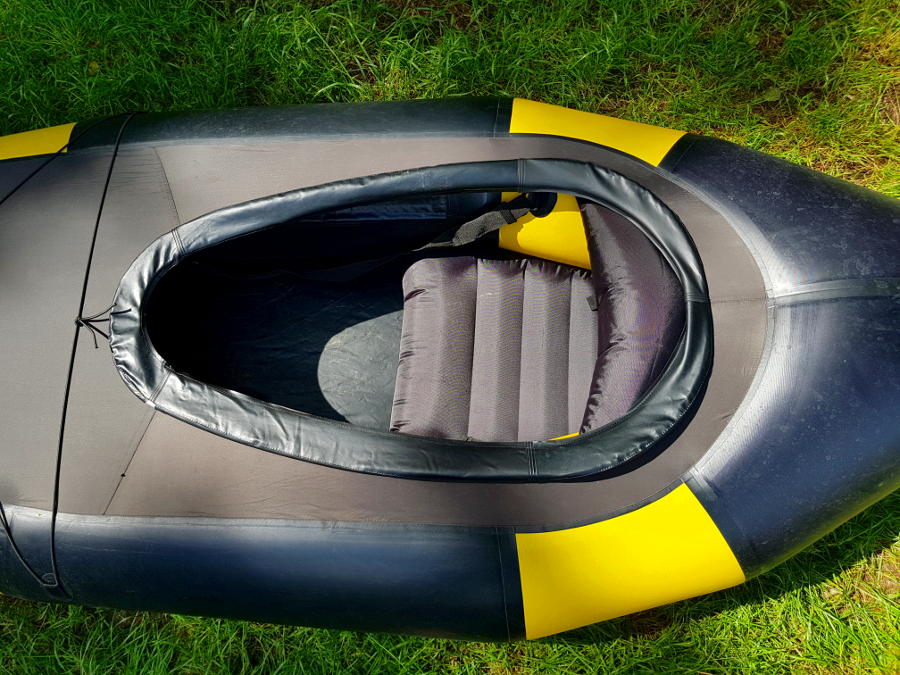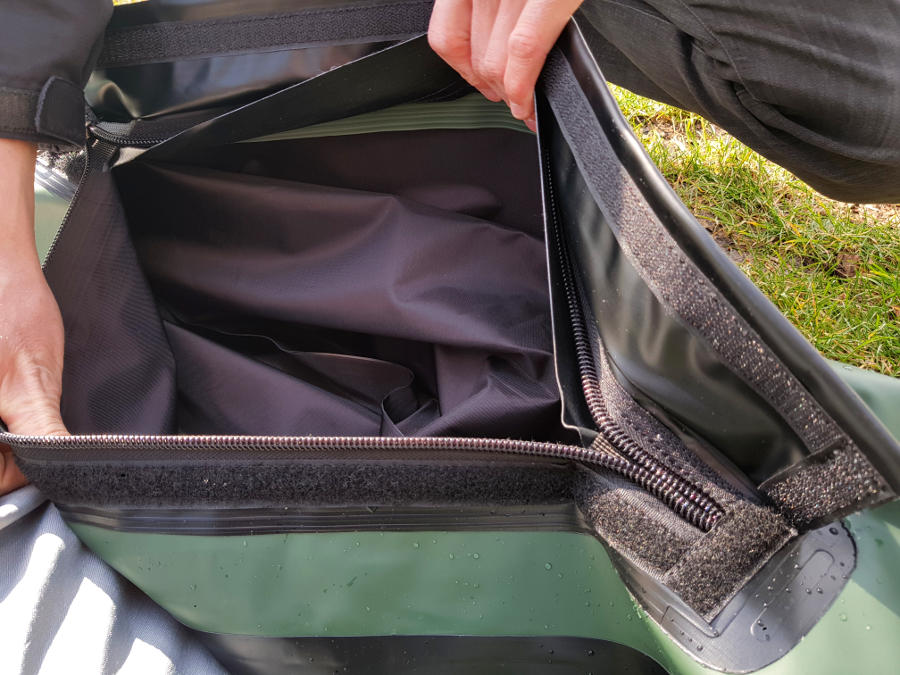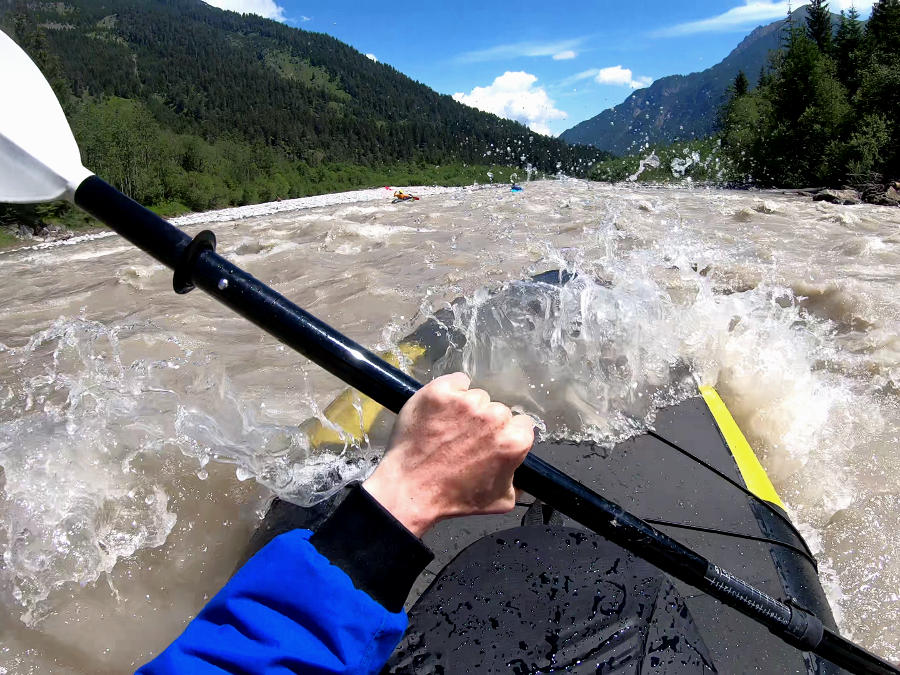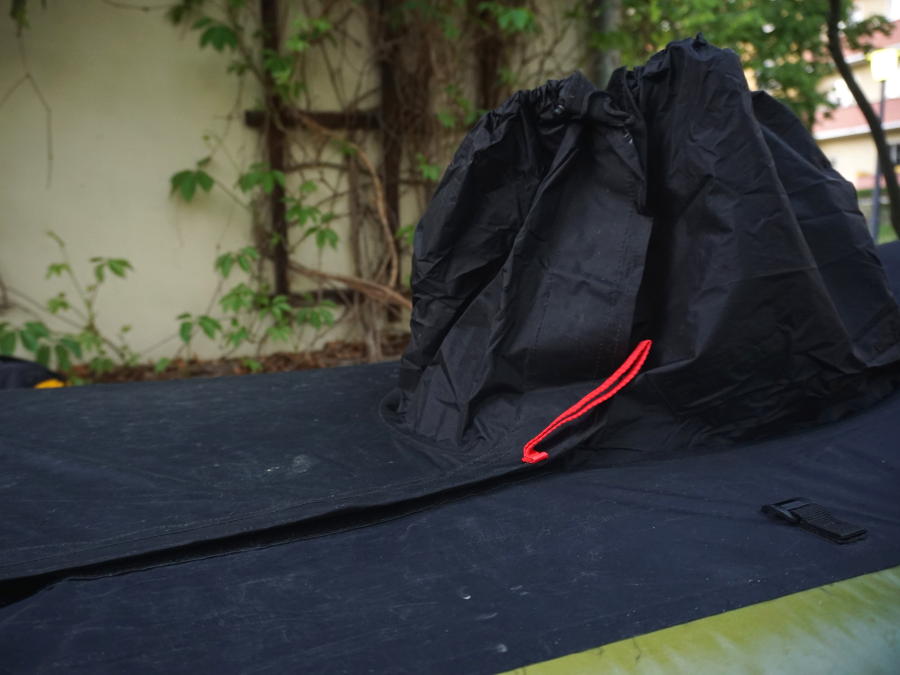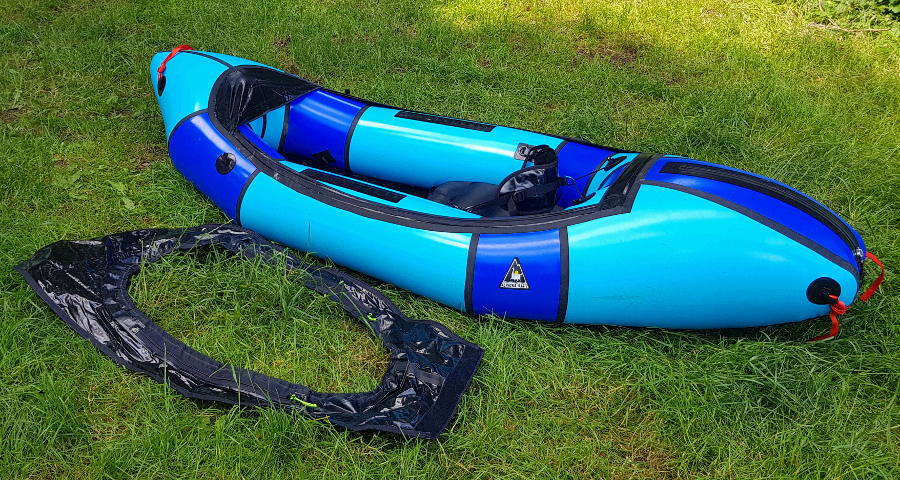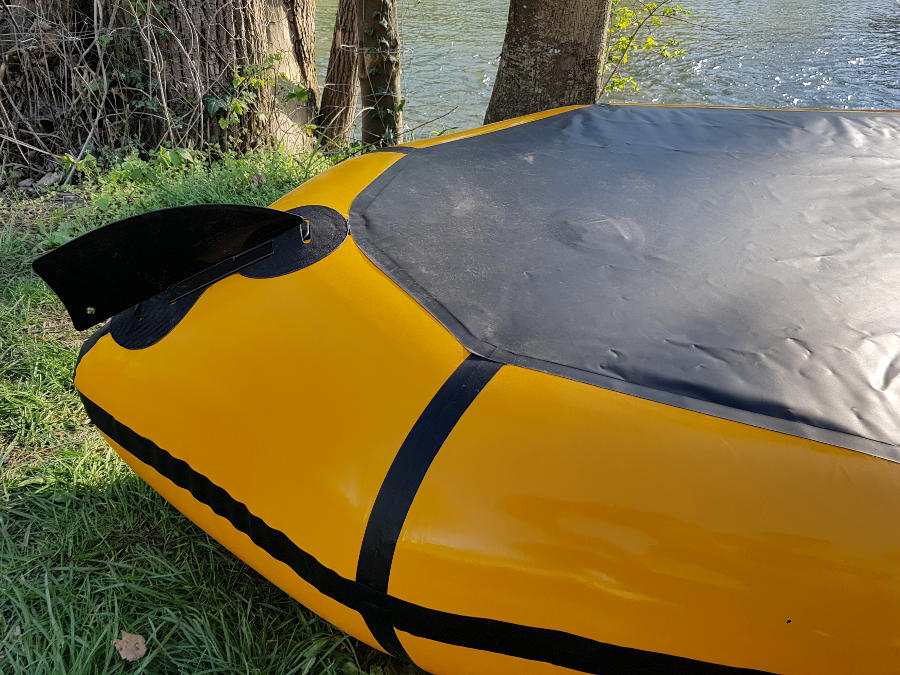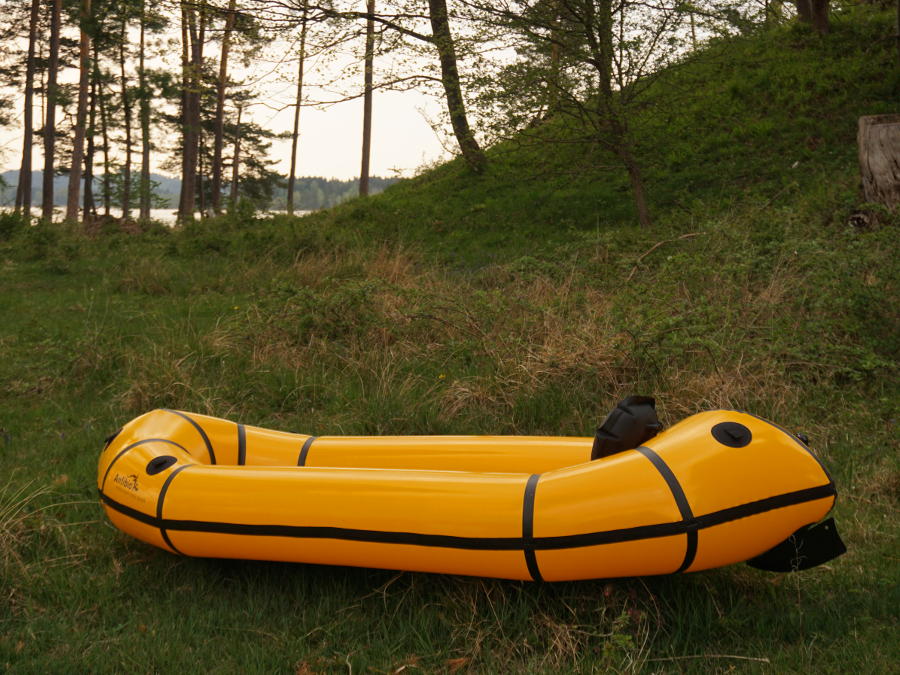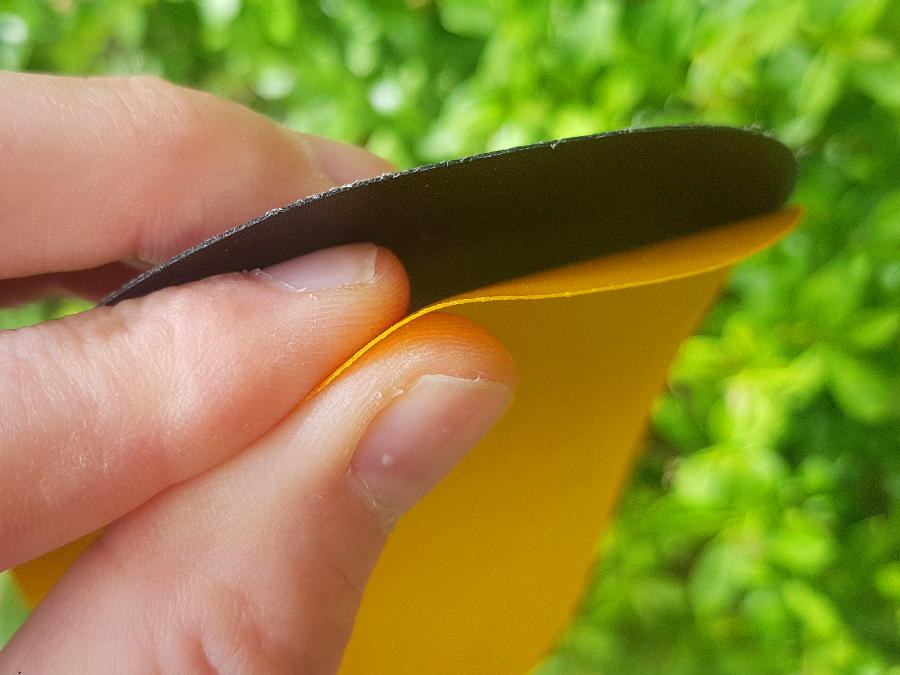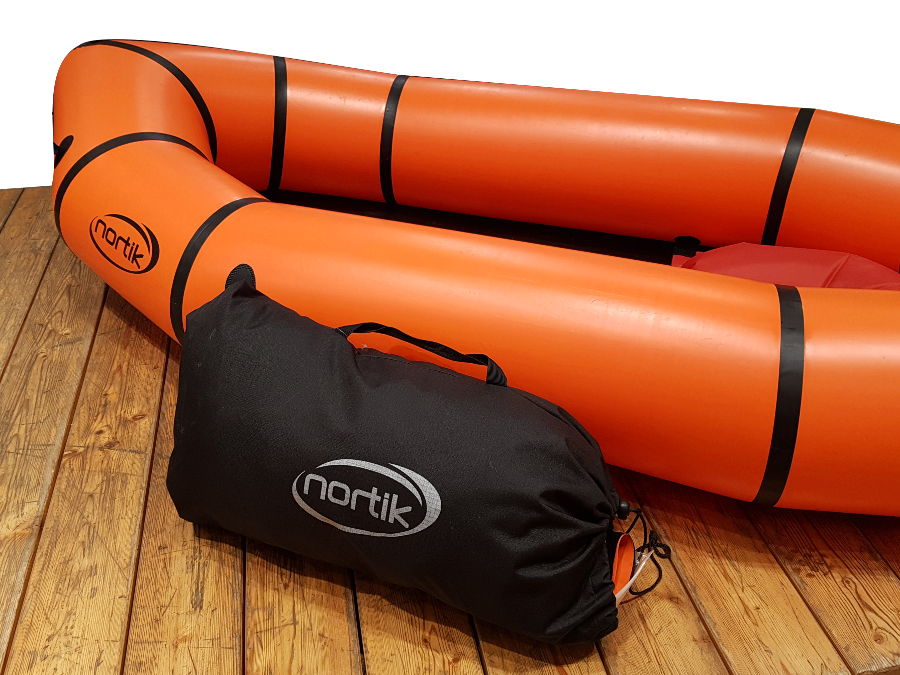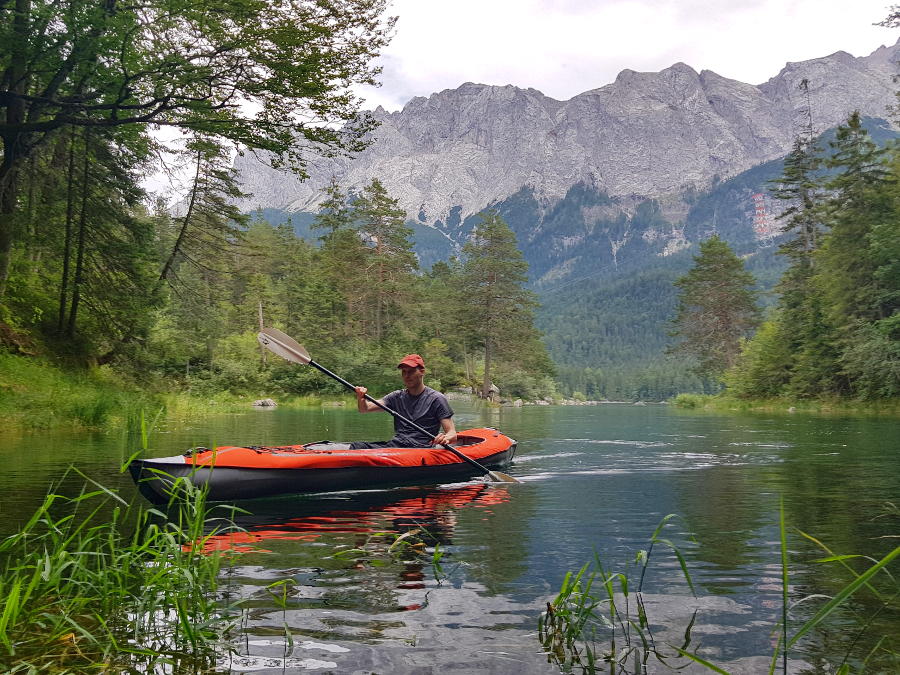Decathlon entered the packrafting segment with the Itiwit Packraft 500 at the end of 2021. Now, with the Itiwit Packraft 100, another model has appeared, which is aimed more at beginners, both in terms of price and equipment. In this review you will find out what the new Packraft from Decathlon has to offer and what experience we have already gained with this packraft.
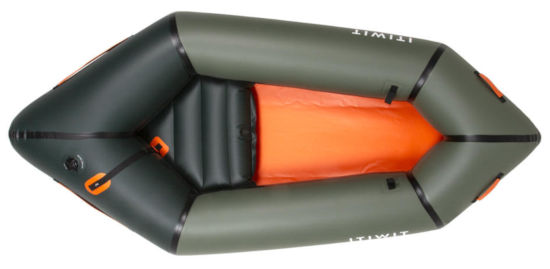
Technical Specs
Max. paddlers:
Length:
Width:
Capacity:
Packed size:
Material:
1
205 cm | 6’7”
95 cm | 3’1″
110 kg | 242.5 lbs
25 x 40 cm | 8” x 1’3”
TPU/PU coated nylon
Weight (Boat):
Weight (Complete):
Produced in:
1.8 kg | 4 lbs
2.0 kg | 4.4 lbs
China
Which model has been reviewed?
Itiwit Packraft 100 from 2022
How did we organize the review?
We have purchased the Itiwit Packraft 100 ourselves.
How intensively has the product been tested?
low
2 bars = min. 1 day/ 2 half-day tours
3 bars = min. 4 tours
4 bars = min. 8 tours
5 bars = min. 12 tours (very intense)
Where have we tested the product?
Whitewater
Calm rivers
Lakes
First impressions and assembly
The Packraft is supplied with a transport bag, which not only makes a robust impression, but also fulfills several functions at once: transport bag, air pump and dry bag during the tour. Itiwit has already applied this concept to the Adventure 500, which we really like.
The roll closure allows the Packraft to be stowed in a space-saving manner. Excess air that remains in the packraft when the closure is rolled up can then be released via the valve on the front of the bag. This results in a securely packed Packraft in a maximally compressed state.
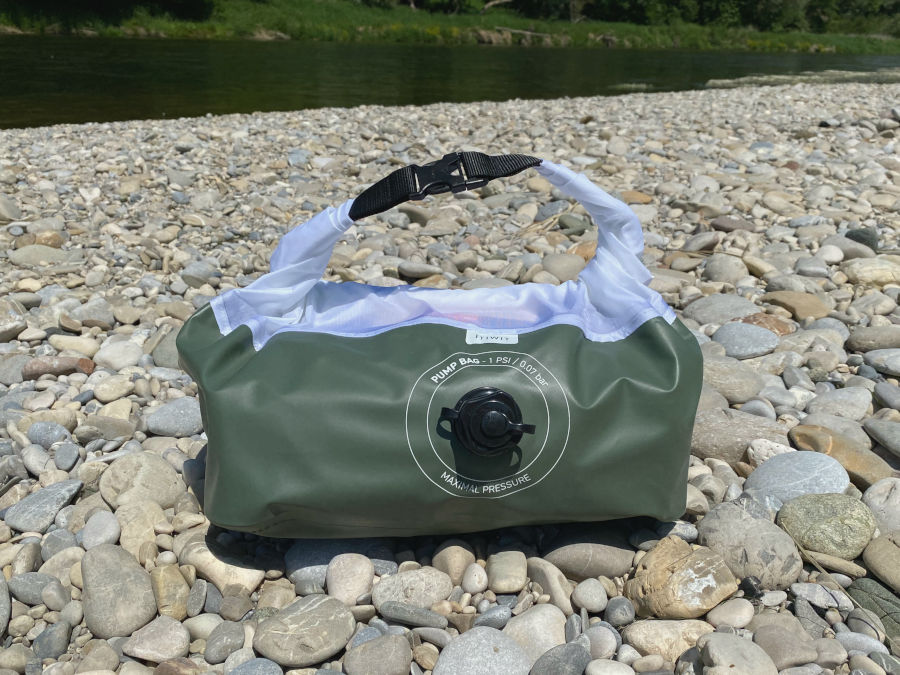
Besides the packraft, the transport bag contains the seat, the pump hose and some self-adhesive repair patches. None of this is additionally packed in PVC film or a bag. We like this quite a bit because it means there is no unnecessary packaging waste.
The Packrafts assembly instructions are also sewn into the upper edge of the transport bag, which serves as a handy quick reference guide for on the go in addition to the actual instruction manual.
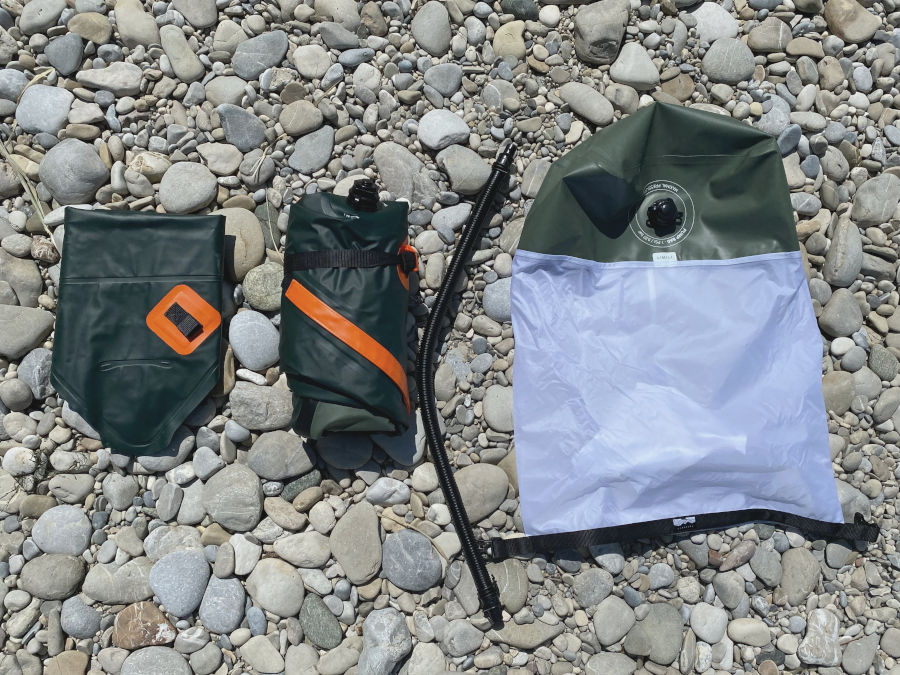
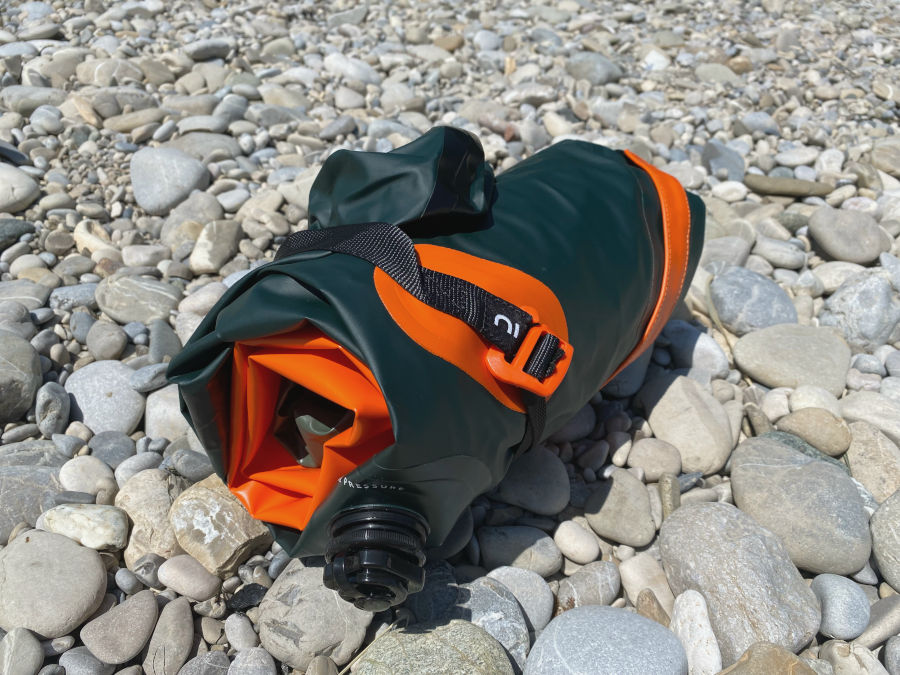
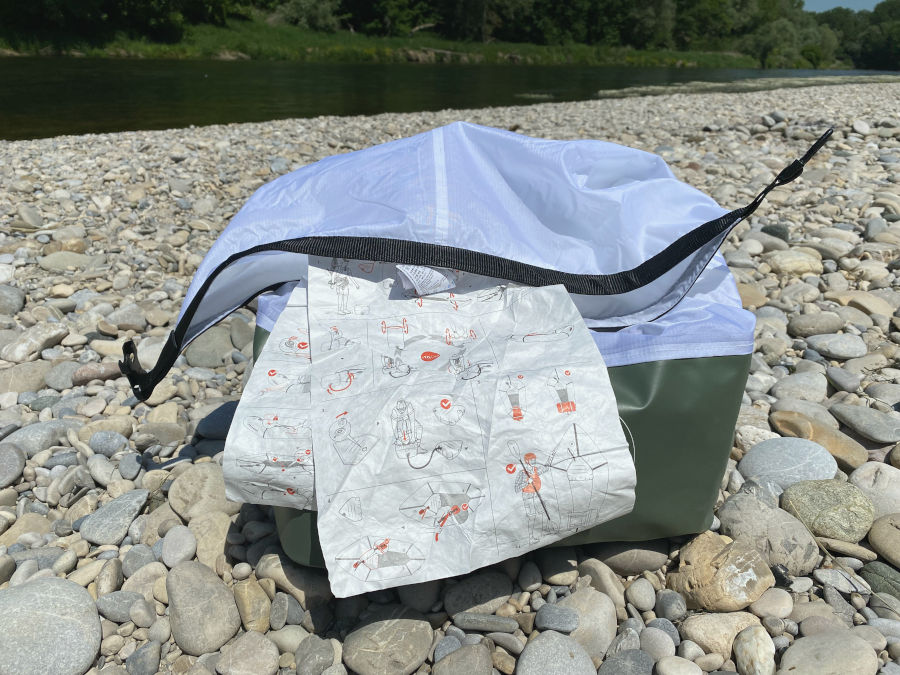
Decathlon advertises the light weight of the packraft and states a total weight of 2kg. Since the weight plays an important role in packrafting, we weighed the individual parts. The packraft itself weighs 1630g, the seat 300g, the pump bag 290g and the pump tube 60g. This gives a total weight of 2280 g and is thus slightly above the stated total weight 2 kg on the part of Decathlon. But even about 2.3 kg total weight is not much for a packraft. However, the pump bag with pump hose weighs more than usual inflation bags of Packrafts from other manufacturers. Due to the multifunctionality of the pump bag and the easy handling as a pump, it’s a real benefit.
The assembly of the Packraft is very simple and thanks to the ingenious pump bag, it is even easier for beginners with the Itiwit Packraft. First you have to unfold the Packraft. It is common for inflatable boats to have a compression strap around the boat to prevent it from rolling out on its own and to make it easier to stow away at the end. With the Itiwit Packraft, no additional compression strap was used, but the strap that is later used for seat attachment is also used as a compression strap. This is a small detail, but pretty well thought out. The weight saved is negligible. The real advantage of this implementation is that you cannot lose the strap, because it is firmly attached to the boat.
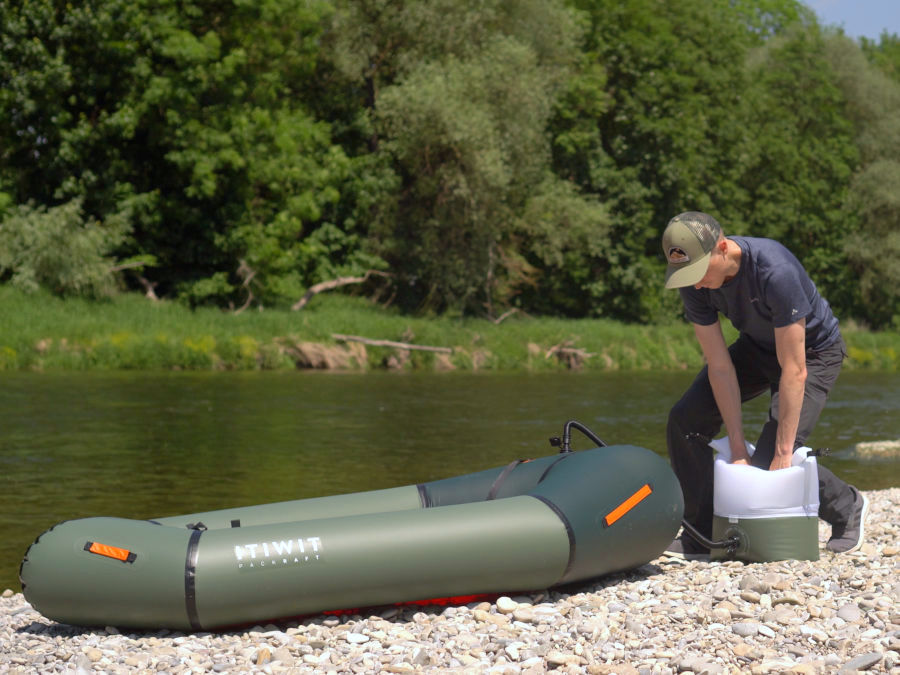
Usually a packraft is inflated with a simple inflation bag, because this is very light and compact. An air pump would be impractical for a packraft, because it would quickly exceed the pack size of the packraft. The disadvantage of a inflation bag is only that the inflation with that requires some practice and habit. Thus, beginners often find it somewhat difficult to efficiently fill a packraft with air using a inflation bag.
Itiwit has come up with a good compromise between an inflation bag and an air pump for its packrafts. The transport bag serves as a pump bag during assembly. To do this, you open the valve at the bottom of the transport bag and attach the supplied pump hose. The other end of the pump hose is attached to the valve of the packraft.
Thanks to the air hose, the pump bag can be placed on the ground and used like a hand pump. You simply lean on the air-filled pump sack and pump air into the packraft. You roll the pump bag a little bit again and again, so that a sufficiently high air pressure is generated in the pump bag, which you can push in the packraft.
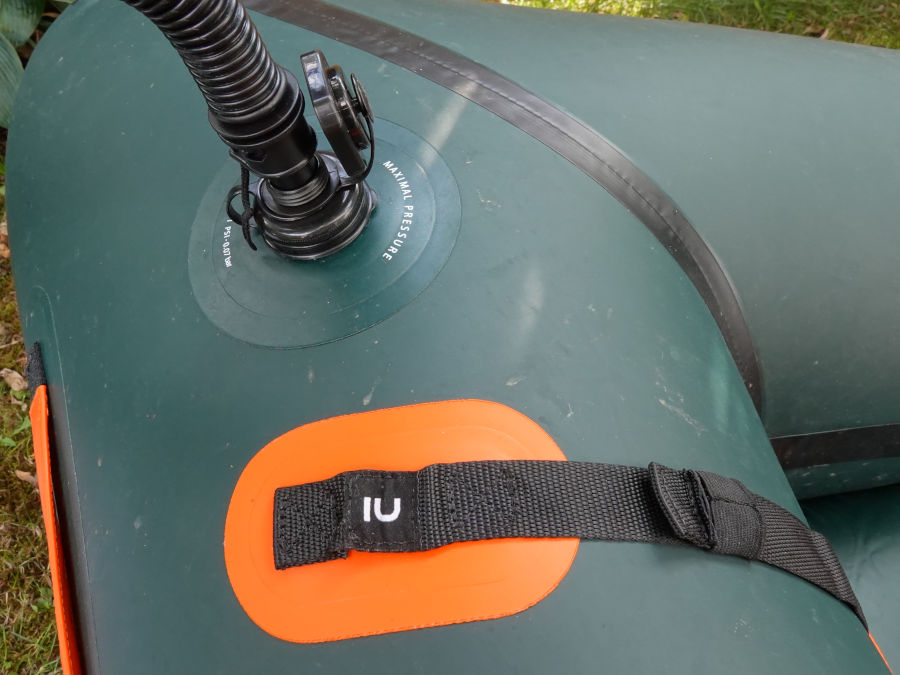
You repeat this pumping process several times, more precisely according to the manual “10 – 12 times until the pump bag no longer allows it”. Usually with Packrafts (also with such Boston valves) you generate the final air pressure with your mouth or with a separate small hand pump. We use the Itiwit pump bag for this and apply small jerky impacts to the pump bag to get the air tube of the packraft nice and tight. So, from our point of view, it is not absolutely necessary to create the final air pressure with the mouth or with a small separate hand pump, as with other packraft. Here you should be careful not to create overpressure, because otherwise material damage can occur.
We therefore recommend that you create the final air pressure with your mouth or with your own puff during the first set-up, because this way you will not create overpressure. Then reach into the air tube to get a feeling of how the packraft feels with the correct air pressure. You can use this firmness as a guide later on when you want to create the final air pressure with the pump bag.
The bottom of the pump bag is much sturdier than a common inflation bag of many other packrafts, so you can put it on the ground without damaging it. Both the valve of the packraft and the seat cushion are high quality. Both valves have a check valve, so that the air can not escape when inflating.
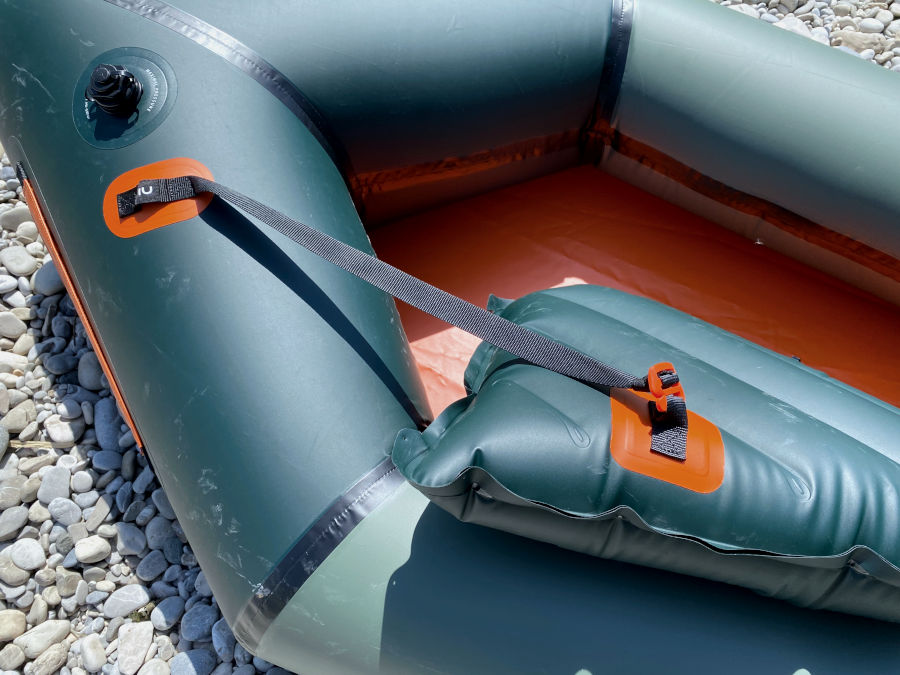
After inflating the packraft and seat cushion (by mouth or 1-2 pushes with the pump bag), position the seat in the boat. When the packraft and seat are tightly inflated, the seat cushion sits fairly tightly in the packraft. Attach the seat to the boat via a loop on the bottom of the seat using the strap. Make sure you pull the strap tight so that the seat does not slip while paddling.
Compared to many other packrafts, the seat consists only of a seat cushion and comes without a backrest. Because the seat cushion is placed so far back in the interior of the boat, you can lean against the tube. Because the Packraft does not have an adjustable backrest, you have to take into account that the seat position cannot be adjusted individually. You can find out how well this works in practice and how comfortable the seat is in the section on experiences on the water.
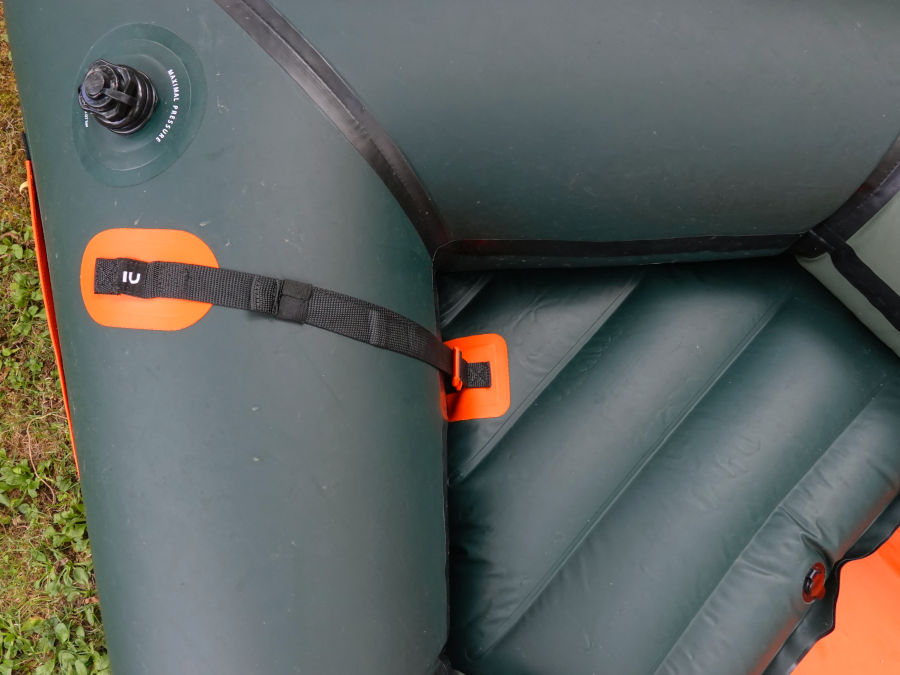
In terms of workmanship, the Itiwit Packraft 100 makes a very good impression for an entry-level model. You don’t have to make any compromise compared to the higher priced Itiwit Packraft Adventure 500. The boat is at least as well-made as the Itiwit Packraft Adventure 500. We could not find any weak points or flaws in the workmanship of our specimen. The material of the boat’s skin also feels high-quality and robust and rounds off the high-quality first impression of the Packraft.
The packraft itself is made of a coated nylon fabric. The fabric has a thickness of 420d (= denier) in the bottom and 210d in the side tube. These are typical values for packrafts in this segment. The outside of the side tube and the outside and inside of the bottom are coated with TPU (thermoplastic polyurethane), which has a high abrasion resistance and is also used in other brands of Packraft.
The inside of the side tube, which is not accessible, is coated with PU. If deeper scratches damage the outer coating, the tube is still waterproof and airtight due to the second inner coating and does not need to be patched. However, other manufacturers (e.g. Anfibio, MRS, Alpacka) do without this inner coating in order to preserve the elasticity of the carrier material (which is made of nylon or polyester) and thus achieve a higher tear resistance of the material.
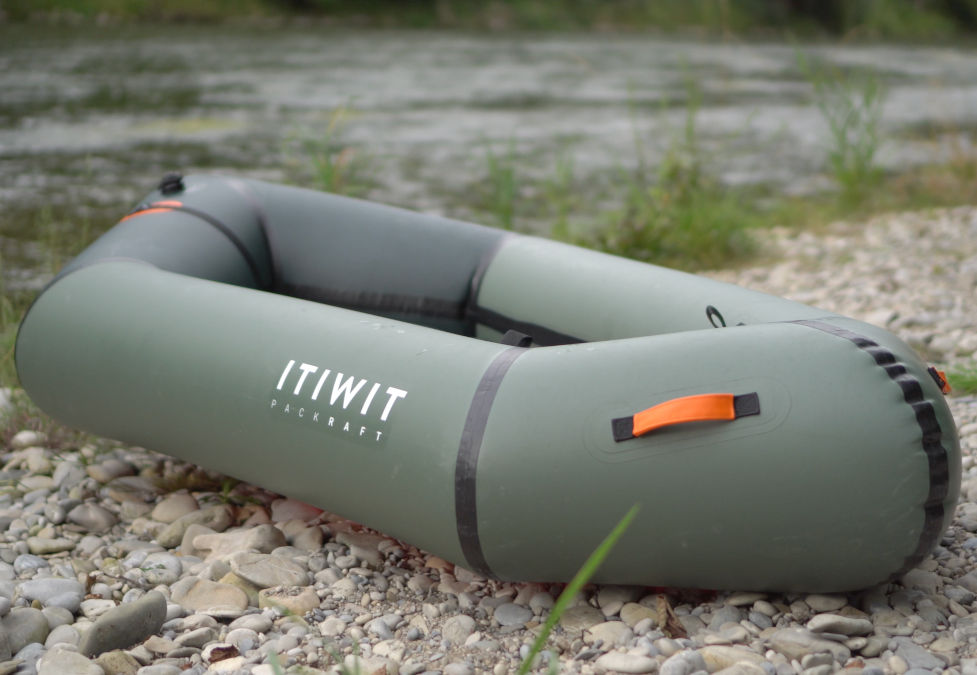
On some packrafts, it is common for the underside of the bottom to overlap the side tube to further protect it from damage in the event of grounding. This concept is common practice, especially with packrafts for whitewater use. However, since the Itiwit Packraft 100 falls more into the category of ultralight packrafts, it is understandable that Decathlon has dispensed with it for this model.
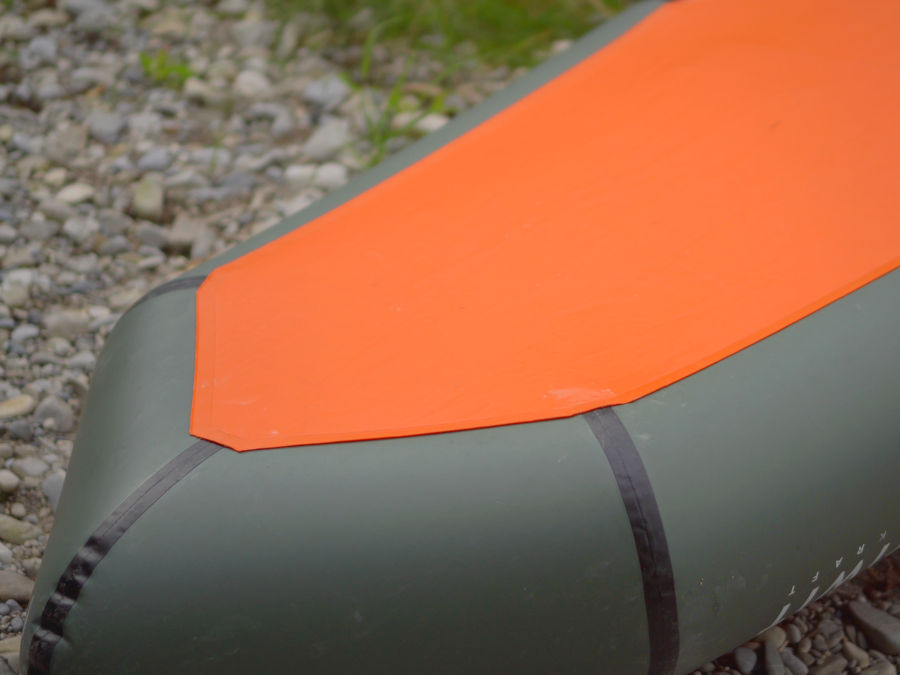
Packrafts are available as open and closed (= with spray deck) boats. The Itiwit Packraft 100 is an open packraft. A spray deck is otherwise used as a splash guard or to attach a splash skirt to completely prevent splash water from entering and also protect the paddler from the cold. In addition, luggage can be easily attached to most spray decks. You will have to do without these advantages with the Itiwit Packraft 100. Decathlon’s Itiwit 100 is aimed primarily at beginners looking for an inexpensive packraft, and a spray deck would add to the price (as well as weight). In addition, recreational paddlers who use the packraft mainly in good weather in calmer and shallower waters can easily do without such a spray deck. Therefore, this design implementation of Decathlon is also well understandable with the Packraft.
The Packraft has a total of 4 day handles (two at the bow and two at the stern). Whether in a capsize, when pulling the Packraft to shore, when transferring two on river trips or when carrying the boat alone on the water on the shoulder, there is always a way to grip the Packraft properly. At the bow there are two additional loops to attach luggage on the bow. In connection with the two carrying handles, the luggage attachment on the bow works very well. So you can easily attach the pump bag, which also serves as a dry bag, there. Therefore, you can also transport some luggage with the Itiwit Packraft 100 without a spray deck.
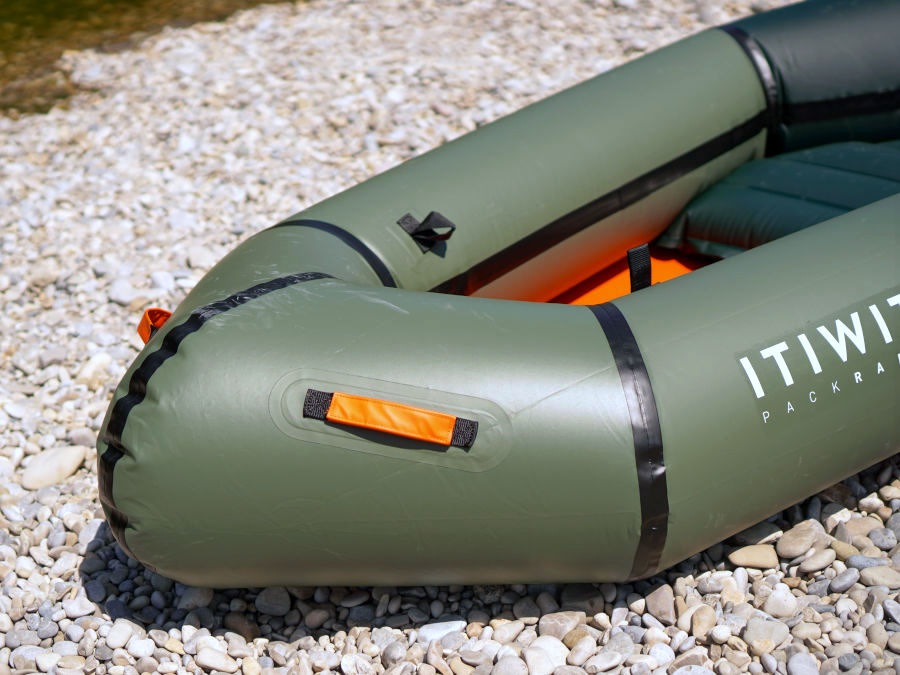
Review of the Itiwit Packraft 100 on the water
The Itiwit Packraft 100 can be carried well alone to water. To do this, you shoulder the packraft and can also use one of the carrying handles. Alternatively, you can carry the Packraft via the side tube. If you have loaded the packraft with a lot of luggage, it is still recommended to set up the packraft close to the water. If there are two of you, both people can easily carry the packraft with the carrying handles at the bow and stern.
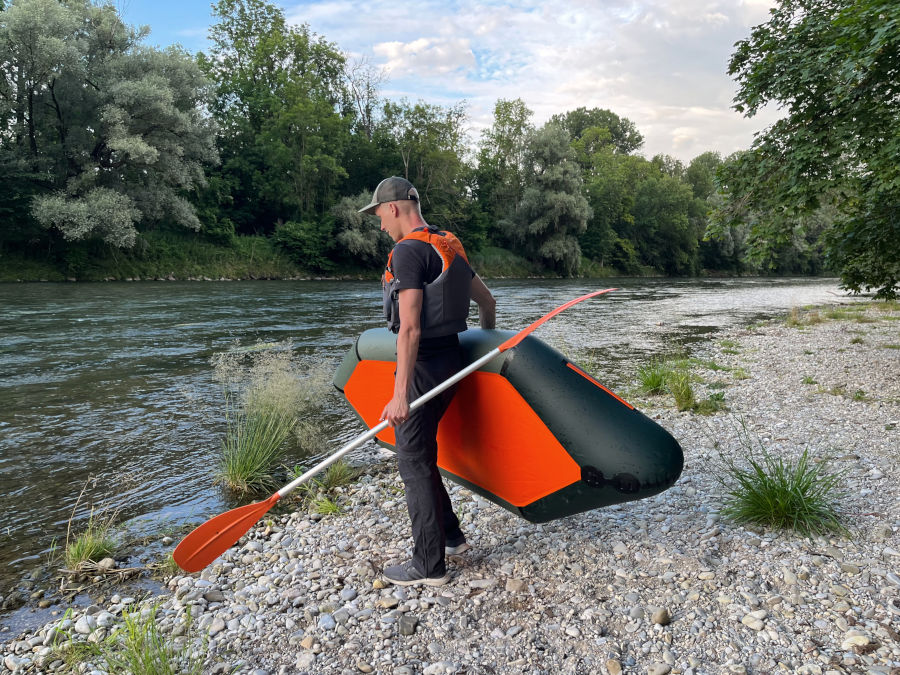
The interior of the Itiwit Packraft does not look very spacious at first glance. We with a height of 186 and 189 cm / 6’1″ and 6’2″ can not fully stretch our legs even without shoes. Nevertheless, the Packraft offers enough space for us to sit. Due to the fact that it is cut wider and the air tube is less voluminous, you can bend your legs very well and paddle comfortably for a long time even in this position. We do not miss a footrest or thigh straps, because due to the shortness of the Packrafts you can also support yourself well on the bow of the packraft.
However, we also like to paddle with our neoprene socks in the summer. If you paddle with shoes or even hiking boots, as a tall paddler you will surely long for a bigger Packraft in the long run. Also, those who do not like to paddle with more bent legs, will find the bigger brother the Itiwit Packraft Adventure 500 more pleasing.
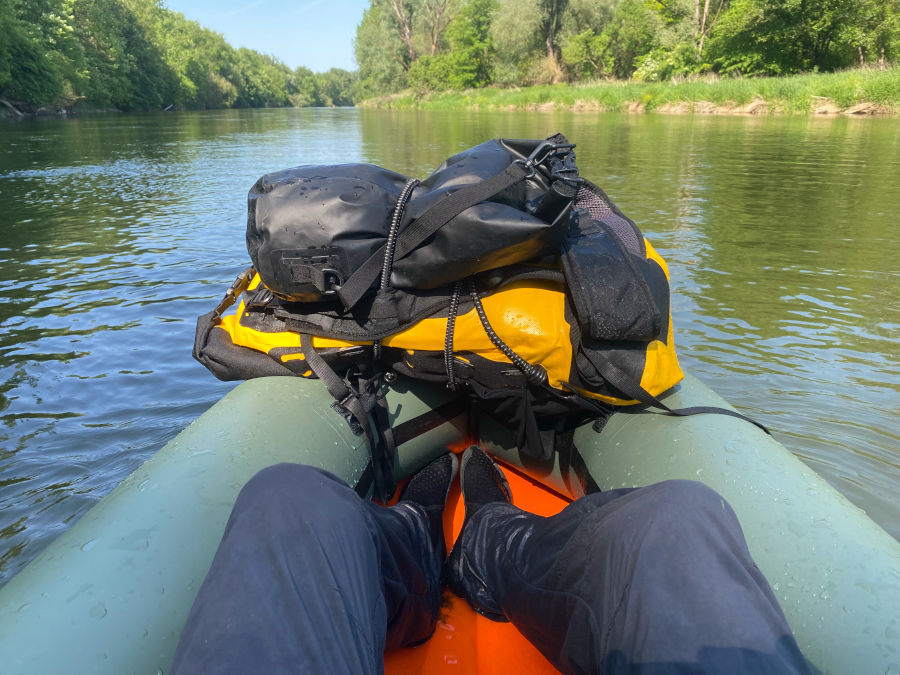
Since the Itiwit Packraft 100 does not have a T-Zip for stowing luggage like the Itiwit Packraft Adventure 500, the luggage must be stowed on the boat itself or, if necessary, between the legs. However, this works out very well. Over the carry handles and loops on the bow, we attached our Ortlieb Gearpack 40 L and a small dry bag. While paddling this did not bother at all, because the side tube of the boat is high enough and the luggage rests on it. Thus, the legroom remains completely unrestricted.
Decathlon recommends the Itiwit 30 L backpack for the Packraft. This can not only be attached very well to the bow of the Packraft, but it is also well suited for transporting the Packraft. Inside the backpack is enough space to store the boat. With the help of the side straps, the paddle can also be attached. However, we prefer a packraft backpack with side mesh pockets for better stowage of the paddle.
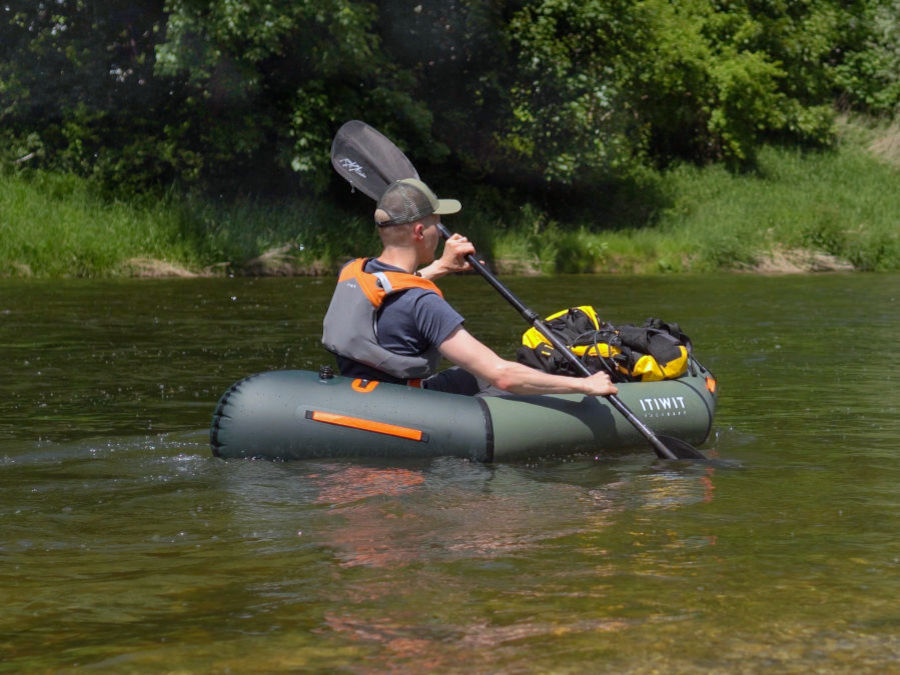
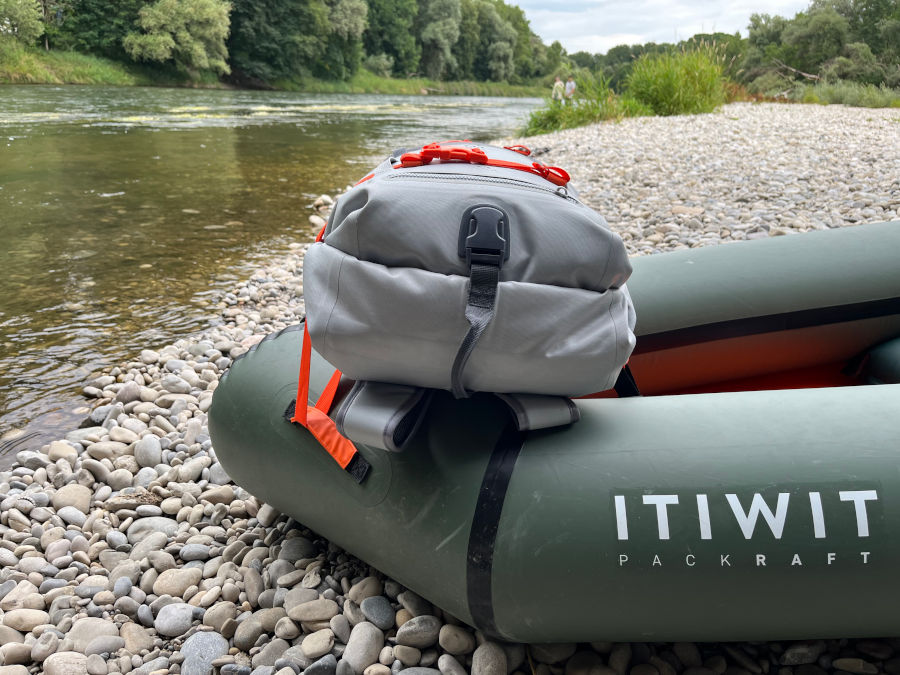
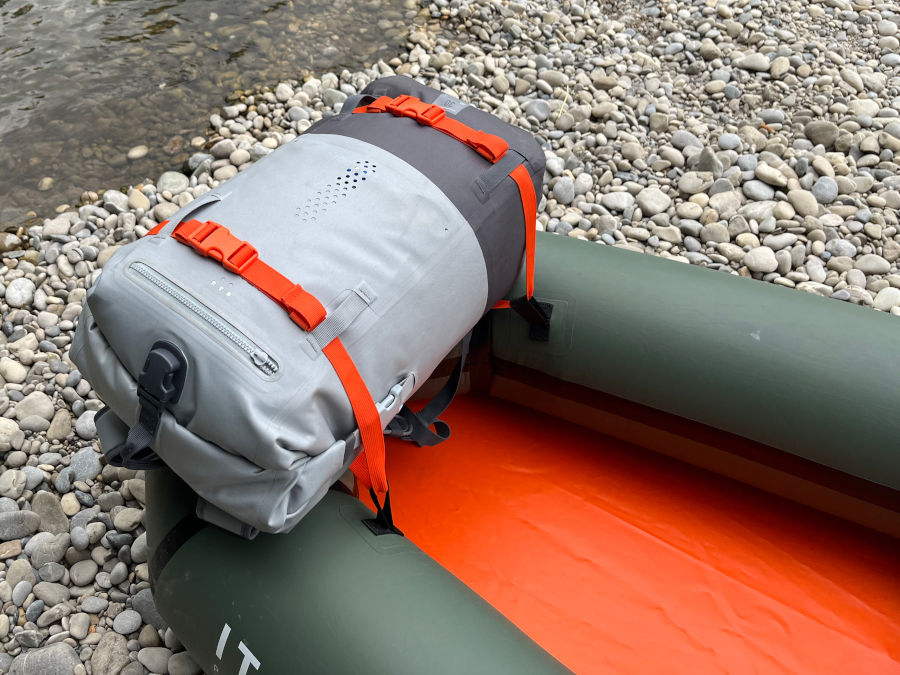
The dry bag, which also serves as a inflation bag / air pump, can also be attached to the bow. However, since it can only be attached to the bow via the roll closure, it then hangs inside the boat. We find this rather impractical, as it restricts legroom. To attach it to the bow, there are no other attachment points on the dry bag. Therefore, we recommend a packraft such as the Ortlieb Gearpack or the Itiwit Backpack 30L, which has multiple attachment points to secure it to the bow using the 4 attachment loops.
Although the packraft does not have a backrest, we feel that the seating comfort is very good. So we do not miss a backrest. One finds with his lower back good hold on the air tube. The seat height is also comfortable, so that a clean paddle stroke can be performed. The seat also stays in position when paddling and does not slip.
In addition to space and seat comfort, the boat’s handling characteristics are, of course, another important aspect we’d like to discuss in more detail. Like many Packrafts, the Itiwit Packraft 100 feels most at home on gently flowing waters. With some current, you can make good progress with fewer as well as somewhat steeper paddle strokes, and paddling is fun. The maneuverability is very good due to the shortness and width and you navigate even through narrower passages or past obstacles safely and well.
On stagnant waters such as lakes, the usual weaknesses of packraft handling characteristics become apparent. Paddling too hard will cause the boat to sway left and right. Therefore, you should rather paddle steeper and less forcefully, but this leads to the fact that you naturally do not reach great speeds with the packraft. 3 – 3.5 kmh / 1.9 – 2.2 mph is a realistic average speed. Above 3.5 kmh / 2.2 mph, paddling becomes too inefficient because the packraft sways too much to the left and right. Due to its shortness, the Itiwit Packraft 100 is even more noticeable for its rather mediocre handling characteristics on such waters than the Itiwit Packraft Adventure 500, which is somewhat longer and narrower in design. Moreover, when you stop paddling, the boat drifts away immediately to the left or right. So it’s very easy to turn.
From our point of view, the most important thing when considering the driving characteristics of the Itiwit Packraft 100 are your own expectations and requirements. If I want to cover a long distance with such a compact boat and expect the best possible speeds, I will be disappointed. Most Packrafts are not designed for that (except for models like the MRS Nomad S1). However, if I primarily enjoy such a compact and lightweight boat, which I can take with me everywhere without much effort to always have the opportunity to take a small leisurely paddle tour, then I will also be very happy with the boat. Then it is also ok if the boat runs slowly on the lake. So you should use the strengths of a packraft in the first place to come to terms with the driving characteristics. Ideally, you also combine hiking with paddling to benefit from the lightness and compactness of the packraft.
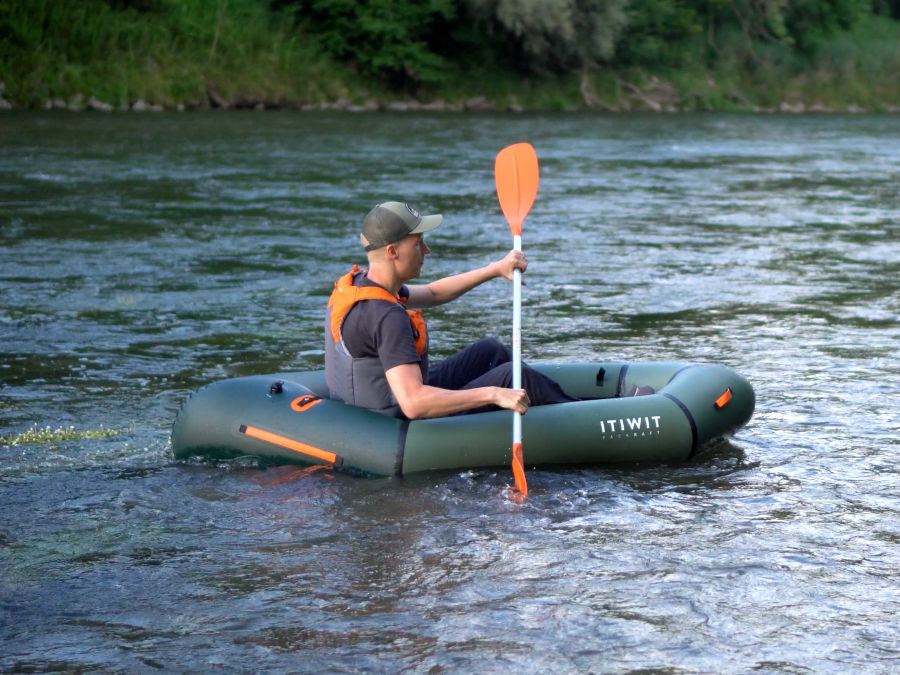
The Itiwit Packraft 100 can also be a good choice for paddling beginners. It offers namely a high tipping stability. The voluminous air tube, the flat bottom and the high hull width ensure that it is very difficult to capsize with the Packraft. As a beginner you will feel safe right away in the packraft thanks to the high tipping stability and the good seating position.
As usual with open packrafts, splashing water gets on your clothes and into the interior on longer trips. Double paddles with drip rings provide some relief here, but keep only part of the splashing water away. So in the summer it is best to paddle barefoot or with neoprene socks and shorts. Since the seat cushion is quite high, you don’t have to worry that your buttocks will quickly get wet.
In the off-season we recommend you to wear at least rain pants or better a proper cold protection in the form of a dry suit. If you often paddle in the off-season, a packraft with a spray deck might suit you better (e.g. Anfibio Rebel 2K, nortik TrekRaft Expedition). This is because a spray deck serves as protection against splashing water, rain and cold. The Itiwit Packraft 100 cannot offer you this protection without a spray deck.
Upgrading the Itiwit Packraft with a fin
We have already mentioned that the Packraft is very easy to turn. To improve the handling characteristics, the use of one or more fins is common, especially for inflatable kayaks. For some packrafts, a fin is even offered in addition. The Itiwit Packraft 100 does not have a fin and also no fin holder to attach such a fin. However, such a fin holder can be retrofitted. For example, in the Packrafting Store there is a fin holder with fin, which can also be attached to the Itiwit Packraft.
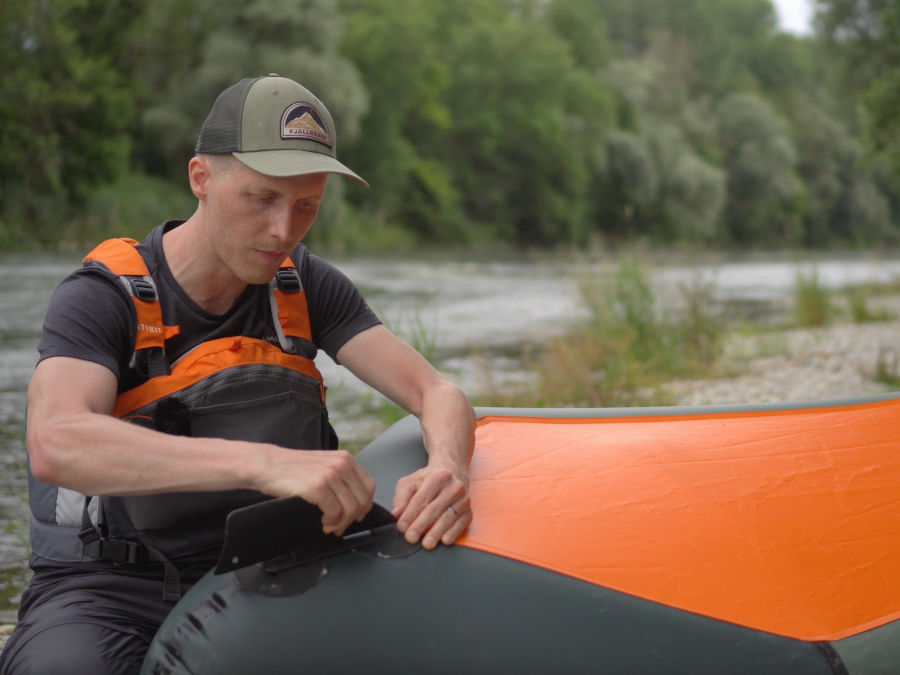
Accordingly, we bought a fin with a fin holder and attached it to the underside of the packraft. In the process, the holder is permanently attached with a 2-component adhesive. Before use on the water, the fin is then simply pushed into the holder.
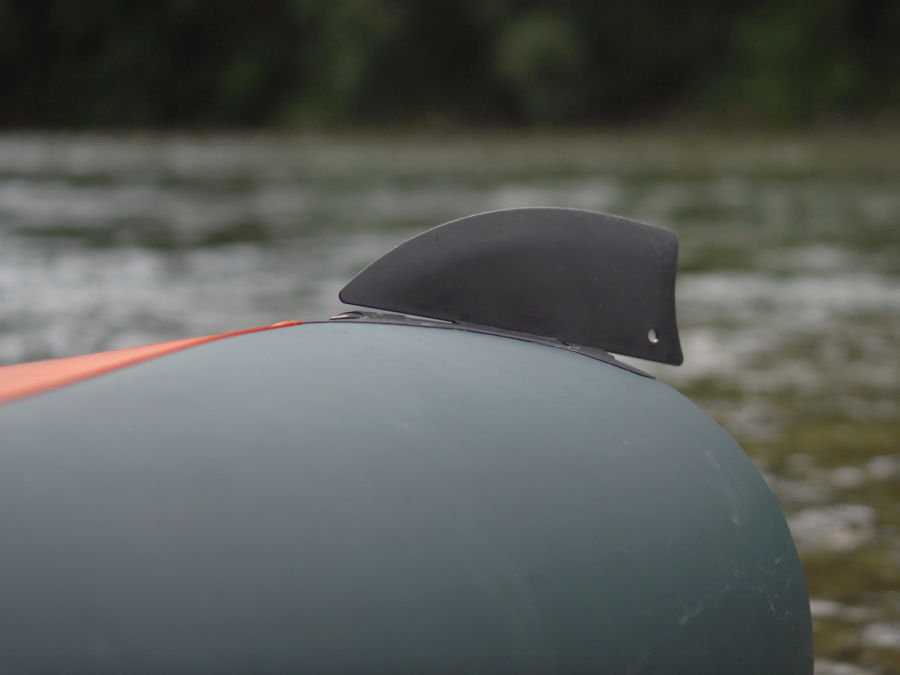
In terms of speed or straight-line paddling, the fin makes no noticeable difference. However, it does make a big difference in turning ease as soon as you stop paddling and drift. Without the fin, the boat drifts away to the side right away. With a fin, the boat stays on track and continues to glide straight ahead. Since you are not constantly paddling on the water, but also sometimes take small breaks to enjoy nature, drink something or take pictures, this improvement is a real plus. Therefore, we recommend the use of a fin on the packraft when the water is deep enough. Because if you are on a very shallow river, a fin is rather a hindrance, as you can get stuck with it.
Dismantling the packraft
Dismantling the Itiwit Packraft 100 is quick and easy, as usual with packrafts. You unscrew the valve from the thread of the packraft and release the air. A large part of the air already escapes by itself. The rest escapes during folding and rolling. On the seat, you open the valve. There is a push button here that you have to push in to be able to push the air out. Theoretically, you can leave the seat in the boat and fold the packraft that way. But we take it out and put it separately in the transport bag.
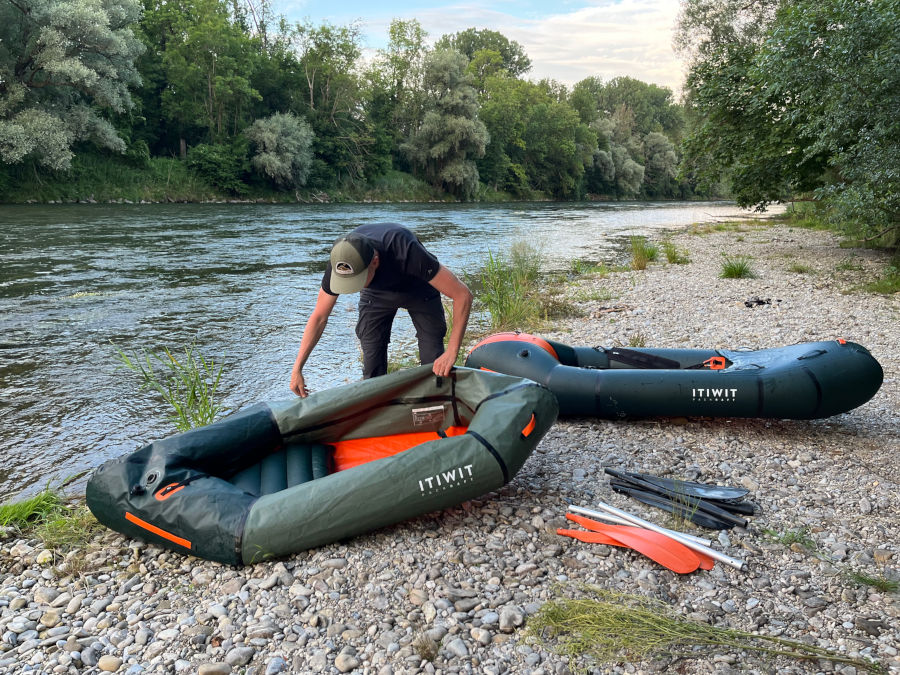
First, fold the packraft lengthwise. Make sure that it is not wider than the transport bag. Then you can roll up the packraft from the front to the rear. Afterwards you can compress the Packraft a bit with the seat strap at the rear, which also serves as a compression belt. This will prevent the packraft from unrolling on its own.
When the packraft is folded narrowly, it fits perfectly in the carry bag along with accessories and can be compressed to the original pack size.
Sometimes you just want to transport the packraft to the car and dry and fold it at home in peace. Since the transport bag is generously sized and can be varied in size by its roll closure, it is no problem to pack the packraft even in a less well compressed state. The transport bag can be closed at the top like a conventional dry bag with roll closure and can be used as a handle for transport.
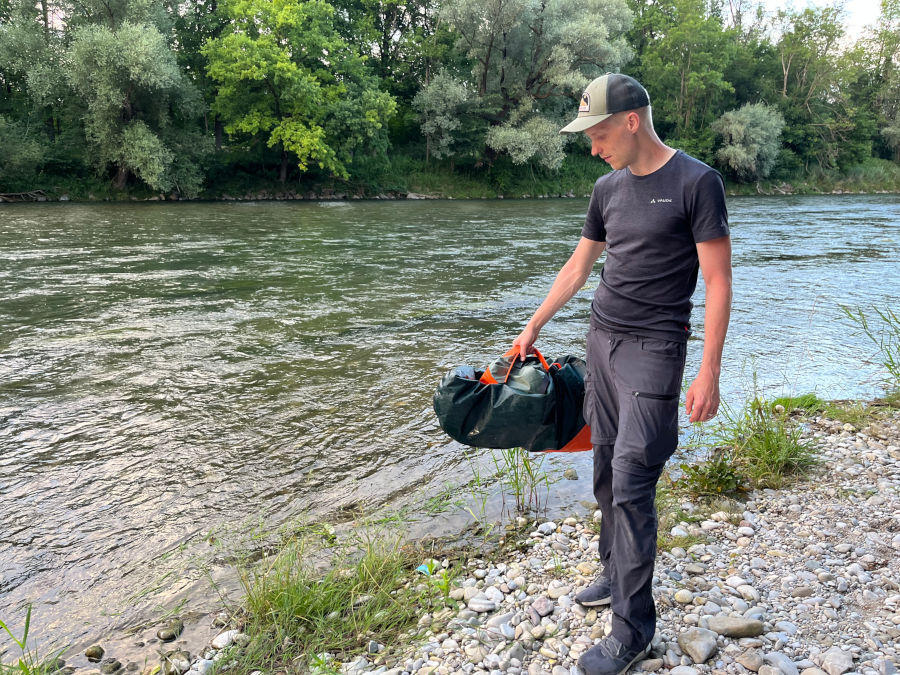
Strenghts and weaknesses of the Itiwit Packraft 100
The biggest strength of the Itiwit Packraft 100 is its attractive price-performance ratio, which makes packrafting affordable, especially for beginners. The easy assembly thanks to the pump bag is another aspect that beginners will surely enjoy. Although the packraft is offered cheaply by Decathlon, as a customer you do not have to make any compromises in terms of workmanship and material. We find that particularly good.
We could not find any major weaknesses in this packraft. With the name ultralight, with which Itiwit advertises, it may be noted that not the last gram of weight has been saved here by the pump/transport bag and the seat cushion to make it really as light as possible. Other manufacturers such as Anfibio optimize here even more in terms of weight.
Without a fin, the boat is also very easy to turn. As soon as you stop paddling, the boat turns to the left or right. However, this can be remedied by retrofitting a fin. Large paddlers should also consider whether the space in the boat will be sufficient for them in the long run.
Advantages
+ good workmanship + very good price-performance ratio + very easy and quick assembly due to the pump bag + pump bag can be used as transport and dry bag + sufficient carrying and safety handles available + good seating comfort + safe handling in calm waters (high tipping stability, high seating cushion, good maneuverability) + self-adhesive repair patches included
Disadvantages
– heavier than average equipment for an ultralight packraft (seat cushion and pack/pump bag) – very easy to turn without fin – when using shoes little legroom for tall paddlers in the long run – bottom of the side tube is little protected against high stresses – lack of attachment points on the pump/bladder bag
Conclusion on the Itiwit Packraft 100
With the Itiwit Packraft 100, Decathlon has brought a solid entry-level packraft onto the market, which is unparalleled at this price. Those who have so far given packrafts a wide berth due to the high investment costs, will find exactly the right model with the inexpensive Itiwit Packraft. It is focused on the essentials without big features to keep the price low. In addition, it is also light and compact with a total weight of about 2 kg / 4.4 lbs to benefit from the greatest advantages of a packraft. Precisely because Decathlon has not skimped on the material and workmanship, we can recommend the boat to the price-conscious beginner.
However, if you are willing to invest a little more in a packraft, you should definitely take a closer look at other packrafts and compare which boat best meets your requirements. For a little more money, Itiwit offers the Packraft Adventure 500, which also has a T-Zip for luggage stowage and is equipped with a front spray deck and thigh straps.
